Table of Contents
- Introduction
- Rack PDU Front Panel
- Command Line Interface
- Web Interface
- Status Tab
- Control
- Configuration
- Tests Tab
- Logs Tab
- About Tab
- Device IP Configuration Wizard
- How to Export Configuration Settings
- File Transfers
- Troubleshooting
APC AP8858 User Manual
Displayed below is the user manual for AP8858 by APC which is a product in the Power Distribution Units (PDUs) category. This manual has pages.
Related Manuals

User Guide
Rack Power Distribution Unit
Metered
AP88XX
990-5568B-001
Publication Date: December, 2015

Schneider Electric IT Corporation Legal Disclaimer
The information presented in this manual is not warranted by the Schneider Electric IT Corporation to be
authoritative, error free, or complete. This publication is not meant to be a substitute for a detailed operational
and site specific development plan. Therefore, Schneider Electric IT Corporation assumes no liability for
damages, violations of codes, improper installation, system failures, or any other problems that could arise
based on the use of this Publication.
The information contained in this Publication is provided as is and has been prepared solely for the purpose of
evaluating data center design and con structio n. This Publication ha s bee n compiled in g ood faith b y Schneid er
Electric IT Corporation. However, no representation is made or warranty given, either express or implied, as to
the completene ss or accu ra cy of the inform at ion this Pub lica tio n co ntains.
IN NO EVENT SHALL SCHNEIDER ELECTRIC IT CORPORATION, OR ANY PARENT, AFFILIATE OR
SUBSIDIARY COMPANY OF SCHNEIDER ELECTRIC IT CORPORATION OR THEIR RESPECTIVE
OFFICERS, DIRECTORS, OR EMPLOYEES BE LIABLE FOR ANY DIRECT, INDIRECT, CONSEQUENTIAL,
PUNITIVE, SPECIAL, OR INCIDENTAL DAMAGES (INCLUDING, WITHOUT LIMITATION, DAMAGES FOR
LOSS OF BUSINESS, CONTRACT, REVENUE, DATA, INFORMATION, OR BUSINESS INTERRUPTION)
RESULTING FROM, ARISING OUT, OR IN CONNECTION WITH THE USE OF, OR INABILITY TO USE THIS
PUBLICATION OR THE CONTENT, EVEN IF SCHNEIDER ELECTRIC IT CORPORATION HAS BEEN
EXPRESSLY ADVISED OF THE POSSIBILITY OF SUCH DAMAGES. SCHNEIDER ELECTRIC IT
CORPORATION RESERVES THE RIGHT TO MAKE CHANGES OR UPDATES WITH RESPECT TO OR IN
THE CONTENT OF THE PUBLICATION OR THE FORMAT THEREOF AT ANY TIME WITHOUT NOTICE.
Copyright, intellectual, an d all other propriet ary rights in the content (includ ing but not limited to sof tware, audio,
video, text, and photographs) rests with Schneider Electric It Corporation or its licensors. All rights in the
content not expressly granted herein are reserved. No rights of any kind are licensed or assigned or shall
otherwise pass to persons accessing this information.
This Publication shall not be for resale in whole or in part.

Contents
Metered Rack PDU i
Introduction ....................................................................... 1
Product Features. . . . . . . . . . . . . . . . . . . . . . . . . . . . . . . . . . . . . . . . . . .1
Types of User Accounts . . . . . . . . . . . . . . . . . . . . . . . . . . . . . . . . . . . . .2
Watchdog Features. . . . . . . . . . . . . . . . . . . . . . . . . . . . . . . . . . . . . . . . .3
Overview . . . . . . . . . . . . . . . . . . . . . . . . . . . . . . . . . . . . . . . . . . . . . . . . 3
Network interface watchdog mechanism . . . . . . . . . . . . . . . . . . . . . . . 3
Resetting the network timer . . . . . . . . . . . . . . . . . . . . . . . . . . . . . . . . . 3
Network Port Sharing (NPS) . . . . . . . . . . . . . . . . . . . . . . . . . . . . . . . . . .3
About the Network Port Sharing Feature . . . . . . . . . . . . . . . . . . . . . . . 3
Display ID . . . . . . . . . . . . . . . . . . . . . . . . . . . . . . . . . . . . . . . . . . . . . . . 3
Installation Instructions . . . . . . . . . . . . . . . . . . . . . . . . . . . . . . . . . . . . . 3
Specific assignment of Display IDs . . . . . . . . . . . . . . . . . . . . . . . . . . . . 4
Firmware Upgrade with NPS. . . . . . . . . . . . . . . . . . . . . . . . . . . . . . . . . .4
RF Tag . . . . . . . . . . . . . . . . . . . . . . . . . . . . . . . . . . . . . . . . . . . . . . . . . .5
EnergyWise. . . . . . . . . . . . . . . . . . . . . . . . . . . . . . . . . . . . . . . . . . . . . . .5
EnergyWise and NPS . . . . . . . . . . . . . . . . . . . . . . . . . . . . . . . . . . . . . . .6
Getting Started . . . . . . . . . . . . . . . . . . . . . . . . . . . . . . . . . . . . . . . . . . . .6
Establish Network Settings . . . . . . . . . . . . . . . . . . . . . . . . . . . . . . . . . . .7
IPv4 initial setup . . . . . . . . . . . . . . . . . . . . . . . . . . . . . . . . . . . . . . . . . . 7
IPv6 initial setup . . . . . . . . . . . . . . . . . . . . . . . . . . . . . . . . . . . . . . . . . . 7
TCP/IP configuration methods . . . . . . . . . . . . . . . . . . . . . . . . . . . . . . . 7
.ini file utility . . . . . . . . . . . . . . . . . . . . . . . . . . . . . . . . . . . . . . . . . . . . . 7
DHCP and BOOTP configuration . . . . . . . . . . . . . . . . . . . . . . . . . . . . . 7
Network Management with Other Applications . . . . . . . . . . . . . . . . . . . 8
Command Line Interface (CLI) . . . . . . . . . . . . . . . . . . . . . . . . . . . . . . . 9
Recovering from a Lost Password . . . . . . . . . . . . . . . . . . . . . . . . . . . .10
Rack PDU Front Panel.................................................... 11
Network Status LED . . . . . . . . . . . . . . . . . . . . . . . . . . . . . . . . . . . . . . 13
10/100 LED . . . . . . . . . . . . . . . . . . . . . . . . . . . . . . . . . . . . . . . . . . . . . 13
Load indicator LED . . . . . . . . . . . . . . . . . . . . . . . . . . . . . . . . . . . . . . . 13
Example 1 . . . . . . . . . . . . . . . . . . . . . . . . . . . . . . . . . . . . . . . . . . . . . . 14
Example 2 . . . . . . . . . . . . . . . . . . . . . . . . . . . . . . . . . . . . . . . . . . . . . . 15
Example 3 . . . . . . . . . . . . . . . . . . . . . . . . . . . . . . . . . . . . . . . . . . . . . . 16
Example 4 . . . . . . . . . . . . . . . . . . . . . . . . . . . . . . . . . . . . . . . . . . . . . . 17
Command Line Interface................................................. 18
About the Command Line Interface (CLI) . . . . . . . . . . . . . . . . . . . . . . .18
Log on to the CLI. . . . . . . . . . . . . . . . . . . . . . . . . . . . . . . . . . . . . . . . . .18
Remote access to the command line interface . . . . . . . . . . . . . . . . . . 18
Telnet for basic access . . . . . . . . . . . . . . . . . . . . . . . . . . . . . . . . . . . . 19
SSH for high-security access . . . . . . . . . . . . . . . . . . . . . . . . . . . . . . . 19
Local access to the command line interface . . . . . . . . . . . . . . . . . . . . 19

Metered Rack PDU ii
About the Main Screen . . . . . . . . . . . . . . . . . . . . . . . . . . . . . . . . . . . . .20
Using the CLI . . . . . . . . . . . . . . . . . . . . . . . . . . . . . . . . . . . . . . . . . . . .21
Command Syntax . . . . . . . . . . . . . . . . . . . . . . . . . . . . . . . . . . . . . . . . .22
Command Response Codes. . . . . . . . . . . . . . . . . . . . . . . . . . . . . . . . .23
Network Management Card Command Descriptions . . . . . . . . . . . . . .24
? or help . . . . . . . . . . . . . . . . . . . . . . . . . . . . . . . . . . . . . . . . . . . . . . . 24
about . . . . . . . . . . . . . . . . . . . . . . . . . . . . . . . . . . . . . . . . . . . . . . . . . . 25
alarmcount . . . . . . . . . . . . . . . . . . . . . . . . . . . . . . . . . . . . . . . . . . . . . 25
boot . . . . . . . . . . . . . . . . . . . . . . . . . . . . . . . . . . . . . . . . . . . . . . . . . . . 26
bye . . . . . . . . . . . . . . . . . . . . . . . . . . . . . . . . . . . . . . . . . . . . . . . . . . . 26
cd . . . . . . . . . . . . . . . . . . . . . . . . . . . . . . . . . . . . . . . . . . . . . . . . . . . . 27
clrrst . . . . . . . . . . . . . . . . . . . . . . . . . . . . . . . . . . . . . . . . . . . . . . . . . . 27
console . . . . . . . . . . . . . . . . . . . . . . . . . . . . . . . . . . . . . . . . . . . . . . . . 27
date . . . . . . . . . . . . . . . . . . . . . . . . . . . . . . . . . . . . . . . . . . . . . . . . . . . 28
delete . . . . . . . . . . . . . . . . . . . . . . . . . . . . . . . . . . . . . . . . . . . . . . . . . 28
dir . . . . . . . . . . . . . . . . . . . . . . . . . . . . . . . . . . . . . . . . . . . . . . . . . . . . 29
dns . . . . . . . . . . . . . . . . . . . . . . . . . . . . . . . . . . . . . . . . . . . . . . . . . . . 29
email . . . . . . . . . . . . . . . . . . . . . . . . . . . . . . . . . . . . . . . . . . . . . . . . . . 30
eventlog . . . . . . . . . . . . . . . . . . . . . . . . . . . . . . . . . . . . . . . . . . . . . . . 31
exit or quit . . . . . . . . . . . . . . . . . . . . . . . . . . . . . . . . . . . . . . . . . . . . . . 32
firewall . . . . . . . . . . . . . . . . . . . . . . . . . . . . . . . . . . . . . . . . . . . . . . . . . 32
format . . . . . . . . . . . . . . . . . . . . . . . . . . . . . . . . . . . . . . . . . . . . . . . . . 32
ftp . . . . . . . . . . . . . . . . . . . . . . . . . . . . . . . . . . . . . . . . . . . . . . . . . . . . 33
help . . . . . . . . . . . . . . . . . . . . . . . . . . . . . . . . . . . . . . . . . . . . . . . . . . . 33
lang . . . . . . . . . . . . . . . . . . . . . . . . . . . . . . . . . . . . . . . . . . . . . . . . . . . 33
lastrst . . . . . . . . . . . . . . . . . . . . . . . . . . . . . . . . . . . . . . . . . . . . . . . . . 34
ledblink . . . . . . . . . . . . . . . . . . . . . . . . . . . . . . . . . . . . . . . . . . . . . . . . 34
logzip . . . . . . . . . . . . . . . . . . . . . . . . . . . . . . . . . . . . . . . . . . . . . . . . . 34
netstat . . . . . . . . . . . . . . . . . . . . . . . . . . . . . . . . . . . . . . . . . . . . . . . . . 35
ntp . . . . . . . . . . . . . . . . . . . . . . . . . . . . . . . . . . . . . . . . . . . . . . . . . . . . 35
ping . . . . . . . . . . . . . . . . . . . . . . . . . . . . . . . . . . . . . . . . . . . . . . . . . . . 36
portSpeed . . . . . . . . . . . . . . . . . . . . . . . . . . . . . . . . . . . . . . . . . . . . . . 36
prompt . . . . . . . . . . . . . . . . . . . . . . . . . . . . . . . . . . . . . . . . . . . . . . . . . 37
pwd . . . . . . . . . . . . . . . . . . . . . . . . . . . . . . . . . . . . . . . . . . . . . . . . . . . 37
radius . . . . . . . . . . . . . . . . . . . . . . . . . . . . . . . . . . . . . . . . . . . . . . . . . 38
reboot . . . . . . . . . . . . . . . . . . . . . . . . . . . . . . . . . . . . . . . . . . . . . . . . . 39
resetToDef . . . . . . . . . . . . . . . . . . . . . . . . . . . . . . . . . . . . . . . . . . . . . 39
session . . . . . . . . . . . . . . . . . . . . . . . . . . . . . . . . . . . . . . . . . . . . . . . . 40
smtp . . . . . . . . . . . . . . . . . . . . . . . . . . . . . . . . . . . . . . . . . . . . . . . . . . 40
snmp . . . . . . . . . . . . . . . . . . . . . . . . . . . . . . . . . . . . . . . . . . . . . . . . . . 41
snmpv3 . . . . . . . . . . . . . . . . . . . . . . . . . . . . . . . . . . . . . . . . . . . . . . . . 41
snmptrap . . . . . . . . . . . . . . . . . . . . . . . . . . . . . . . . . . . . . . . . . . . . . . . 42
system . . . . . . . . . . . . . . . . . . . . . . . . . . . . . . . . . . . . . . . . . . . . . . . . 42
tcpip . . . . . . . . . . . . . . . . . . . . . . . . . . . . . . . . . . . . . . . . . . . . . . . . . . 43
tcpip6 . . . . . . . . . . . . . . . . . . . . . . . . . . . . . . . . . . . . . . . . . . . . . . . . . 43
user . . . . . . . . . . . . . . . . . . . . . . . . . . . . . . . . . . . . . . . . . . . . . . . . . . . 44
userdflt . . . . . . . . . . . . . . . . . . . . . . . . . . . . . . . . . . . . . . . . . . . . . . . . 45
web . . . . . . . . . . . . . . . . . . . . . . . . . . . . . . . . . . . . . . . . . . . . . . . . . . . 46
whoami . . . . . . . . . . . . . . . . . . . . . . . . . . . . . . . . . . . . . . . . . . . . . . . . 46
xferINI . . . . . . . . . . . . . . . . . . . . . . . . . . . . . . . . . . . . . . . . . . . . . . . . . 47
xferStatus . . . . . . . . . . . . . . . . . . . . . . . . . . . . . . . . . . . . . . . . . . . . . . 47

Metered Rack PDU iii
Device Command Descriptions. . . . . . . . . . . . . . . . . . . . . . . . . . . . . . .48
Network Port Sharing Commands . . . . . . . . . . . . . . . . . . . . . . . . . . . 48
bkLowLoad . . . . . . . . . . . . . . . . . . . . . . . . . . . . . . . . . . . . . . . . . . . . . 48
bkNearOver . . . . . . . . . . . . . . . . . . . . . . . . . . . . . . . . . . . . . . . . . . . . 49
bkOverLoad . . . . . . . . . . . . . . . . . . . . . . . . . . . . . . . . . . . . . . . . . . . . 49
bkReading . . . . . . . . . . . . . . . . . . . . . . . . . . . . . . . . . . . . . . . . . . . . . . 50
devLowLoad . . . . . . . . . . . . . . . . . . . . . . . . . . . . . . . . . . . . . . . . . . . . 51
devNearOver . . . . . . . . . . . . . . . . . . . . . . . . . . . . . . . . . . . . . . . . . . . 51
devOverLoad . . . . . . . . . . . . . . . . . . . . . . . . . . . . . . . . . . . . . . . . . . . 51
devReading . . . . . . . . . . . . . . . . . . . . . . . . . . . . . . . . . . . . . . . . . . . . . 52
dispID . . . . . . . . . . . . . . . . . . . . . . . . . . . . . . . . . . . . . . . . . . . . . . . . . 52
energyWise . . . . . . . . . . . . . . . . . . . . . . . . . . . . . . . . . . . . . . . . . . . . . 53
humHyst . . . . . . . . . . . . . . . . . . . . . . . . . . . . . . . . . . . . . . . . . . . . . . . 55
humLow . . . . . . . . . . . . . . . . . . . . . . . . . . . . . . . . . . . . . . . . . . . . . . . 55
humMin . . . . . . . . . . . . . . . . . . . . . . . . . . . . . . . . . . . . . . . . . . . . . . . . 56
humReading . . . . . . . . . . . . . . . . . . . . . . . . . . . . . . . . . . . . . . . . . . . . 56
lcd . . . . . . . . . . . . . . . . . . . . . . . . . . . . . . . . . . . . . . . . . . . . . . . . . . . . 56
lcdBlink . . . . . . . . . . . . . . . . . . . . . . . . . . . . . . . . . . . . . . . . . . . . . . . . 57
phLowLoad . . . . . . . . . . . . . . . . . . . . . . . . . . . . . . . . . . . . . . . . . . . . . 57
phNearOver . . . . . . . . . . . . . . . . . . . . . . . . . . . . . . . . . . . . . . . . . . . . 58
phOverLoad . . . . . . . . . . . . . . . . . . . . . . . . . . . . . . . . . . . . . . . . . . . . 58
phReading . . . . . . . . . . . . . . . . . . . . . . . . . . . . . . . . . . . . . . . . . . . . . 59
phTophVolts . . . . . . . . . . . . . . . . . . . . . . . . . . . . . . . . . . . . . . . . . . . . 59
prodInfo . . . . . . . . . . . . . . . . . . . . . . . . . . . . . . . . . . . . . . . . . . . . . . . . 60
sensorName . . . . . . . . . . . . . . . . . . . . . . . . . . . . . . . . . . . . . . . . . . . . 60
tempHigh . . . . . . . . . . . . . . . . . . . . . . . . . . . . . . . . . . . . . . . . . . . . . . 61
tempHyst . . . . . . . . . . . . . . . . . . . . . . . . . . . . . . . . . . . . . . . . . . . . . . . 61
tempMax . . . . . . . . . . . . . . . . . . . . . . . . . . . . . . . . . . . . . . . . . . . . . . . 62
tempReading . . . . . . . . . . . . . . . . . . . . . . . . . . . . . . . . . . . . . . . . . . . 62
Web Interface.................................................................. 63
Supported Web Browsers . . . . . . . . . . . . . . . . . . . . . . . . . . . . . . . . . . .63
Logging On to the Web Interface . . . . . . . . . . . . . . . . . . . . . . . . . . . . .63
Overview . . . . . . . . . . . . . . . . . . . . . . . . . . . . . . . . . . . . . . . . . . . . . . . 63
URL address formats . . . . . . . . . . . . . . . . . . . . . . . . . . . . . . . . . . . . . 64
Web Interface Features. . . . . . . . . . . . . . . . . . . . . . . . . . . . . . . . . . . . .65
Tabs . . . . . . . . . . . . . . . . . . . . . . . . . . . . . . . . . . . . . . . . . . . . . . . . . . 65
Device status icons . . . . . . . . . . . . . . . . . . . . . . . . . . . . . . . . . . . . . . . 66
Quick Links . . . . . . . . . . . . . . . . . . . . . . . . . . . . . . . . . . . . . . . . . . . . . 66
Network Port Sharing (NPS) on the Web User Interface (UI) . . . . . . . .67
Group Control using Network Port Sharing . . . . . . . . . . . . . . . . . . . . 67
About Home . . . . . . . . . . . . . . . . . . . . . . . . . . . . . . . . . . . . . . . . . . . . .68
The Overview view . . . . . . . . . . . . . . . . . . . . . . . . . . . . . . . . . . . . . . . 68

Metered Rack PDUiv
Status Tab....................................................................... 69
About the Status Tab . . . . . . . . . . . . . . . . . . . . . . . . . . . . . . . . . . . . . .69
View the Load Status and Peak Load . . . . . . . . . . . . . . . . . . . . . . . . . 70
View the Network Status . . . . . . . . . . . . . . . . . . . . . . . . . . . . . . . . . . . 70
Current IPv4 Settings . . . . . . . . . . . . . . . . . . . . . . . . . . . . . . . . . . . . . 70
Current IPv6 Settings . . . . . . . . . . . . . . . . . . . . . . . . . . . . . . . . . . . . . 70
Domain Name System Status . . . . . . . . . . . . . . . . . . . . . . . . . . . . . . . 70
Ethernet Port Speed . . . . . . . . . . . . . . . . . . . . . . . . . . . . . . . . . . . . . . 70
Control............................................................................. 71
Managing User Sessions . . . . . . . . . . . . . . . . . . . . . . . . . . . . . . . . . . .71
Resetting the Network Interface . . . . . . . . . . . . . . . . . . . . . . . . . . . . . .71
Configuration................................................................... 72
About the Configuration Tab . . . . . . . . . . . . . . . . . . . . . . . . . . . . . . . . .72
Configure Load Thresholds. . . . . . . . . . . . . . . . . . . . . . . . . . . . . . . . . .73
To configure load thresholds . . . . . . . . . . . . . . . . . . . . . . . . . . . . . . . 73
Configure RPDU Name and Location . . . . . . . . . . . . . . . . . . . . . . . . . .73
Reset Peak Load and kWh . . . . . . . . . . . . . . . . . . . . . . . . . . . . . . . . . .73
Configure Temperature and Humidity Sensors. . . . . . . . . . . . . . . . . . .74
Security. . . . . . . . . . . . . . . . . . . . . . . . . . . . . . . . . . . . . . . . . . . . . . . . .75
Session Management screen . . . . . . . . . . . . . . . . . . . . . . . . . . . . . . . 75
Ping Response . . . . . . . . . . . . . . . . . . . . . . . . . . . . . . . . . . . . . . . . . . 75
Local Users . . . . . . . . . . . . . . . . . . . . . . . . . . . . . . . . . . . . . . . . . . . . . 75
Remote Users . . . . . . . . . . . . . . . . . . . . . . . . . . . . . . . . . . . . . . . . . . . 77
Configure the RADIUS Server . . . . . . . . . . . . . . . . . . . . . . . . . . . . . . 78
Supported RADIUS servers . . . . . . . . . . . . . . . . . . . . . . . . . . . . . . . . 78
RADIUS and Network Port Sharing . . . . . . . . . . . . . . . . . . . . . . . . . . 78
Firewall Menus . . . . . . . . . . . . . . . . . . . . . . . . . . . . . . . . . . . . . . . . . . 79
Network Features . . . . . . . . . . . . . . . . . . . . . . . . . . . . . . . . . . . . . . . . .80
TCP/IP and Communication Settings . . . . . . . . . . . . . . . . . . . . . . . . . 80
Port Speed . . . . . . . . . . . . . . . . . . . . . . . . . . . . . . . . . . . . . . . . . . . . . 82
DNS . . . . . . . . . . . . . . . . . . . . . . . . . . . . . . . . . . . . . . . . . . . . . . . . . . 83
Web . . . . . . . . . . . . . . . . . . . . . . . . . . . . . . . . . . . . . . . . . . . . . . . . . . 84
Console . . . . . . . . . . . . . . . . . . . . . . . . . . . . . . . . . . . . . . . . . . . . . . . . 85
SNMP . . . . . . . . . . . . . . . . . . . . . . . . . . . . . . . . . . . . . . . . . . . . . . . . . 86
SNMPv1 . . . . . . . . . . . . . . . . . . . . . . . . . . . . . . . . . . . . . . . . . . . . . . . 87
SNMPv3 . . . . . . . . . . . . . . . . . . . . . . . . . . . . . . . . . . . . . . . . . . . . . . . 88
FTP Server . . . . . . . . . . . . . . . . . . . . . . . . . . . . . . . . . . . . . . . . . . . . . 89
Notifications. . . . . . . . . . . . . . . . . . . . . . . . . . . . . . . . . . . . . . . . . . . . . .90
Event Actions . . . . . . . . . . . . . . . . . . . . . . . . . . . . . . . . . . . . . . . . . . . 90
Configure event actions . . . . . . . . . . . . . . . . . . . . . . . . . . . . . . . . . . . 90
E-mail notification screens . . . . . . . . . . . . . . . . . . . . . . . . . . . . . . . . . 92
SNMP trap receiver screen . . . . . . . . . . . . . . . . . . . . . . . . . . . . . . . . . 94
SNMP traps test screen . . . . . . . . . . . . . . . . . . . . . . . . . . . . . . . . . . . 95
Remote Monitoring Service . . . . . . . . . . . . . . . . . . . . . . . . . . . . . . . . 95

Metered Rack PDU v
General Menu . . . . . . . . . . . . . . . . . . . . . . . . . . . . . . . . . . . . . . . . . . . .96
Identification screen . . . . . . . . . . . . . . . . . . . . . . . . . . . . . . . . . . . . . . 96
Date/Time screen . . . . . . . . . . . . . . . . . . . . . . . . . . . . . . . . . . . . . . . . 96
Creating and importing settings with the config file . . . . . . . . . . . . . . 97
Configure Links . . . . . . . . . . . . . . . . . . . . . . . . . . . . . . . . . . . . . . . . . . 97
Logs in the Configuration Menu . . . . . . . . . . . . . . . . . . . . . . . . . . . . . .98
Identifying Syslog servers . . . . . . . . . . . . . . . . . . . . . . . . . . . . . . . . . . 98
Syslog settings . . . . . . . . . . . . . . . . . . . . . . . . . . . . . . . . . . . . . . . . . . 98
Syslog test and format example . . . . . . . . . . . . . . . . . . . . . . . . . . . . . 99
Tests Tab ...................................................................... 100
Setting the RPDU LCD or LED Lights to Blink . . . . . . . . . . . . . . . . . .100
Logs Tab ....................................................................... 101
Event, Data and Firewall Logs . . . . . . . . . . . . . . . . . . . . . . . . . . . . . .101
Event log . . . . . . . . . . . . . . . . . . . . . . . . . . . . . . . . . . . . . . . . . . . . . . 102
Data log . . . . . . . . . . . . . . . . . . . . . . . . . . . . . . . . . . . . . . . . . . . . . . 103
Firewall Logs . . . . . . . . . . . . . . . . . . . . . . . . . . . . . . . . . . . . . . . . . . . 105
Use FTP or SCP to retrieve log files . . . . . . . . . . . . . . . . . . . . . . . . . 105
About Tab...................................................................... 107
About the Rack PDU. . . . . . . . . . . . . . . . . . . . . . . . . . . . . . . . . . . . . .107
Device IP Configuration Wizard .................................... 108
Capabilities, Requirements, and Installation. . . . . . . . . . . . . . . . . . . . 108
How to use the Wizard to configure TCP/IP settings . . . . . . . . . . . . 108
System requirements . . . . . . . . . . . . . . . . . . . . . . . . . . . . . . . . . . . . 108
Installation . . . . . . . . . . . . . . . . . . . . . . . . . . . . . . . . . . . . . . . . . . . . . 108
How to Export Configuration Settings ........................... 109
Retrieving and Exporting the .ini File . . . . . . . . . . . . . . . . . . . . . . . . .109
Summary of the procedure . . . . . . . . . . . . . . . . . . . . . . . . . . . . . . . . 109
Contents of the .ini file . . . . . . . . . . . . . . . . . . . . . . . . . . . . . . . . . . . 109
.ini and Network Port Sharing . . . . . . . . . . . . . . . . . . . . . . . . . . . . . . 109
Detailed procedures . . . . . . . . . . . . . . . . . . . . . . . . . . . . . . . . . . . . . 110
The Upload Event and Error Messages . . . . . . . . . . . . . . . . . . . . . . .112
The event and its error messages . . . . . . . . . . . . . . . . . . . . . . . . . . 112
Messages in config.ini . . . . . . . . . . . . . . . . . . . . . . . . . . . . . . . . . . . 112
Errors generated by overridden values . . . . . . . . . . . . . . . . . . . . . . . 11 2
Related Topics . . . . . . . . . . . . . . . . . . . . . . . . . . . . . . . . . . . . . . . . . .112
File Transfers................................................................ 113
Upgrading Firmware . . . . . . . . . . . . . . . . . . . . . . . . . . . . . . . . . . . . . .113
Benefits of upgrading firmware . . . . . . . . . . . . . . . . . . . . . . . . . . . . . 113
Firmware module files (Rack PDU) . . . . . . . . . . . . . . . . . . . . . . . . . . 113

Metered Rack PDUvi
Firmware File Transfer Methods. . . . . . . . . . . . . . . . . . . . . . . . . . . . . 114
Using the Firmware Upgrade Utility . . . . . . . . . . . . . . . . . . . . . . . . . . 114
Use FTP or SCP to upgrade one Rack PDU . . . . . . . . . . . . . . . . . . . 115
Use XMODEM to upgrade one Rack PDU . . . . . . . . . . . . . . . . . . . . 116
Use a USB drive to transfer and upgrade the files . . . . . . . . . . . . . . 116
How to upgrade multiple RPDUs . . . . . . . . . . . . . . . . . . . . . . . . . . . . 117
Using the Firmware Upgrade Utility for multiple up grades . . . . . . . . 117
Updating firmware for Network Port Sharing (NPS) Groups . . . . . . . 117
Verifying Upgrades and Updates . . . . . . . . . . . . . . . . . . . . . . . . . . . . 118
Verify the success or failure of the transfer . . . . . . . . . . . . . . . . . . . . 118
Last Transfer Result codes . . . . . . . . . . . . . . . . . . . . . . . . . . . . . . . . 118
Verify the version numbers of installed firmware. . . . . . . . . . . . . . . . 118
Troubleshooting.............................................................119
Rack PDU Access Problems . . . . . . . . . . . . . . . . . . . . . . . . . . . . . . . 119
SNMP Issues . . . . . . . . . . . . . . . . . . . . . . . . . . . . . . . . . . . . . . . . . . . 121

1 Metered Rack PDU
Introduction
Product Features
The Schneider Electric Metered Rack Power Distribution Unit (PDU) may be used as a st a nd-alone,
network-manageable power distribution device or up to four devices can be connected together with
one network connection. The Rack PDU provides real-time remote monitoring of connected loads.
User-defined alarms warn of potential circuit overloads.
Your AP88xx Metered Rack PDU comes with a terminator installed in the display In or Out port. To
use Network Port Sharing between up to four units, a terminator must be installed in the In port at
one end of the group and another on the Out port at the other end of the group.
You can manage a Rack PDU through its web interface (UI), its command line interface (CLI),
StruxureW are, or Simple Network Manageme nt Protocol (SNMP). (To use t he PowerNet MIB with an
SNMP browser, see the PowerNet SNMP Management Information Base (MIB) Reference Guide,
available at www.schneider-electric.com.) Rack PDUs have these additional features:
• Device power, peak power, apparent power, power factor and energy.
• Phase voltage, current, peak current, power, apparent power and power factor.
• Bank current and peak current (for models that support breaker banks).
• Configurable alarm thresholds that provide network and visual alarms to help avoid
overloaded circuits.
• Various levels of access: Super User, Administrator, Device User, Read-Only, and
Network-Only User (These are protected by user name and password requirements).
• Multiple user login feature which allows up to four users to be logged in simultaneously.
• Event and data logging. The event log is accessible by Telnet, Secure CoPy (SCP), File
Transfer Protocol (FTP), serial connection, or web browser (using HTTPS access with
SSL, or using HTTP access). The data log is accessible by web browser, SCP, or FTP.
• E-mail notifications for Rack PDU and Network Management Card (NMC) system
events.
• SNMP traps, Syslog messages, and e-mail notifications based on the severity level or
category of the Rack PDU and NMC system event.
• Security protocols for authentication and encryption.
• Network Port Sharing (NPS). Up to four Rack PDUs of any model can be connected
using the In and Out ports so that only one network connection is necessary.
• NPS guest firmware auto-update feature allows the NPS host to automatically pass a
firmware update to its connected guest s. This f eature will be fu nctional for all gu est s that
have AOS firmware version 6.1.3 or later.
• RF Code wireless monitoring support via serial port connection
• Cisco EnergyWise certified.
Note: The Rack PDU does not provide power surge protection. To ensure that the device is
protected from power failure or power surges, connect the Rack PDU to a Schneider Electric
Uninterruptible Power Supply (UPS).

Metered Rack PDU2
Types of User Accounts
The Rack PDU has various levels of access (Super User, Administrator, Device User, Read-Only
User, and Network-Only Use r), which are protected by user name and password requirement s. Up to
four users are allowed to login to the same Rack PDU simulta neously (available in AOS version 6.1.3
or later).
• An Administrator or the Super User can use all of the menus in the UI and all of the
commands in the CLI. Administrator user types can be deleted, but the Super User
cannot be deleted. The default user name and password for the Super User are both
apc.
– The Super User or Administrator can manage another Administrator's account
(enable, disable, change password, etc).
• A Device User has read and write access to device-related screens. Administrative
functions like session management under the Security menu and Firewall under Logs
are grayed out.
• A Read-Only User has access to the same menus as a Device User, but without the
capability to change configurations, control devices, delete data, or use file transfer
options. Links to configuration options are visible but disabled. The event and data logs
display no button to clear the log.
• A Network-Only User can only log on using the Web UI and CLI (telnet, not serial). A
network-only user has read/right access to the network related menus only.

3 Metered Rack PDU
Watchdog Features
Overview
To detect internal problems and recover from unanticipated inputs, the Rack PDU uses internal,
system-wide watchdog mechanisms. When it restarts to recover from an internal problem, a
Network Interface Restarted event is recorded in the event log.
Network interface watchdog mechanism
The Rack PDU implements internal watchdog mechanisms to protect itself from becoming
inaccessible over the network. For example, if the Rack PDU does not receive any network traf fic f or
9.5 minutes (either direct traffic, such as SNMP, or broadcast traffic, such as an Address Resolution
Protocol [ARP] request), it assumes that there is a problem with its network interface and restarts.
The network interface watchdog mechanism is only enabled on a PDU that discovers and active
network interface connection at start-up. This allows guest PDUs in a Network Port Sharing chain to
function normally without rebooting every 9.5 minutes.
Resetting the network timer
To ensure that the Rack PDU does not restart if the network is quiet for 9.5 minutes, the Rack PDU
attempts to contact the default gateway every 4.5 minutes. If the gateway is present, it responds to
the Rack PDU, and the response rest arts the 9.5-minute timer. If your applicatio n does not require or
have a gateway, specify the IP address of a computer that is running on the network and is on the
same subnet. The network traffic of that computer will restart the 9.5-minute time frequently enough
to prevent the Rack PDU from restarting.
Network Port Sharing (NPS)
About the Network Port Sharing Feature
You can use the Network Port Sharing feature to view the status of and con figure and manage up to
four Rack PDUs using only one network connection. This is made possible by connecting the Rack
PDUs via the In and Out ports on the Rack PDU front panel.
Note: All Rack PDUs in the group must be using the same Rack PDU firmware revision, 5.1.5 or
later (excluding v6.0.5 EnergyWise), in order to support the Network Port Sharing Feature.
Display ID
The display ID is a number, 1 to 4, used to uniquely identify the Rack PDUs in a group. After two or
more Rack PDUs are connected to one another in an NPS group, they can be identified on the
various interfaces by the use of this "Display ID". This Display ID is viewable in the top left corner of
the display. Alternatively, a larger Display ID “shadow” can be enabled on the LCD by selecting the
Display Settings > Display ID > Show option on the LCD keypad.
Installation Instructions
Connect up to four Rack PDUs via the In and Out ports on the Rack PDU. Insert an RJ45 terminator
(included) in the unused In/Out ports on each end of the chain.
Note: Failure to use terminators may cause a loss of communication on the Rack PDUs.
Note: To reduce the possibility of communication issues, the maximum total length of cabling
connecting Rack PDUs in a group should not exceed 10 meters. All Rack PDUs in a NPS group
should reside in the same rack enclosure.

Metered Rack PDU4
Connect the "Network" port of one of the grouped Rack PDUs to a network hub or switch. This unit
will be the Host for the Rack PDU group. Guest PDU data will be viewable on the Host PDU. Set up
network functionality for this Host Rack PDU as specified in the Establish Network Settings section.
The Host will automatically discover any Guest PDUs connected via In/Out ports. The Rack PDU
group is now available via the Host's IP address.
Note: Only one Rack PDU in an NPS group is allowed to be the host. If two host Rack PDUs are
connected together, one will automatically be chosen to be the single host for the NPS group. The
user also has the option to se lect a particular guest to be the host as long as that guest has a n active
network link.
The host Rack PDU supports many features that are not supported by NPS guests. These include,
but are not limited to:
• SNMP rPDU2Group OIDs
• EnergyWise support
• Initiating AOS/APP firmware updates for guest Rack PDUs
• Time synchronization for guest Rack PDUs
• Data logging for the guest Rack PDUs
Specific assignment of Display IDs
Follow the instructions below before powering up any of the Rack PDUs in the group.
If it is desired to have a specific assignment of Display IDs, this can be achieved by powering up the
units for the first time in the desired order, 1 to 4. For example, before powering up any of the Rack
PDUs connected in a group, determine the Display ID order that you would like. Then, first power up
the unit that you would like to have Display ID 1. After that unit has initialized and the LCD has
started displaying it s screens, power on the unit that you would like to ha ve Display ID 2. Continue in
the same way for units 3 and 4, if applicable for your setup.
Note: The Display ID can be configured from the web interface via the "Configuration > RPDU >
Device > Display ID" field. The Display ID can also be configured from the CLI interface via the
dispID command.
Firmware Upgrade with NPS
At start-up and routinely during operation, the rPDU2g NPS host compares its own AOS and
application versions with the versions found on each guest. In the event of a version difference, the
host copies its AOS and then its application to the non-complying guests via the NPS chain.
Note: Automatic firmware upgrade is only available for Rack PDUs running AOS version v6.1.3 or
later as this functionality requires resident firmware support in the NPS host and guests. This
functionality requires that any replacement Rack PDUs also be running AOS version v6.1.3 or later
to maintain correct operation of the NPS chain.

5 Metered Rack PDU
RF Tag
The Rack PDU support s the RF Code sensor tag fo r Schneider Electric Rack PDUs. The tag enable s
data center managers to wirelessly monitor power consumption and utilization with the enterprise-
class Asset RF Code Zone Manager. The Zone Manager middleware consumes information about
power attribute values as reported b y the Rack PDU. The RF Code sen sor tag for Schneider Electric
works in concert with the AP8XXX Rack PDUs with firmware v6.0.9 or later. To implement an RF
Code sensor tag solution, plug the tag into the RJ-12 socket labeled Serial Port. Scroll the LCD
menu to highlight the RF Code Control entry, press the Select button. Press the Select button again
to enable. The Rack PDU will immediately reboot and st art serial co mmu nication with the t ag . When
an NPS guest RF t ag is removed, the NPS ho st will signal an alarm. In ord er to clear this alarm, one
must replace the tag and disable the tag in the LCD menu. Then the error will be cleared and the
NPS guest will auto reboot.
The RF Tag reports per-phase load voltage/amperage/power readings every 10 minutes and device
power/energy use, and phase outlet voltages/bank overload st ate readings every hour . T he complete
RF solution requires an RF Code reader, an RF Code Zone Manager, or RF Code Asset Manager.
For more information see: www.rfcode.com.
EnergyWise
The Rack PDU has the capability of becoming a Cisco EnergyWise Entity. This entity reports power
usage and alarms in the EnergyWise Domain.
To exercise this capability, plug the Rack PDU network port into a Cisco switch/router that supports
the EnergyWise Domain. Log into the web interface of the Rack PDU and navigate to the
Configuration/RPDU/EnergyWise web page. Click on the enable radio button to initiate the task.
The task will generate unique parent and children names, default roles, keywords and importance
values that comply with EnergyWise requirements. Customization of the aforementioned is
supported by clicking on any of the underlined entities to navigate to a configuration web page.
The EnergyWise port, domain name and shared secret may also be modified, but must be
coordinated with the same parameters in the Cisco gear.
The Rack PDU implement ation support s a single p arent, multiple children hierarchy. The parent may
exist as a standalone Rack PDU or as the host Rack PDU for an NPS chain of Rack PDUs. The
parent usage reports the power consumed by the Rack PDUs themselves, including any NPS guest
Rack PDUs. The children report inlet power. Both parent and children report a usage level (0-10
scale). The parent and inlet usage are always reported as 10 or “On”. When the parent is the host
Rack PDU of an NPS chain, the reported p arent power is t he sum of the p arent and each of the NPS
guests. The parent reports an inlet entity for itself and for each guest. The remaining configurable
items are string variables that may be modified as needed and are retained across power cycles or
reboots.

Metered Rack PDU6
EnergyWise and NPS
AP8XXX RPDUs support Cisco EnergyWise with Rack PDU v6.0.9 firmware or later. The Rack PDU
EnergyWise application generates a family tree at startup. This tree is reported to Cisco hardware
during the discovery process.
For an initial installation, either establish the NPS chain and enable EnergyWise on the host or
enable EnergyWise on the host and then disable and re-enable EnergyWise after the NPS
communication is established. The first option is simpler.
For Rack PDU replacement, the following procedure should be followed. Power down the Rack PDU
– any children associated with this Rack PDU will report EW levels and usage as zero. On the
Status/Rack PDU/Group web page, there should be a check box to allow the user to remove the
now non-functioning Rack PDU from the NPS chain. Once removed from the chain, any children
associated with that Rack PDU will report “.0.” in the display identifier portion of the EW name field.
At this time, you can replace the Rack PDU with another of the same model and expect the
EnergyWise to function properly again once communication is established. If for some reason the
replacement model is different, EnergyWise will have to be disabled and re-enabled after NPS
communication is established, to update the family tree and the order of data reported. For more
information see: www.cisco.com/en/us/products/ps10195/index.html.
Getting Started
To start using the Rack PDU:
1. Install the Rack PDU using the Rack Power Distribution Un it Installation Instructions that
were shipped with your Rack PDU.
2. Apply power and connect to your network. Follow the directions in the Rack Power
Distribution Unit Installation Instructions.
3. Establish network settings
4. Begin using the Rack PDU by way of one of the following:
– “Web Interface” on page 63
– “Command Line Interface” on page 18
– “Rack PDU Front Panel” on page 11

7 Metered Rack PDU
Establish Network Settings
IPv4 initial setup
You must define three TCP/IP settings for the Rack PDU before it can operate on the network:
• The IP address of the Rack PDU
• The subnet mask of the Rack PDU
• The IP address of the default gateway (only needed if you are going off segment)
Note: Do NOT use the loopback address (127.0.0.1) as the default gateway. Doing so disables the
card. To enable again, you must log on using a serial connection and reset the TCP/IP settings to
their defaults.
For detailed information on how to use a DHCP server to configure the TCP/IP settings at an Rack
PDU, see.“DHCP response options” on page 81
IPv6 initial setup
IPv6 network configuration provides flexibilit y to accommodate your requirement s. IPv6 can b e used
anywhere an IP address is entered on this interface. You can configure manually, automatically, or
using DHCP.
TCP/IP configuration methods
Use one of the following methods to define the TCP/IP settings needed by the Rack PDU:
• “Device IP Configuration Wizard” on page 108
• “DHCP and BOOTP configuration”
• “Command Line Interface” on page 18
.ini file utility
You can use the .ini file export utility to export .ini file settings from configured Rack PDUs to one or
more unconfigured Rack PDUs. For more information, see “Creating and importing settings with the
config file” on page 97.
DHCP and BOOTP configuration
The default TCP/IP configuration setting, DHCP, assumes that a properly configured DHCP server is
available to provide TCP/IP settings to Rack PDU. You can also configure the setting for BOOTP.
A user configuration (INI) file can function as a BOOTP or DHCP boot file. For more information, se e
“Creating and importing settings with the config file” on pa ge 97.
If neither of these servers is available, see “Device IP Configuration Wizard” on page 108 or “Device
IP Configuration Wizard” on page 108.
BOOTP For the Rack PDU to use a BOOTP server to configure its TCP/IP settings, it must find a
properly configured RFC951-compliant BOOTP server.
In the BOOTPTAB file of the BOOTP server, enter the Rack PDU’s MAC address, IP address, subnet
mask, and default gateway, and, optionally, a bootup file name. Look for the MAC address on the
bottom of the Rack PDU or on the Quality Assurance slip included in the package.
When the Rack PDU reboots, the BOOTP server provides it with the TCP/IP settings.
• If you specified a bootup file name, the Rack PDU attempts to transfer that file from the
BOOTP server using TFTP or FTP. The Rack PDU assumes all settings specified in the
bootup file.
• If you did not specify a bootup file name, you can configure the other settin gs of the Rack
PDU remotely through its “Web Interface” on page 63 or “Command Line Interface” on
page 18; the user name and password are both apc, by default. To create a bootup file,
see your BOOTP server documentation.

Metered Rack PDU8
DHCP You can use an RFC2131/RFC2132-compliant DHCP server to configure the TCP/IP
settings for the Rack PDU.
This section summarizes the Rack PDU’ s communication with a DHCP server. For more detail abo ut
how a DHCP server can configure the network settings for a Rack PDU, see “DHCP response
options” on page 81.
1. The Rack PDU sends out a DHCP request that uses the following to identify itself:
– A Vendor Class Identifier (APC by default)
– A Client Identifier (by default, the MAC address of the Rack PDU)
– A User Class Identifier (by default, the identification of the application firmware
installed on the Rack PDU)
– A Host Name (by default, apcXXYYZZ with XXYYZZ being the last six digits of the
PDU). This is known as DHCP Option 12.
2. A properly configured DHCP server responds with a DHCP offer that includes all the
settings that the Rack PDU needs for network communication. The DHCP offer also
includes the Vendor Specific Information option (DHCP option 43). The Rack PDU can
be configured to ignore DHCP offers that do not encapsulate the APC cookie in DHCP
option 43 using the following hexadecimal format. (The Rack PDU does not require this
cookie by default.)
Option 43 = 01 04 31 41 50 43
Where:
– The first byte (01) is the code.
– The second byte (04) is the length.
– The remaining bytes (31 41 50 43) are the APC cookie.
See your DHCP server documentation to add code to the V en dor S pecif ic Information
option.
Note: By selecting the Require vendor specific cookie to accept DHCP Address
check box in the web interface, you can require the DHCP server to provide an “APC”
cookie, which supplies information to the Rack PDU:
Configuration > Network >TCP/IP > IPv4 Settings.
Network Management with Other Applications
These applications and utilities work with a Rack PDU which is connected to the network.
• PowerNet
® Management Information Base (MIB) with a standard MIB browser —
Perform SNMP SETs and GETs and use SNMP traps
• StruxureWare — Provide enterprise-level power management and management of
agents, Rack PDUs, and environmental monitors.
• Device IP Configuration Ut ility — Configur e the basic settings of one or more Ra ck PDU
over the network, see “Device IP Configuration Utility”
• Security Wizard — Create components needed to help with security for the Rack PDUs
when you are using Secure Sockets Layer (SSL) and related protocols and encryption
routines Access priority for logging on

9 Metered Rack PDU
Command Line Interface (CLI)
1. Log on to the CLI. See “Log on to the CLI” on page 18.
2. Contact your network administrator to obtain the IP address, subnet mask, and default
gateway for the Rack PDU.
3. Use these three commands to configure network settings. (Text in italics indicates a
variable.)
tcpip -i yourIPaddress
tcpip -s yourSubnetMask
tcpip -g yourDefaultGateway
For each variable, type a numeric value that has the format xxx.xxx.xxx.xxx.
For example, to set a system IP address of 156.205.14.141, type the following
command and press ENTER:
tcpip -i 156.205.14.141
4. Type exit. The Rack PDU restarts to apply the changes.

Metered Rack PDU10
Recovering from a Lost Password
You can use a local computer (a computer that connects to the Rack PDU or other device through
the serial port) to access the command line interface.
1. Select a serial port at the local computer, and disable any service that uses that port.
2. Connect the serial cable (Schneider Electric part number 940-0144A) to the selected
port on the computer and to the Serial port at the Rack PDU.
3. Run a terminal program (such as HyperTerminal®) and configure the selected port for
9600 bps, 8 data bits, no parity, 1 stop bit, and no flow control.
4. Press ENTER, repeatedly if necessary, to display the User Name prompt. If you are
unable to display the User Name prompt, verify the following:
– The serial port is not in use by another application.
– The terminal settings are correct as specified in step 3.
– The correct cable is being used as specified in step 2.
5. Press the Reset button. The Status LED will fla sh a lterna tely oran ge an d gre en within 5
to 7 seconds of pressing the Reset button. Press the Reset button a second time
immediately when the LED begins flashing to reset the user name and password to their
defaults temporarily.
6. Press ENTER, repeatedly if necessary, to display the User Name prompt again, then use
the default, apc, for t he user name and pa ssword. (If you t ake longer than 30 seconds to
log on after the User Name prompt is re-displayed, you must repeat step 5 and log on
again.)
7. At the command line interface, use the following commands to change the Password
setting, which is apc at this stage:
user -n <user name> -pw <user password>
For example, to change the Super User password to XYZ type:
user -n apc -cp apc -pw XYZ
8. Type quit or exit to log off, reconnect any serial cable you disconnected, and restart
any service you disabled.
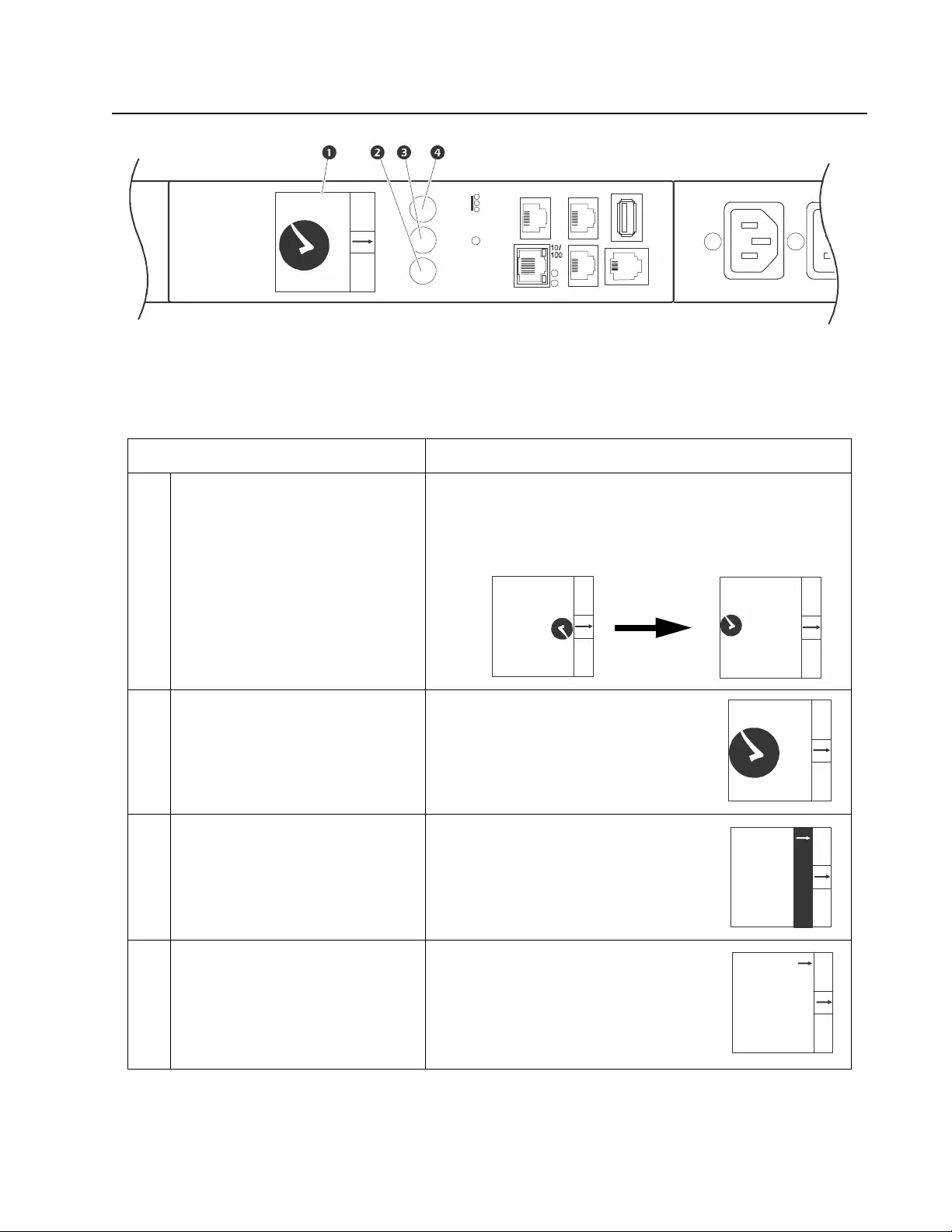
11 Metered Rack PDU
Rack PDU Front Panel
Note: Your Rack PDU is configured so the display backlight turns off after 10 minutes of inactivity.
The backlight can be turned on by depressing any button below the display.
Item Function
Display Shows information about the Rack PDU. In normal
operation, input volt age, current, and power r efreshes every
five seconds. To reverse the text, press and hold
simultaneously for five seconds the Main Menu (), Scroll
(), and Select () buttons.
Main Menu button Press to view the Rack PDU electrical
input.
Scroll button Press once to display the menu. Press
additional times to highlight the desired
menu option.
Select button With a menu option highlighted, press
the Select button to display Rack PDU
information. Network information is
shown.
pdu0711a
Serial
Network
In
Out
Temp/Hu m idi t
y
USB
Reset
Main
Menu
Select
Scroll
- Warning
- OK
- Overload
x
SELECT
MAIN
0
0
0
4.37 kW
pdu0712a
SELECT
MA
IN
0
24.5ºC
37.8%RH
Device Name
apc12345678
pdu0713a
SELECT
MA
IN
0
24.5ºC
37.8%RH
Device Name
apc
12345678
pdu0724a
SELECT
MA
IN
0
0
1.23 kW
pdu0714a
SELECT
MA
IN
Outlet Current
Temp/Humidity
Pha
se Info
Ne
twork
pdu0715a
SELECT
MA
IN
IPv4 Address
10.234.576.89
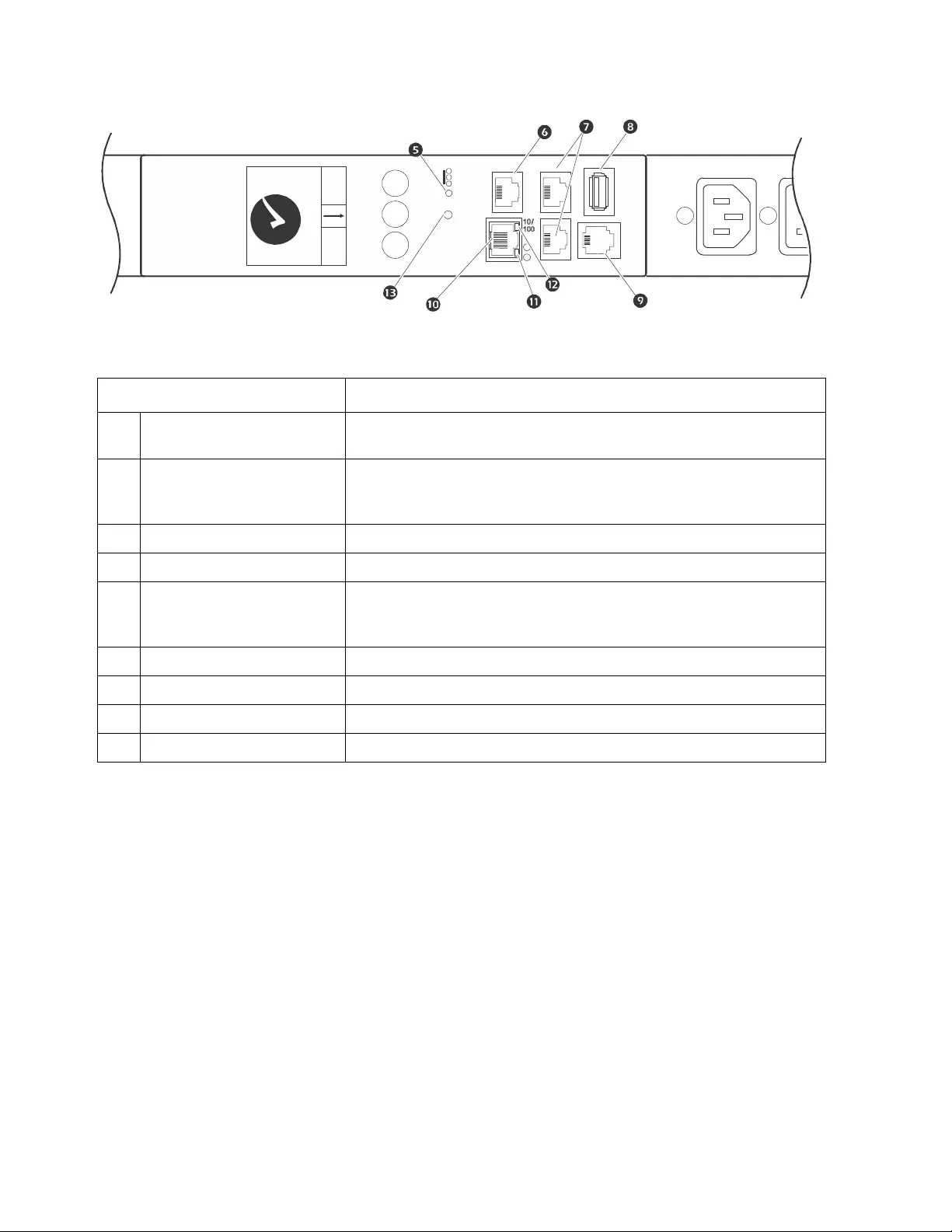
Metered Rack PDU12
Item Function
Load Indicator LED Indicates the status of the Rack PDU load. See “Load indicator
LED” on page 13.
Temp/Humidity port Port for connecting an optional Schneider Electric Temperature
Sensor (AP93T) or an optional Schneider Electric Temperature/
Humidity Sensor (AP9335TH).
In and Out ports For use with the Network Port Sharing feature.
USB port (For use with a flash drive for firmware upgrades - 5V @ 100ma.)
RJ-12 Serial Port Port for connecting the Rack PDU to a terminal emulator program
for local access to the command line interface. Use the supplied
serial cable (Schneider Electric part number 940-0144A).
10/100 Base-T Connector Connects the Rack PDU to the network.
Network status LED See “Network Status LED” on page 13.
10/100 LED See “10/100 LED” on page 13.
Reset button Resets the Rack PDU without affecting the outlet status.
pdu0716a
Serial
Network
In
Out
Temp/Hu m idi ty
USB
Reset
Main
Menu
Select
Scroll
- Warning
- OK
- Overload
x
SELECT
MAIN
0
0
0
4.37 kW

13 Metered Rack PDU
Network Status LED
10/100 LED
Load indicator LED
The load indicator LED identifies overload and warning conditions for the Rack PDU.
Condition Description
Off One of the following situations exists:
• The Rack PDU is not receiving input power.
• The Rack PDU is not operating properly. It may need to be repaired or
replaced. Contact Customer Support.
Solid Green The Rack PDU has valid TCP/IP settings.
Solid Orange A hardware failure has been detected in the Rack PDU. Contact Customer
Support.
Flashing Green The Rack PDU does not have valid TCP/IP settings.
Flashing Orange The Rack PDU is making BOOTP requests.
Alternately flashing green
and orange If the LED is flashing slowly, the Rack PDU is making DHCP2 requests1.
If the LED is flashing rapidly, the Rack PDU is starting up.
1. If you do not use a BOOTP or DHCP server, see “Establish Network Settings” on page 7 to configure the TCP/IP
settings of the Rack PDU.
2. To use a DHCP server, see “TCP/IP and Communication Settings” on page 80.
Condition Description
Off One or more of the following situations exists:
• The Rack PDU is not receiving input power.
• The cable that connects the Rack PDU to the network is disconnected or
defective
• The device that connects the Rack PDU to the network is turn ed off.
• The Rack PDU itself is not operating properly. It may need to be repaired or
replaced. Contact Customer Support.
Solid green The Ra ck PDU is connecte d to a network op erating a t 10 Meg abit s per secon d
(Mbps).
Solid orange The Rack PDU is connected to a network operating at 100 Mbps.
Flashing green The Rack PDU is receiving or transmitting data packets at 10 Mbps.
Flashing orange The Rack PDU is receiving or transmitting data packets at 100 Mbps.
Condition Description
Solid Green OK. No load alarms (warning or critical) are present.
Solid Yellow Warning. At least one load warning alarm is present, but no critical alarms are
present.
Flashing Red Overload. At least one load critical alarm is present.
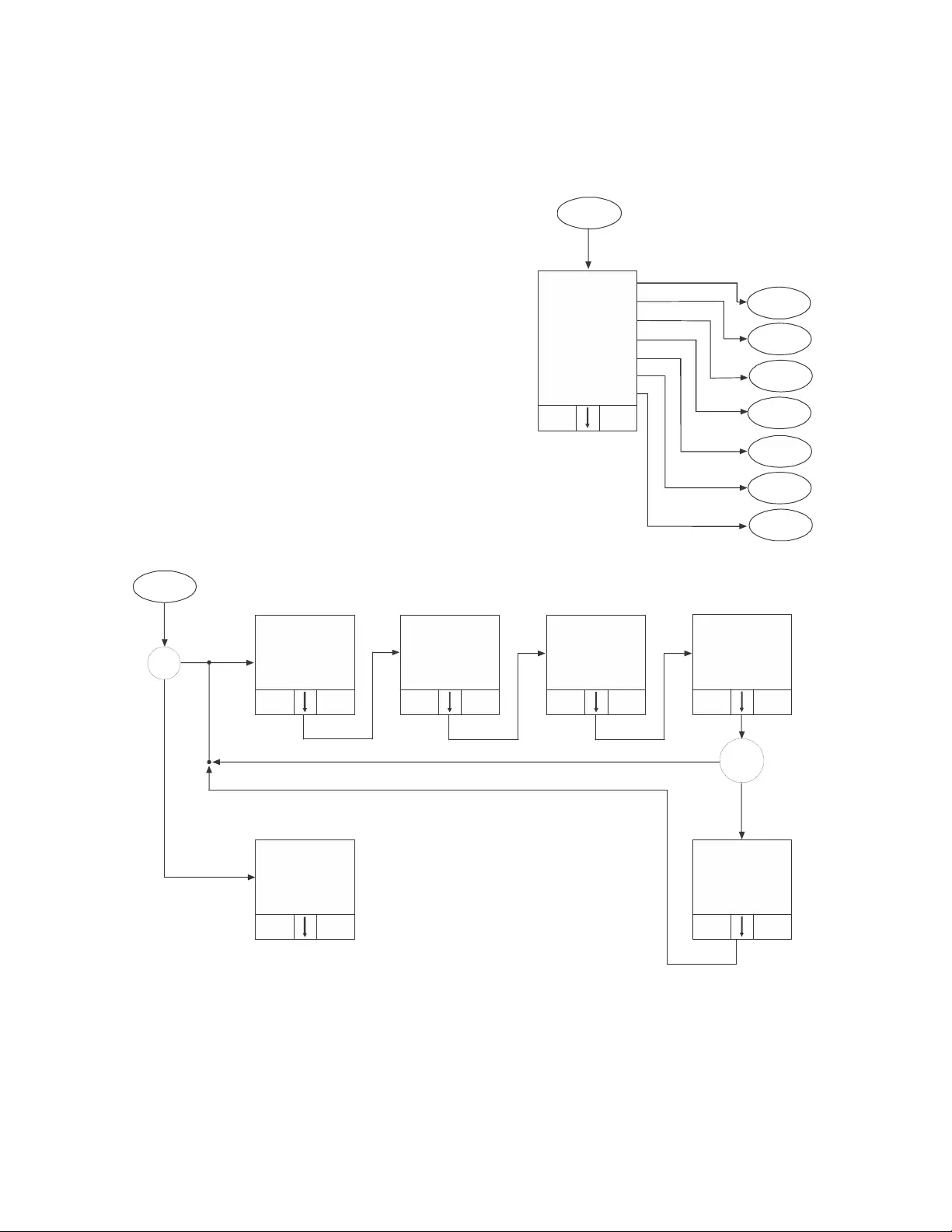
Metered Rack PDU14
Example 1
Main
Menu
pdu0718a
Temp/Humidity
Software Info
SKU/Serial #
SELECTMAIN
Phase Info
Disp la y Set tin gs
Network
Disp
Settings
SKU/SN
SW Info
Network
RF Code Control
RF Code
T/H
Phase
Info
Phase Current
1. 14.1 A
2. 14.2 A
3. 14.3 A
SELECTMAIN
pdu0719a
Phase 2
208.0 V
14. 2 A
1.2 3 kW
SELECTMAIN
Phase 3
208.0 V
14. 3 A
1.2 3 kW
SELECTMAIN
Voltage
L1 - 2: 208V
L2 - 3: 208V
L3 - 1: 208V
SELECTMAIN
1
phase
No
Phase
Info
Phase to
Phase
Outlets?
Yes
No
Yes
SELECTMAIN
Phase 1
208.0 V
14. 1 A
1.2 3 kW
Input
208.0 V
14. 1 A
SELECTMAIN
1.2 3 kW
NOTE: The Menu Home Screen is restricted to four lines
per menu page. If there are more than four available
selections, they will appear on multiple pages. “Outlet
Current” only appears on Metered per Outlet (MPO) units.
“Temp/H umidity” only appears when an AP9335T or
AP9335TH sensor is attached.
Display Tree
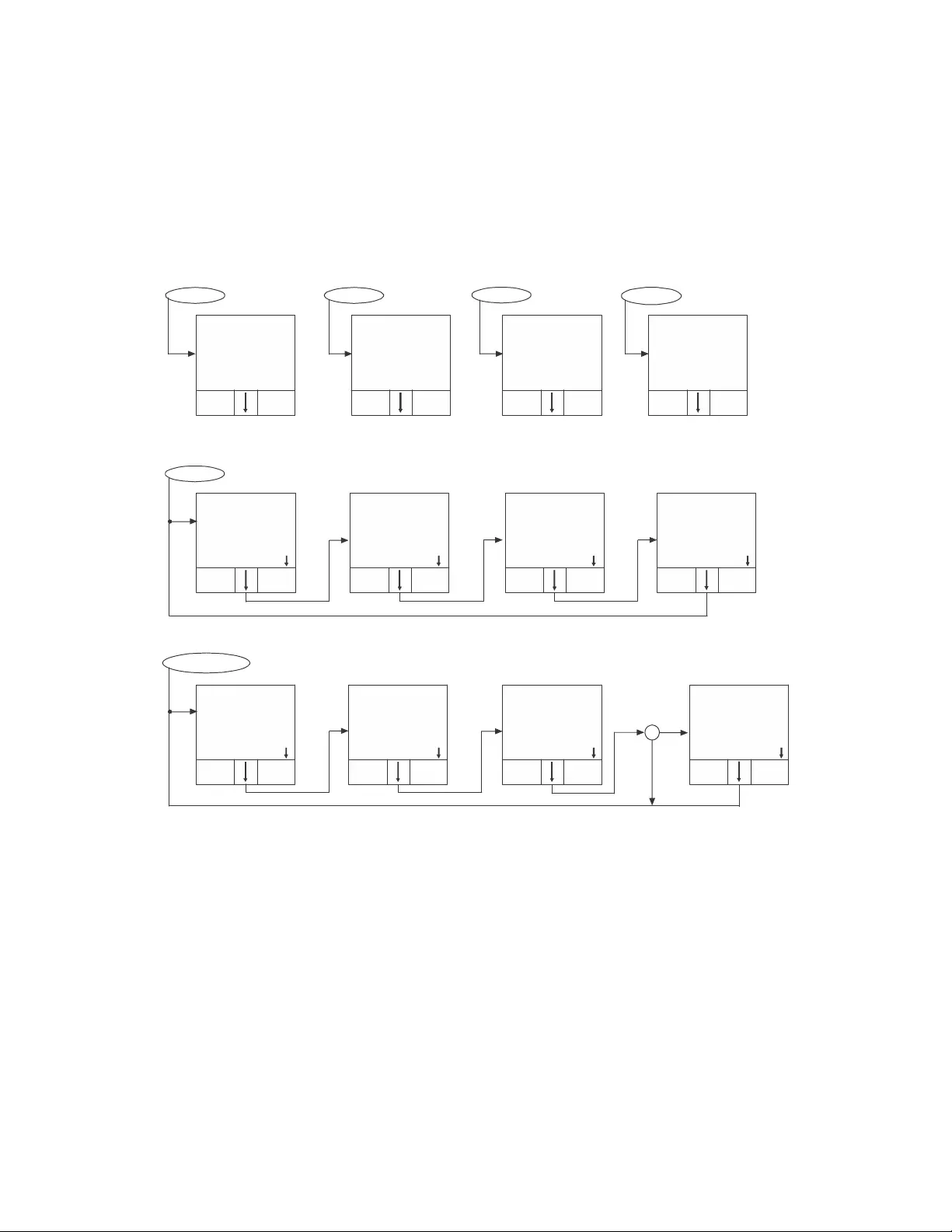
15 Metered Rack PDU
Example 2
pdu0710a
IPv4 Address
255.255.255.255
SELECTMAIN
Network
Sensor
Te mp: 45.6ºC
Hum: 37.8%
SELECTMAIN SELECTMAIN
Model
AP8XXX
Ser i al Nu mber
ZAxxxxxxxxxx
SELECTMAIN
AOS
5.0.0
APP
5.0.0
RF Code - Console
Enabled
SELECTMAIN
Press “Select”
WILL REBOOT
IPv6 Address
1234:5678:9012
3456:7890:1234
5678:9012
SELECTMAIN
MAC Address
00 00 00
00 00 00
SELECTMAIN
LCD Contrast
5 / 9
Press “Select”
SELECTMAIN
SELECT
MAIN
LCD Backlight
Auto-On
Press “Select”
to swi t ch
SELECT
MAIN
LCD Orientation
Normal
Press “Select”
to swi t ch
Display ID
Hide
SELECTMAIN
Press “Select”
to swi t chto adjust
No
Yes
Network Port
Sharing Group
IPv6 Address
(scrolls through
each IPv6 addr)
SELECTMAIN
Disp. Settings
SKU/SN SW Info
T/H
RF Code
Display Tree
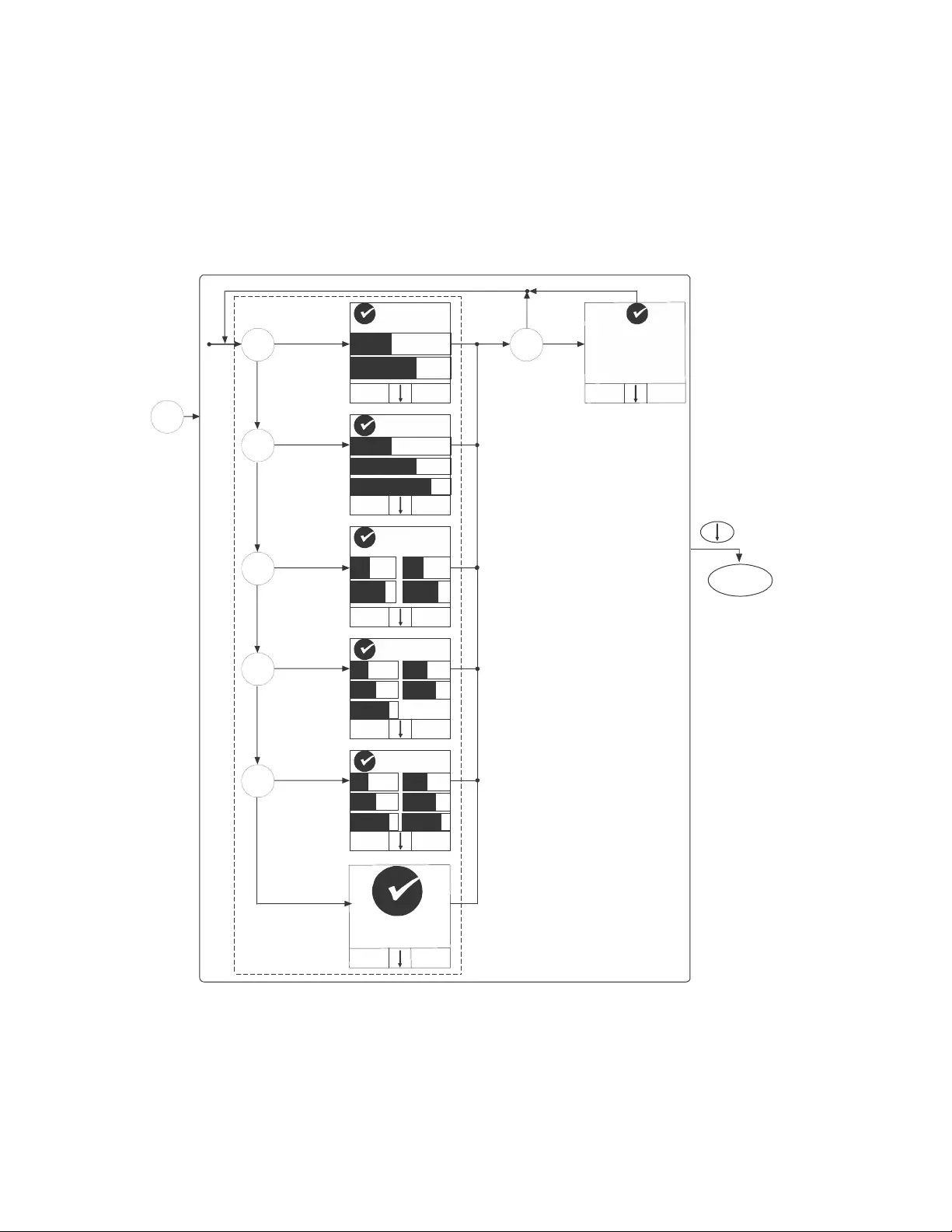
Metered Rack PDU16
Example 3
Main
Menu
pdu0720a
2 bank Yes
No
SELECT
MAIN
1.23 kW
2
1
SELECT
MAIN
0
24.5ºC
37.8%RH
Device Name
apc12345678
Sensor
Yes
No
SELECT
MAIN
1.23 kW
2
1
3
3 bank Yes
No
4 bank Yes
No
5 bank Yes
No
SELECT
MAIN
1.23 kW
2
1
4
3
SELECT
MAIN
1.23 kW
1
3
5
4
2
SELECT
MAIN
1.23 kW
1
3
5
4
2
6
6 bank Yes
SELECT
MAIN
0
0
1.23 kW
MAIN
Monitor Status
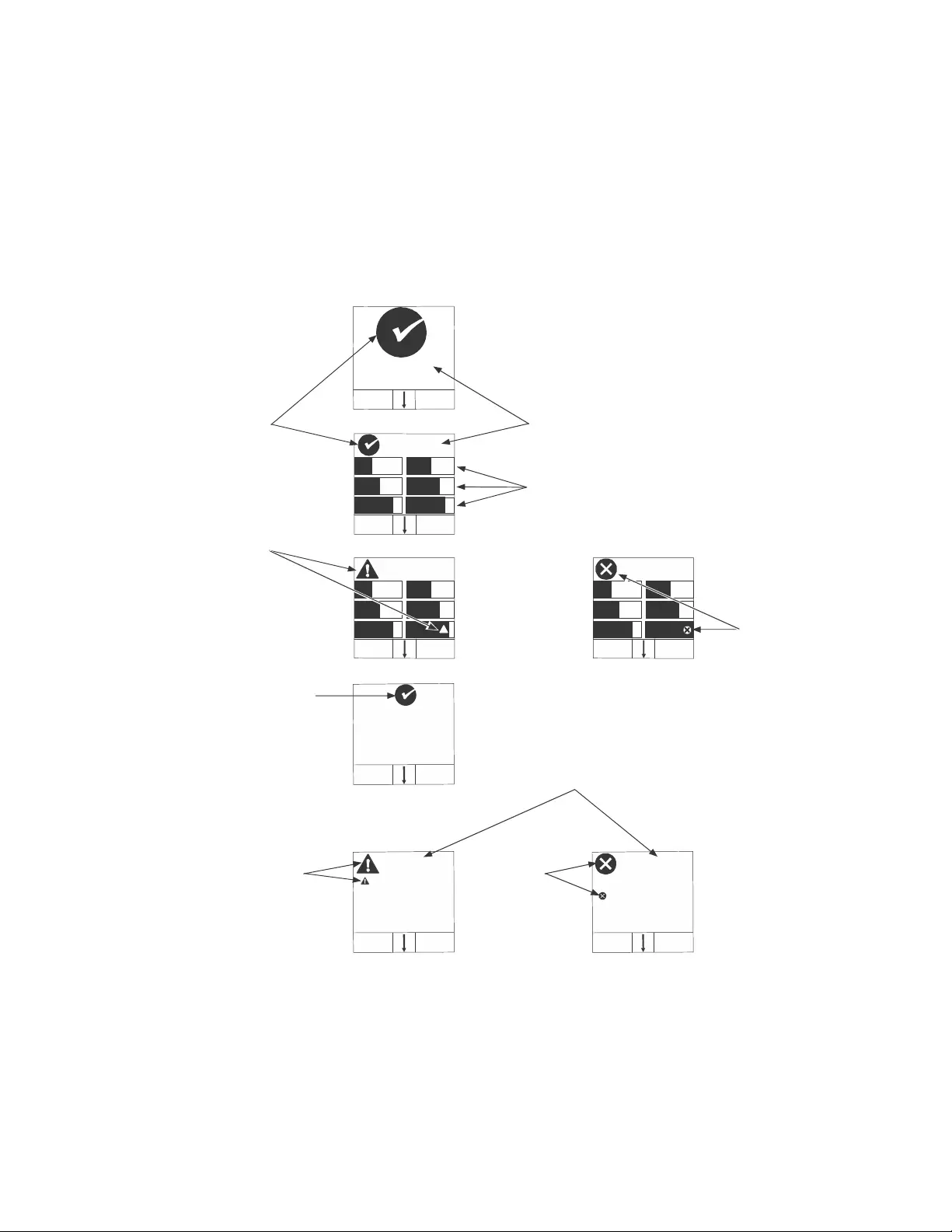
17 Metered Rack PDU
Example 4
pdu0721a
SELECT
MAIN
0
24.5ºC
37.8%RH
Device Name
apc12345678
SELECT
MAIN
1.23 kW
1
3
5
4
2
6
SELECT
MAIN
0
0
1.23 kW
SELECT
MAIN
5.67 kW
1
3
5
4
2
6
SELECT
MAIN
7.89 kW
1
3
5
4
2
6
SELECT
MAIN
59.0ºC
30.0%RH
Device Name
apc12345678
SELECT
MAIN
24.5ºC
10.0%RH
Device Name
apc12345678
Normal S t atu s
Indicator
De vic e Loa d
Reading
Bank Load Graphs
(No I ndicat or = No rmal Status)
High TempLow Humidity
Warning
(N ear Overload)
Indicator
Critical
(Overload)
Indicator
Normal S t atu s
Indicator
Warning
Threshold
Violation
Indicator
Critical
Threshold
V
iolation
Indicator
Mo st Critical
Sensor Status
Monitor Status Indicators
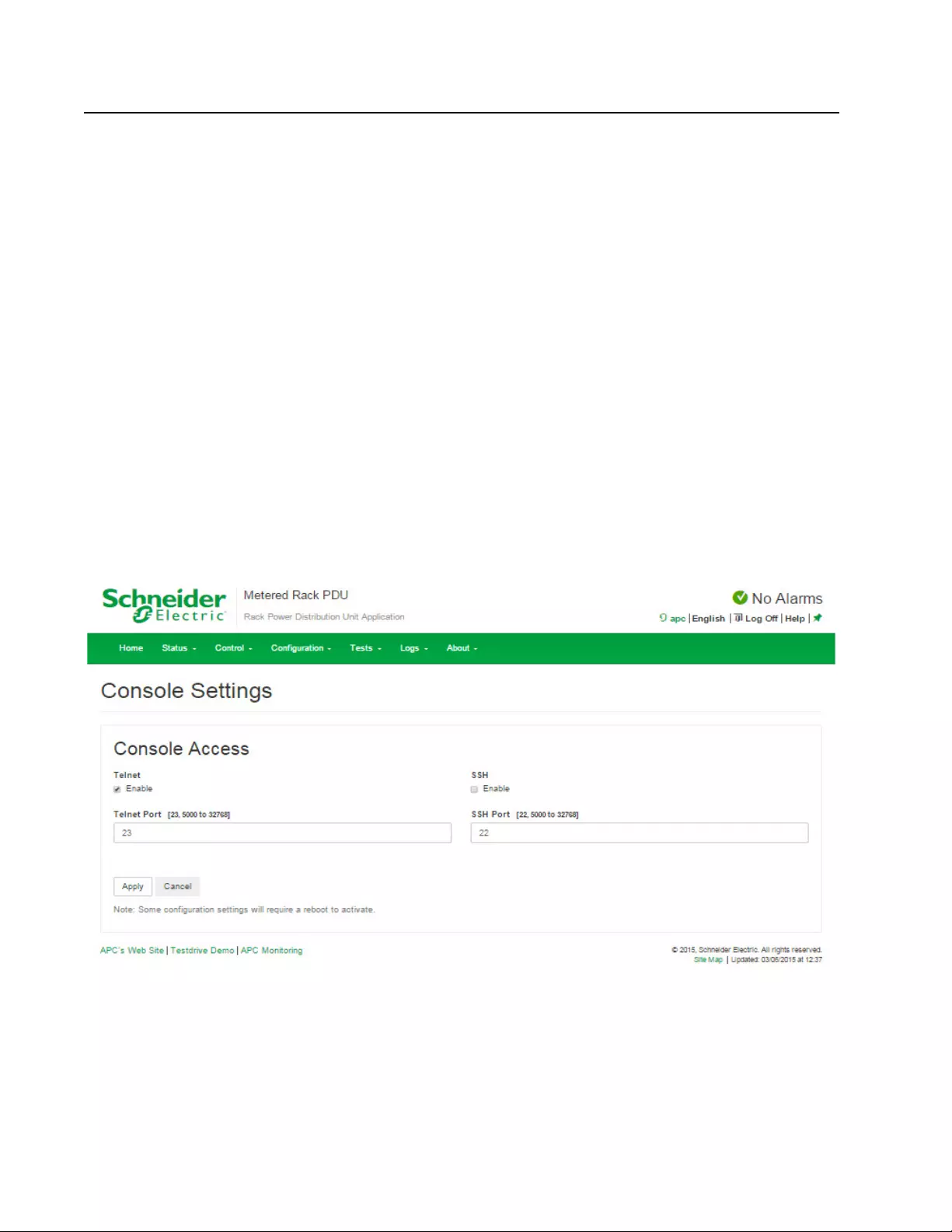
Metered Rack PDU18
Command Line Interface
About the Command Line Interface (CLI)
You can use the command line interface to view the status of and configure and manage the Rack
PDU (and any connected Rack PDUs if using the Network Port Sharing Feature). In addition, the
command line interface enables you to create scripts for automated operation . You can configure all
parameters of a Rack PDU (including those for which there are not specific CLI commands) by using
the CLI to transfer an INI file to the Rack PDU. The CLI uses XMODEM to perform the transfer,
however, you cannot read the current INI file through XMODEM.
Log on to the CLI
To access the command line interface, you can use either a local (serial) connection or a remote
(Telnet or SSH) connection with a computer on the same network as the Rack PDU.
Remote access to the command line interface
You can choose to access the command line interface through Telnet and/or SSH. Telnet is enabled
by default. You do not have to enable either.
To enable or disable these access met hods, use the web interface. On the Configuration tab, select
Network from the menu to o pen the Console Access page. Click to check the desired Enable bo x.
Click Apply to save your changes or Cancel to leave the page.

19 Metered Rack PDU
Telnet for basic access
Telnet provides the basic security of authentication by user name and password, but not the high-
security benefits of encryption.
To use Telnet to access the command line interface:
1. From a computer that has access to the network on which the Rack PDU is installed, at
a command prompt, type telnet and the IP address for the Rack PDU (for example,
telnet 139.225.6.133, when the Rack PDU uses the default Telnet port of 23), and
press ENTER.
If the Rack PDU uses a non-default port number (from 5000 to 32768), you must include
a colon or a space, depending on your Telnet client, between the IP address (or DNS
name) and the port number. (These are commands for general usage: Some clients do
not allow you to specify the port as an argument and some types of Linux might want
extra commands).
2. Enter the user name and password (by default, apc and apc for the Super User).
If you cannot remember your user name or password, see “Recovering from a Lost
Password” on page 10.
SSH for high-security access
If you use the high security of SSL for the Web interface, use SSH for access to the command line
interface. SSH encrypts u ser names, passwords, and transmitted data . The interface, user account s,
and user access right s are the same whether you access the command line interface through SSH or
Telnet, but to use SSH, you must first configure SSH and have an SSH client program installed on
your computer.
Local access to the command line interface
For local access, use a computer that connects to the Rack PDU through the serial port to access
the command line interface:
1. Select a serial port at the computer and disable any service that uses that port.
2. Connect the serial cable (Schneider Electric part number 940-0144A) from the selected
serial port on the computer to the Serial port on the Rack PDU.
3. Run a terminal program (e.g., HyperTerminal) and configure the selected port for 9600
bps, 8 data bits, no parity, 1 stop bit, and no flow control.
4. Press ENTER. At the prompts, enter your user name and password.

Metered Rack PDU20
About the Main Screen
Following is an example o f the main screen, which is displayed when you log on to the command line
interface of a Rack PDU.
• Two fields identify the operating system (AOS) and application (APP) firmware versions.
The application firmware name identifies the type of device tha t connects to the ne twork.
In the example above, the application firmware for the Rack PDU is displayed.
Network Management Card AOS vx.x.x
RPDU 2g vx.x.x
• Three fields identify the system name, contact person, and location of the Rack PDU.
Name : Test Lab
Contact : Don Adams
Location : Building 3
• An Up Time field reports how long the Rack PDU Management Interface has been
running since it was last turned on or reset.
Up Time: 0 Days, 21 Hours, 21 Minutes
• Two fields identify when you logged in, by date and time.
Date: 10/30/2013
Time: 5:58:30
• The User field identifies whether you logged in through the Super User, Administrator
or Device Manager account.
User: Administrator
Schneider Electric Network Management Card AOS vx.x.x
(c)Copyright 2015 All Rights Reserved RPDU 2g vx.x.x
--------------------------------------------------------------------------
Name : Test Lab Date : 06/30/2015
Contact : Don Adams Time : 5:58:30
Location : Building 3 User : Administrator
Up Time : 0 Days, 21 Hours, 21 Minutes Stat : P+ N4+ N6+ A+
Type ? For command listing
Use tcpip for IP address (-i), subnet (-s), and gateway (-g)
APC>

21 Metered Rack PDU
• A Stat field reports the Rack PDU status.
Stat:P+ N4+ N6+ A+
Note: If P+ is not displayed, contact the Schneider Electric Customer Care Center.
Using the CLI
At the command line interface, you can use commands to configure the Rack PDU. To use a
command, type the command and press ENTER. Commands and arguments are valid in lowercase,
uppercase, or mixed case. Options are case-sensitive.
While using the command line interface, you can also do the following:
• Type ? and press ENTER to view a list of available commands, based on your account
type.
• To obtain information about the purpose and syntax of a specified command, type the
command, a space, and ? or the word help. For example, to view RADIUS configura tion
options, type:
radius ?
or
radius help
• Press the UP arrow key to view the command that was entered most recently in the
session. Use the UP and DOWN arrow keys to scroll through a list of up to ten previous
commands.
• Type at least one letter of a command and press the TAB key to scroll through a list of
valid commands that match the text you typed in the command line.
• Type exit or quit to close the connection to the command line interface.
P+ The APC operating system (AOS) is functioning properly.
IPv4
only IPv6
only IPv4 and
IPv6* Description
N+ N+ N4+ N6+ The network is func tion in g pr op e rly.
N? N6? N4? N6? A BOOTP request cycle is in progress.
N– N6- N4- N6- The Rack PDU failed to connect to the network.
N! N6! N4! N6! Another device is using the Rack PDU IP address.
* The N4 and N6 values can be different from one another: you could, for
example, have N4- N6+.
A+ The applicat ion is func tion in g pr op e rly.
A– The application has a bad checksum.
A? The application is initializing.
A! The applicat ion is not compatible with the AOS.

Metered Rack PDU22
Command Syntax
Example of a command that supports multiple options:
ftp [-p <port number>] [-S <enable | disable>]
In this example, the ftp command accepts the option -p, which defines the port number, and the
option -S, which enables or disables the FTP feature.
To change the FTP port number to 5010, and enable FTP:
1. Type the ftp command, the port option, and the argument 5010:
ftp -p 5010
2. After the first co mmand succeeds, type the ftp command, the enable/disable option, and
the enable selection:
ftp -S enable
Example of a command that accepts mutually exclusive arguments for an option:
alarmcount -p [all | warning | critical]
In this example, the option -p accepts only three arguments: all, warning, or critical. For example, to
view the number of active critical alarms, type:
alarmcount -p critical
The command will fail if you type an argument that is not specified.
Item Description
- Options are preceded by a hyphen.
< > Definitions of options are enclosed in angle brackets. For example:
-dp <device password>
[ ] If a command accept s multiple options or an option accepts mutually exclusive arguments,
the values may be enclosed in brackets.
| A vertical line between items enclosed in brackets or angle bra ckets indicates that the items
are mutually exclusive. You must use one of the items.

23 Metered Rack PDU
Command Response Codes
The command response codes enable scripted operations to detect error conditions reliably without
having to match error message text:
The CLI reports all command operations with the following format:
E [0-9] [0-9] [0-9] : Error message
Code Message
E000 Success
E001 Successfully Issued
E002 Reboot required for change to take effect
E100 Command failed
E101 Command not found
E102 Parameter Error
E103 Command Line Error
E104 User Level Denial
E105 Command Prefill
E106 Data Not Available
E107 Serial communication with the Rack PDU has been lost

Metered Rack PDU24
Network Management Card Command Descriptions
? or help
Access: Super User, Administrator, Device User, Read Only
Description: View a list of all the CLI commands available to your account type. To view help text
for a specific command, type the command followed by a question mark.
Parameters: [<command>]
Example 1:
apc> ?
Network Management Card Commands:
---------------------------------------------------------------------
? about alarmcount boot cd date
delete dir eventlog exit format ftp
help ping portspeed prompt quit radius
reboot resetToDef system tcpip user web
xferINI xferStatus
Example 2: apc> help boot
Usage: boot -- Configuration Options
boot [-b <dhcpBootp | dhcp | bootp | manual>] (Boot Mode)
[-a <remainDhcpBootp | gotoDhcpOrBootp>] (After IP
Assignment)
[-o <stop | prevSettings>] (On Retry Fail)
[-c <enable | disable>] (Require DHCP Cookie)
[-s <retry then stop #>] (Note: 0 = never)
[-f <retry then fail #>] (Note: 0 = never)
[-v <vendor class>]
[-i <client id>]
[-u <user class>]
Error Message: E000, E102

25 Metered Rack PDU
about
Access: Super User, Administrator, Device User, Read Only
Description: Displays system information (Model Number, Serial Number,
Manufacture Dates, etc.)
Parameters: None
Example: apc> about
E000: Success
Hardware Factory
---------------
Model Number: AP8XXX
Serial Number: ST0913012345
Hardware Revision: HW05
Manufacture Date: 3/4/2015
MAC Address: 00 05 A2 18 00 01
Management Uptime: 0 Days 1 Hour 42 Minutes
Error Message: E000
alarmcount
Access: Super User, Administrator, Device User, Read Only
Description: Displays alarms present in the system.
Example: To view all active warning alarms, type:
apc> alarmcount
E000: Success
AlarmCount: 0
Error Message: E000, E102
Option Argument Description
-p all View the number of active alarms reported by the Rack PDU.
Information about the al arms is provided in the event log.
warning View the number of active warning alarms.
critical View the number of active critical alarms.

Metered Rack PDU26
boot
Access: Super User, Administrator
Description: Allows the user to get/set the network startup configuration of the device, such as
setting boot mode (DHCP vs BOOTP vs MANUAL).
Example: Using a DHCP server to obtain network settings:
apc> boot
E000: Success
Boot Mode: manual
Non-Manual Mode Shared Settings
-------------------------------
Vendor class: <device class>
Client id: XX XX XX XX XX XX
User class: <user class>
After IP assignment: gotoDhcpOrBootp
DHCP Settings
-------------
Retry then stop: 4
DHCP cookie is: enable
BOOTP Settings
--------------
Retry then fail: never
On retry failure: prevSettings
Error Message: E000, E102
bye
Access: Super User, Administrator, Device User, Read Only
Description: Exit the CLI
Example: bye
Error Message: None
Option Argument Description
-b
<boot
mode>
dhcp | bootp | manual Define how the TCP/IP settings will be configured when
the Rack PDU turns on, resets, or restarts. See “TCP/IP
and Communication Settings” on page 80 for information
about each boot mode setting.
-c [<enable | disable>]
(Require DHCP Cookie) dhcp and dhcpBootp boot modes only . Ena ble or disable
the requirement that the DHCP server provide the APC
cookie.
-v [<vendor class>] Vendor Class is APC
-i [<client id>] The MAC address of the NM C, Which uniquely identifies it
on the network.
-u [<user class>] The name of the application firmware module.

27 Metered Rack PDU
cd
Access: Super User, Administrator, Device User, Read Only
Description: Allows the user to set the working d irectory of the file system. The working directory is
set back to the root directory ‘/’ when the user logs out of the CLI.
Parameters: <dicrectory name>
Example:
apc> cd logs
E000: Success
apc> cd /
E000: Success
Error Message: E000, E102
clrrst
Access: Super User, Administrator, Device User
Description: Clear reset reason.
Example: None
Error Message: None
console
Access: Super User, Administrator
Description: Define whether users can access the command line interface using Telnet, which is
enabled by default, or Secure SHell (SSH), which provides protection by transmitting user names,
passwords, and dat a in e ncrypted form. You can change the Telnet or SSH port setting for additional
security. Alternately, disable network access to the command line interface.
Parameters:
Example 1: To enable SSH access to the command line interface, type:
console -S ssh
Example 2: To change the Telnet port to 5000, type:
Telnet: enabled
SSH: disabled
Telnet Port: 23
SSH Port: 22
Baud Rate: 9600Parameters:
Option Argument Description
-S disable | telnet | ssh Configure access to the command line interface, or use
the disable command to prevent access. Enabling SSH
enables SCP and disables Telnet.
-t <enable | disable>]
(telnet)
-pt <telnet port n> Define the Telnet port used to communica te with the Rack
PDU (23 by default).
-ps <SSH port n> Define the SSH port used to communicate with the Rack
PDU (22 by default).
-b 2400 | 9600 | 19200 |
38400 Configure the speed of the serial port connection (9600
bps by defa ult).

Metered Rack PDU28
date
Access: Super User, Administrator
Definition: Get and set the date and time of the system.
To configure an NTP se rver to define the date and time for the Rack PDU, see “Date/T ime screen” on
page 96.
Parameters:
Example 1: To display the date using the format yyyy-mm-dd, type:
date -f yyyy-mm-dd
Example 2: To define the date as October 30, 2015, using the format configured in the preceding
example, type:
date -d “2015-10-30”
Example 3: To define the time as 5:21:03 p.m., type:
date -t 17:21:03
Error Message: E000, E100, E102
delete
Access: Super User, Administrator
Description: Delete a file in the file system.
Parameters:
Example:
apc> delete /db/prefs.dat
E000: Success
Error Messages: E000, E102
Option Argument Description
-d <“datestring”> Set the current date . The format must match the current -f setting.
-t <00:00:00> Configure the current time, in hours, minutes, and seconds. Use the
24-hour clock format.
-f mm/dd/yy |
dd.mm.yyyy |
mmm-dd-yy |
dd-mmm-yy |
yyyy-mm-dd
Select the numerical format in which to display all dates in this user
interface. Each letter m (for month), d (for day), and y (for year)
represents one digit. Single-digit days and months are displayed with a
leading zero.
-z <time zone
offset> Set the difference with GMT in order to specify your time zone. This
enables you to synchronize with other people in different time zones.
Argument Description
<file name> Type the na m e of the file to delete.

29 Metered Rack PDU
dir
Access: Super User, Administrator, Device User, Read Only
Description: Displays the content of the working directory.
Example: apc> dir
E000: Success
--wx-wx-wx 1 apc apc 3145728 Mar 3 2015 aos.bin
--wx-wx-wx 1 apc apc 3145728 Mar 4 2015 app.bin
-rw-rw-rw- 1 apc apc 45000 Mar 6 2015 config.ini
drwxrwxrwx 1 apc apc 0 Mar 3 2015 db/
drwxrwxrwx 1 apc apc 0 Mar 3 2015 ssl/
drwxrwxrwx 1 apc apc 0 Mar 3 2015 ssh/
drwxrwxrwx 1 apc apc 0 Mar 3 2015 logs/
drwxrwxrwx 1 apc apc 0 Mar 3 2015 sec/
drwxrwxrwx 1 apc apc 0 Mar 3 2015 dbg/
drwxrwxrwx 1 apc apc 0 Mar 3 2015 pdu/
Error Messages: E000
dns
Access: Super User, Administrator
Definition: Configure the manual Domain Name System (DNS) settings.
Example: None
Error Message: E000
Parameter Argument Description
-OM <enable |
disable> Override the manual DNS.
-p <primary DNS
server> Set the primary DNS server.
-s <secondary
DNS server> Set the secondary DNS server.
-d <domain name> Set the domain name.
-n <domain name
IPv6> Set the domain name IPv6.
-h <host name> Set the host name.
-y <enable |
disable> System-hostname sync

Metered Rack PDU30
email
Access: Super User, Administrator, Device User
Description: View email
Parameters:
Example: None
Error Message: None
Parameters Argument
-g[n] <enable | disable> (Generation)
-t[n] <To Address>
-o[n] <long | short> (Format)
-l[n] <Language Code>
-r [n] <Local | recipient | custom> (Route)
Custom Route Option
-f[n] <From Address>
-s{n} <SMTP Server>
-p[n] <Port>
-a[n] <enable | disable> (Authentication)
-u[n] <User Name>
-w[n] <Password>
-e[n] <none | ifsupported | always |
implicit> (Encryption)
-c[n] <enable | disable > (Required
Certificate)
-i[n] <Certificate File Name>
n= Email Recipient Number 1,2,3 or 4)

31 Metered Rack PDU
eventlog
Access: Super User, Administrator, Device User, Read Only
Description: View the date and time you retrieved the event log, the status of the Rack PDU, and
the status of sensors connected to the Rack PDU. View the most recent device events and the date
and time they occurred. Use the following keys to navigate the event log:
Example:
apc> eventlog
---- Event Log -----------------------------------------------------
Date: 03/06/2015 Time: 13:22:26
------------------------------------
Metered Rack PDU: Communication Established
Date Time Event
---------------------------------------------------------------
03/06/2015 13:17:22 System: Set Time.
03/06/2015 13:16:57 System: Configuration change. Date format
preference.
03/06/2015 13:16:49 System: Set Date.
03/06/2015 13:16:35 System: Configuration change. Date format
preference.
03/06/2015 13:16:08 System: Set Date.
03/05/2015 13:15:30 System: Set Time.
03/05/2015 13:15:00 System: Set Time.
03/05/2015 13:13:58 System: Set Date.
03/05/2015 13:12:22 System: Set Date.
03/05/2015 13:12:08 System: Set Date.
03/05/2015 13:11:41 System: Set Date.
<ESC>- Exit, <ENTER>- Refresh, <SPACE>- Next, <D>- Delete
Error Message: E000, E100
Key Description
ESC Close the event log and return to th e command line interface.
ENTER Update the log display. Use this command to view events that were reco rded after yo u
last retrieved and displayed the log.
SPACEBAR View the next page of the event log.
BView the preceding page of the event log. This command is not available at the main
page of the event log.
DDelete the event log. Follow the prompts to confirm or deny the deletion. Deleted
events cannot be r etrieved.

Metered Rack PDU32
exit or quit
Access: Super User, Administrator, Device User, Read Only
Description: Exit from the CLI session.
Parameters: None
Example:
apc> exit
Bye
Error Message: None
firewall
Access: Super User, Administrator
Description: Establishes a barrier between a trusted, secure internal network and another network.
Parameters:
Error Message: None
format
Access: Super User, Administrator
Description: Allows the user to format the FLASH file system. This will delet e all configuration data,
event and data logs, certificates and keys.
Example:
apc> format
Format FLASH file system
Warning: This will delete all configuration data,
event and data logs, certs and keys.
Enter 'YES' to continue or <ENTER> to cancel:
apc>
Error Message: None
Parameters Argument Description
-S <enable | disable> Enable or disable the Firewall.
-f <file name to activate> Name of the firewall to
activate.
-t <file name to test>
<duration time in minutes> Name of firewall to test an d
duration time in minutes.
-fe No argument. List only Shows active file errors.
-te No argument. List only Shows test file errors.
-c No argument. List only Cancel a firewall test .
-r No argument. List only Shows active firewall rules.
-l No argument. List only Shows firewall activity log.

33 Metered Rack PDU
ftp
Access: Super User, Administrator
Description: Get/set the ftp configuration data,
Note: The system will reboot if any configuration is changed.
Example: To change the TCP/IP port to 5001, type:
apc> ftp -p 5001
E000: Success
apc> ftp
E000: Success
Service: Enabled
Ftp Port: 5001
apc> ftp -p 21
E000: Success
Error Message: E000, E102
help
Access: Super User, Administrator, Device User, Read Only
Description: View a list of all the CLI commands available to your account type. To view help text
for a specific command, type the command followed by help.
Example 1: To view a list of commands available to a Device User, type:
help
Example 2: To view a list of options that are accepted by the alarmcount command, type:
alarmcount help
Error Message: None
lang
Access: Super User, Administrator, Device User, Read Only
Description: Language in use
Example: Languages enUs - English
Error Message: None
Option Argument Definition
-p <port number>
(valid ranges are:
21 and 5000-32768)
Define the TCP/IP port that the FTP server uses to
communicate with the Rack PDU (21 by default). The FTP
server uses both the specified port and the port one number
lower than the specified port.
-S enable | disable Configure access to the FTP server.

Metered Rack PDU34
lastrst
Access: Super User, Administrator, Device User
Description: Last reset reason
Parameters: Usage: lastrst -- Last reset reason
Example:
09 Coldstart Reset
E000: Success
Error Message: None
ledblink
Access: Super User, Administrator, Device User
Description: Sets the blink rate to the LED on the Rack Power Distribution Unit (RPDU).
Parameters: None
Example:
usage: ledblink -- Configuration Options ledblink <duration time in minutes>
Error Message: None
logzip
Access: Super User, Administrator, Device User
Description: Places large logs into a zip file before sending.
Parameters:
Usage: logzip -- Configuration Options
logzip [-m <email recipient>] (email recipient number (1-4))
Example:
Generating files
Compressing files into /dbg/debug_ZA1023006009.tar
E000: Success
Error Message: E000

35 Metered Rack PDU
netstat
Access: Super User, Administrator, Device User, Read Only
Description: Displays incoming and outgoing network connections.
Parameters:
Usage: netstat -- Configuration Options netstat
Example:
Current IP Information:
Family mHome Type IPAddress
Status
IPv6 4 auto FE80::2C0:B7FF:FE51:F304/64
configured
IPv6 0 manual ::1/128
configured
IPv4 0 manual 127.0.0.1/32
configured
Error Message: None
ntp
Access: Super User, Administrator
Description: Synchronizes the time of a computer client or server.
Example 1: To enable the override of manual setting, type:
ntp -OM enable
Example 2: To specify the primary NTP server, type:
ntp -p 150.250.6.10
Error Message: E000
Option Argument Definition
-OM enable | disable Override the manual settings.
-p <primary NTP server> Specify the primary server.
-s <secondary NTP server> Specify the second ary server.

Metered Rack PDU36
ping
Access: Super User, Administrator, Device User
Description Perform a network ‘ping’ to any external network device.
Example:
apc> ping 192.168.1.50
E000: Success
Reply from 192.168.1.50: time(ms)= <10
Reply from 192.168.1.50: time(ms)= <10
Reply from 192.168.1.50: time(ms)= <10
Reply from 192.168.1.50: time(ms)= <10
Error Message: E000, E100, E102
portSpeed
Access: Super User, Administrator
Description: Allows the user to get/set the network port speed.
Note: The system will reboot if any configuration is changed.
Example:
apc> portspeed
E000: Success
Port Speed: 10 Half_Duplex
apc> portspeed -s 10h
E000: Success
apc> portspeed
E000: Success
Port Speed: 10 Half_Duplex
apc> portspeed -s auto
E000: Success
Error Message: E000, E102
Argument Description
<IP address or DNS name> Type an IP address with the format xxx.xxx.xxx.xxx, or the DNS
name configured by the DNS server.
Option Arguments Description
-s auto | 10H |
10F | 100H |
100 F
Define the communication speed of the Ethernet port. The auto
command enables the Ethernet devices to negotiate to transmit at
the highest possible speed. See “Port Speed” on page 82 for more
information about the port speed settings.
H = Half Duplex
F = Full Duplex 10 = 10 Meg Bits
100 = 100 Meg Bits

37 Metered Rack PDU
prompt
Access: Super User, Administrator, Device User
Description: Allows the user to change the format of the prompt, either short or long.
Example:
apc> prompt –s long
E000: Success
Administrator@apc>prompt –s short
E000: Success
Error Message: E000, E102
pwd
Access: Super User, Administrator, Device User, Read Only
Description: Used to output the path of the current working directory.
Parameters: pwd
Example: Usage: pwd -- Configuration Options
Error Message: None
Option Argument Description
-s long The prompt includes the account type of the currently logged-in user.
short The default setting. The prompt is four characters long: APC>

Metered Rack PDU38
radius
Access: Super User, Administrator
Description: View the existing RADIUS settings, enable or disable RADIUS authentication, and
configure basic authentication parameters for up to two RADIUS servers.
For a summary of RADIUS server configuration and a list of supported RADIUS servers, see
“Configure the RADIUS Server” on page 78.
Additional authentication parameters for RADIUS servers are available at the Web interface of the
Rack PDU. See “RADIUS” on page 77 for more information.
For detailed information about configuring your RADIUS server, see the Security Handbook,
available at www.schneider-electric.com.
Example 1:
To view the existing RADIUS settings for the Rack PDU, type radius and press ENTER.
Example 2: To enable RADIUS and local authentication, type:
radius -a radiusLocal
Example 3: To configure a 10-second timeout for a secondary RADIUS server, type:
radius -t2 10
Error Message: E000, E102
Option Argument Description
-a local |
radiusLocal
| radius
Configure RADIUS authentication:
local—RADIUS is disabled. Local authentication is enabled.
radiusLocal—RADIUS, then Local Authentication. RADIUS and
local authentication are ena bled. Authentication is requested from the
RADIUS server first. If the RADIUS server fails to respond, local
authentication is used.
radius—RADIUS is enabled. Local authentication is disabled.
-p1
-p2 <server IP> T h e ser ve r na m e or IP addre ss of th e pr ima r y or sec on d ar y RA DIUS
server.
Note: RADIUS servers use port 1812 by default to au thenticate users.
To use a diff erent por t, add a colon followed by th e new port nu mber to
the end of the RADIUS server name or IP ad dress. The Rack PDU
support s ports 1812, 500 0 to 32768.
-s1
-s2 <server
secret> The shared secret between the primary or secondary RADIUS server
and the Rack PDU.
-t1
-t2 <server
timeout> The time in seconds that the Rack PDU waits for a response from the
primary or secondary RADIUS server.

39 Metered Rack PDU
reboot
Access: Super User, Administrator
Description: Restart the NMC interface of the Rack PDU only. Forces the network device to reboot.
User must confirm this operation by entering a “YES” after the command has been entered.
Parameters: None
Example: apc> reboot
E000: Success
Reboot Management Interface
Enter 'YES' to continue or <ENTER> to cancel : <user enters ‘YES’>
Rebooting...
Error Message: E000, E100
resetToDef
Access: Super User, Administrator
Description: Reset all parameters to their default.
Example: To reset all of the configuration changes except the TCP/IP settings for the Rack PDU,
type:
resetToDef -p keepip
Enter 'YES' to continue or <ENTER> to cancel : : <user enters ‘YES’>
all User Names, Passwords.
Please wait...
Please reboot system for changes to take effect!
Error Message: E000, E100
Option Arguments Description
-p all | keepip all = all configuration data, including the IP address.
keepip -= all configuration data, except the IP address.
Reset all configuration chan g es, inclu ding event actions, devic e
settings, and, optionally, TCP/IP configuration settings.

Metered Rack PDU40
session
Access: Super User, Administrator, Device User
Description: Records who is logged in, the serial, time and ID.
Parameters:
Example:
User Interface Address Logged In Time ID
------------------------------------------------------------------------
apc Serial 00:00:05 1
Error Message: E000
smtp
Access: Super User, Administrator, Device User
Description: Internet standard for electronic mail.
Example: From: address@example.com
Server: mail.example.com
Port: 25
Auth: disabled
User: User
Password: <not set>
Encryption: none
Req. Cert: disabled
Cert File: <n/a>
Error Message: E000
Option Arguments
Session [-d <session nID>] (Delete)
-M <Enable | disable> (Multi-User Enable)
-a <enable | disable (Remote Authentication Override)
Option Argument
-f <From Address
-s <SMTP Server>
-p <Port> 1
-a <enable | disable> (Authentication)
-u <User Name>
-w <Password>
-e <none | ifavail | always | implicit> (Encryption)
-c <enable | disable> (Require Certificate)
-i <Certificate File Name>
1Port options are 25, 465, 587, 5000 to 32768

41 Metered Rack PDU
snmp
Access: Super User, Administrator
Description: Enable or disable SNMP.
Example: To enable SNMP version 1, type:
Access Control #: 1
Community: public
Access Type: read
Address: 0.0.0.0
Access Control #: 2
Community: private
Access Type: write +
Address: 0.0.0.0
Error Message: None
snmpv3
Access: Super User, Administrator
Description: Enable or disable SNMP 3
.
Example: To enable SNMP version 3, type:
Access Control #: 3
Community: public
Access Type: read
Address: 0.0.0.0
Access Control #: 2
Community: private
Access Type: write +
Address: 0.0.0.0
Error Message:None
Option Arguments Description
-c <Community> Identify the group of Rack PDUs
-a <read | write | writeplus | disable> Set the access level
-n <IP or Domain Name> The host’s name or address
-S enable | disable Enable or disable the respective version
of SNMP
Option Arguments Description
-S enable | disable Enable or disable the respective version
of SNMP
-u [n] User Name User Name
-c [n] <Community> Identify the group of Rack PDUs
-a [n] <read | write | writeplus | disable> Set the access level
-n [n] <IP or Domain Name> The host’s name or address
-ap [n] <sha | md5 | none> (Authentication Protocol)]
-pp [n] <aes | des | none> (Privacy Protocol)]
-ac [n] <enable | disable> (Access)
-au [n] < Nms Ip>] [n] = Access Control # = 1,2,3, or 4)

Metered Rack PDU42
snmptrap
Access: Super User, Administrator
Description: Enable or disable SNMP trap generation
Parameters:
Error Message: None
system
Access: Super User, Administrator
Description: View and set the system name, the contact, the location and view up time as well as
the date and time, the logged-o n user, and the high-le vel system status P, N, A (see “Abo ut the Main
Screen” on page 20 for more information about system status).
Example 1: To set the device location as Test Lab, type:
system -l “Test Lab”
Example 2: To set the system name as Rack 5, type:
system -n “Rack 5”
Option Arguments
-c{n} <Community>
-r[n] <Receiver NMS IP>
-l[n] <Language> [language code]
-t[n] <Trap Type> [snmpV1 | snmpV3]]
-g[n] <Generation> [enable | disable]
-a[n] <Auth Trap> [enable | disable]
-u[n] <profile1 | profile2 | profile3 | profile4> (User Name)
n=Trap receiver # = 1,2,3,4,5 or 6
Option Argument Description
-n <system-name> Define the device name, the name of the person responsible for
the device, and the physical location of the device.
Note: If you define a value with more than one word, you must
enclose the value in quotation marks.
These values are also used by StruxureWare and the Rack
PDU’s SNMP agent.
-c <system-contact>
-l <system-location>
-m <system-message> When defined, a custom message will appear on the log on
screen for all users.
-s <enable | disable>]
(system-hostname
sync)
Allow the host name to be synchronized with the system name
so both fields automatically contain the same value.
Note: When enabling this feature, the system name identifier
can no longer contain a space character (since it will be
synchronized to the host name field).

43 Metered Rack PDU
tcpip
Access: Super User, Administrator
Description: View and manually configure these network settings for the Rack PDU:
Example 1: To view the network settings of the Rack PDU, type tcpip and press ENTER.
Example 2: To manually configure an IP address of 150.250.6.10 for the Rack PDU, type:
tcpip -i 150.250.6.10
tcpip6
Access: Super User, Administrator
Description: Enable IPv6 and view and manually configure these network settings for the Rack
PDU:
Example 1: To view the network settings of the Rack PDU, type tcpip6 and press ENTER.
Example 2: To manually configure an IPv6 address of 2001:0:0:0:0:FFD3:0:57ab for the
Rack PDU, type:
tcpip6 -i 2001:0:0:0:0:FFD3:0:57ab
Option Argument Description
-i <IP address> Type the IP address of the Rack PDU, using the format
xxx.xxx.xxx.xxx
-s <subnet mask> Type the subnet mask for the Rack PDU.
-g <gateway> Type the IP address of the default gateway. Do not use the
loopback address (127.0.0.1) as the default gateway.
-d <domain name> Type the DNS name configured by the DNS server.
-h <host name> Type the host name that the Rack PDU will use.
-S enable | disable Enable or disable IPv4.
Option Argument Description
-S enable | disable Enable or disable IPv6.
-man enable | disable Enable manual addressing for the IPv6 address of the Rack
PDU.
-auto enable | disable Enable the Rack PDU to automatically configure the IPv6
address.
-i <IPv6 address> Set the IPv6 address of the Rack PDU.
-g <IPv6 gateway> Set the IPv6 address of the default gateway.
-d6 router | statefull
| statelss | never Set the DHCPv6 mode, with parameters of router controlled,
statefull (for address and other information, they maintain their
status), st ateless (for information other than address, the status
is not maintained), never.

Metered Rack PDU44
user
Access: Super User, Administrator
Description: Configure the user name, password, and inactivity timeout for each account types.
You can’t edit a user name, you must delete it and then create a new user. For information on the
permissions granted to each account type, see “Types of User Accounts” on page 2.
Example 1: To change the Administrator user name to XYZ, type:
user -an XYZ
Example 2: To change the log off time to 10 minutes, type:
user -t 10
Option Argument Description
-n <user>
Spe c ify thes e op tio ns for a user.
-pw <user password>
-pe <user permission>
-d <user description>
-e enable | disable Enable overall access.
-st <session timeout> Specify how long a session lasts waits before logging off a
user when the keyboard is idle.
-sr enable | disable Bypass RADIUS by using the serial console (CLI)
connection, also known as Serial Remote Authentication
Override
-el enable | disable Indicate the Event Log color coding.
-lf tab | csv Indicate the format for exporting a log file.
-ts us | metric Indicate the temperature scale, fahrenheit or celsius.
-df <mm/dd/yyyy |
dd.mm.yyyy | mmm-dd-
yy | dd-mmm-yy |
yyyy-mm-dd>
Specify a date format.
-lg <language code (e.g.
enUs)> Specify a user language.
-del <user name> Delete a user.
-l Display the current user list.

45 Metered Rack PDU
userdflt
Access: Super User, Administrator
Description: Complimentary function to “user” establishing default user preferences.
There are two main features for the default user settings:
Determine the default values to populate in each of the fields when the Super User or Administrator-
level account creates a new user. These values can be changed before the settings are applied to
the system.
For remote users (user accounts not stored in the system that are remotely authenticated such as
RADIUS) these are the values used for those that are not provided by the authe nticatin g server. For
example, if a RADIUS server does not provide the user with a temperature preference, the value
defined in this section will be used.
Parameters:
Error Message: None
Options Argument Description
-e <enable | disable> (Enable) By default, user will be enabled or
disabled upo n creation. Remove
(Enable) from the end
-pe <Administrator | Device | Read-Only |
Network-Only> (user permission) Specify the user's permission level
and account type.
-d <user description> Provide a user description.
-st <session timeout> minute(s) Provide a default session timeout.
-bl <bad login attempts> Number of incorrect login attempt s a
user has before the system disables
their account. Upon reaching this
limit, a message is displayed
informing the user the account has
been locked. The Super User or an
Administrator-level account is
needed to re-enable the account to
allow the user to log back in.
Note: A Super User account cannot
be locked out, but can be manually
disabled if necessary.
-el <enable | disable> (Event Log Color
Coding) Enable or disable event log color
coding.
-lf <tab | csv> (Export Log Format) Specify the log export format, tab or
CSV.
-ts <us | metrics> (Temperature Scale) Specify the user's temperature
scale. This setting is also used by
the system when a user preference
is not available (for example, email
notifications).
-df <mm/dd/yyyy | dd.mm.yyyy | mmm-dd-yy |
dd-mmm-yy | yyyy-mm-dd> (Date Format) Specify the user's preferred date
format.
-lg <language code (enUs, etc)> User language
-sp <enable | disable> Strong password
-pp <interval in days> Required password change interval

Metered Rack PDU46
web
Access: Super User, Administrator
Description: Enable access to the Web interface using HTTP or HTTPS.
For additional security, you can change the port setting for HTTP and HTTPS to any unused port
from 5000 to 32768. Users must then use a colon (:) in the address field of the bro wser to specify the
port number. For example, for a port number of 5000 and an IP address of 152.214.12.114, type:
http://152.214.12.114:5000
Parameters:
Example 1: To prevent all access to the web interface, type:
web -S disable
Example:
To define the TCP/IP port used by HTTP, type:
apc> web
E000: Success
Service: http
Http Port: 5000
Https Port: 443
apc> web -ph 80
E000: Success
Error Message: E000, E102
whoami
Access: Super User, Administrator, Device Only, Read Only
Description: Provides login information on the current user.
Parameters: None
Example:
apc> whoami
E000: Success
apc>
Error Message: None
Option Argument Definition
-h enable | disable Enable or disable access to the user interface for HTTP.
-s enable | disable
Enable or disable access to the user interface for HTTPS.
When HTTPS is enabled, data is encrypted during
transmission and authenticated by digital certificate.
-ph <http port #> Specify the TCP/IP port used by HTTP to communicate
with the Rack PDU (80 by default). The other available
range is 5000–32768.
-ps <https port #> Specify the TCP/IP port used by HTTPS to communicate
with the Rack PDU (443 by default). The other available
range is 5000–32768.

47 Metered Rack PDU
xferINI
Access: Super User, Administrator
Description: Use XMODEM to upload an INI file while you are accessing the command line
interface through a serial connection. After the upload completes:
• If there are any system or network changes, the command line interface resta rts and you
must log on again.
• If you selected a baud rate for the file transfer that is not the same as the default baud
rate for the Rack PDU, you must reset the baud rate to the default to reestablish
communication with the Rack PDU.
Parameters: None
Example:
apc> xferINI
Enter 'YES' to continue or <ENTER> to cancel : <user enters ‘YES’>
------- File Transfer Baud Rate------------------------------
1- 2400
2- 9600
3- 19200
4- 38400
> <user enters baudrate selection>
Transferring at current baud rate (9600), press <ENTER>...
<user presses <ENTER>>
Start XMODEM-CRC Transfer Now!
CC
<user starts sending INI>
150 bytes have successfully been transmitted.
apc>
Error Message: None
xferStatus
Access: Super User, Administrator
Description: View the result of the last file transfer. See “Verifying Upgrades and Updates” on
page 118 for descriptions of the transfer result codes.
Parameters: None
Example:
apc> xferStatus
E000: Success
Result of last file transfer: Failure unknown
Error Message: E000

Metered Rack PDU48
Device Command Descriptions
Network Port Sharing Commands
The CLI allows commands to be sent to guest Rack PDUs. The user may specify the Display ID of
the Rack PDU to be commanded, followed by a colon, before the first argument (or as the first
argument, if the command does not normally have arguments). Providing a Display ID is optional,
omitting it will simply command the local Rack PDU. For example:
<command> <id>:<arg1> <arg2>
This will send <command> to the Rack PDU with the Display ID <id>.
<id> is delimited from <arg1> with a colon character; do not include any spaces between
<id>:<arg1>, as spaces are used to delimit arguments.
bkLowLoad
Access: Super User, Administrator, Device User
Description: Set or view the bank low-load threshold current in amps. You can specify all banks, a
single bank, a range, or a comma-separated list of single banks and/or ranges.
Parameters:
[id#:]<all | bank#> [current]
bank# = A single number o r a range of numbe rs sep arated with a dash or a comma;
separated list of single bank number and/or number ranges.
current = The new bank threshold (Amps)
Example 1: To set the low-load threshold for all banks to 1A, type:
apc> bkLowLoad all 1
E000: Success
Example 2: To view the low-load threshold setting for banks 1 through 3, type:
apc> bkLowLoad 1-3
E000: Success
1: 1 A
2: 1 A
3: 1 A
Error Messages: E000, E102

49 Metered Rack PDU
bkNearOver
Access: Super User, Administrator, Device User
Description: Set or view the bank near-overload threshold current in amps. You can specify all
banks, a single bank, a range, or a comma-separated list of single banks and/or ranges.
Parameters:
[id#:]<all | bank#> [current]
Example 1: To set the near-overload threshold for all banks to 10A, type:
apc> bkNearOver all 10
E000: Success
Example 2: To view the near-overload threshold setting for banks 1 through 3, type:
apc> bkNearOver 1-3
E000: Success
1: 10 A
2: 10 A
3: 10 A
Example 3: To view the near-overload threshold setting for banks 1 and 2 on guest Rack PDU 3,
type:
apc> bkNearOver 3:1-2
E000: Success
1: 16 A
2: 16 A
Error Messages: E000, E102
bkOverLoad
Access: Super User, Administrator, Device User
Description: Set or view the bank overload threshold current in amps. You can specify all banks, a
single bank, a range, or a comma-separated list of single banks and/or ranges.
Parameters:
[id#:]<all | bank#> [current]
Example 1: To set the bank overload threshold for all banks to 13A, type:
apc> bkOverLoad all 13
E000: Success
Example 2: To view the bank overload threshold setting for banks 1 through 3, type:
apc> bkOverLoad 1-3
E000: Success
1: 13 A
2: 13 A
3: 13 A
Error Messages: E000, E102

Metered Rack PDU50
bkReading
Access: Super User, Administrator, Device User, Read Only
Description: View the current reading (measurement) in amps for a bank. You can specify all
banks, a single bank, a range, or a comma-separated list of single banks and/or ranges.
Parameters:
[id#:]<all | bank#> [current]
Example 1: To view the current reading for bank 3, type:
apc> bkReading 3
E000: Success
3: 4.2 A
Example 2: To view the current reading for all banks, type:
apc> bkReading all
E000: Success
1: 6.3 A
2: 5.1 A
3: 4.2 A
Error Messages: E000, E102

51 Metered Rack PDU
devLowLoad
Access: Super User, Administrator, Device User
Description: Set or view the low-load threshold in kilowatts for the device.
Parameters: [id#:][threshold] = New power threshold (Kilowatts).
Example 1: To view the low-load threshold, type:
apc> devLowLoad
E000: Success
0.5 kW
Example 2: To set the low-load threshold to 1 kW, type:
apc> devLowLoad 1.0
E000: Success
Error Messages: E000, E102
devNearOver
Access: Super User, Administrator, Device User
Description: Set or view the near-overload threshold in kilowatts for the device.
Parameters: <id#:][threshold] = New outlet threshold (Kilowatts).
Example 1: To view the near-overload threshold, type:
apc> devNearOver
E000: Success
20.5 kW
Example 2: To set the near-overload threshold to 21.3 kW, type:
apc> devNearOver 21.3
E000: Success
Error Messages: E000, E102
devOverLoad
Access: Super User, Administrator, Device User
Description: Set or view the overload threshold in kilowatts for the device.
Parameters: <id#:][threshold] = New outlet threshold (Kilowatts).
Example 1: To view the overload threshold, type:
apc> devOverLoad
E000: Success
25.0 kW
Example 2: To set the overload threshold to 25.5 kW, type:
apc> devOverLoad 25.5
E000: Success
Example 3: To view the overload threshold for guest Rack PDU 3, type:
apc> devOverLoad 3:
E000: Success
5.0 kW
Error Messages: E000, E102

Metered Rack PDU52
devReading
Access: Super User, Administrator, Device User, Read Only
Description: View the total power in kilowatts or total energy in kilowatt-hours for the device.
Parameters: [id#:] [power | energy | appower | pf]
Example 1: To view the total power, type:
apc> devReading power
E000: Success
5.2 kW
Example 2: To view the total energy, type:
apc> devReading energy
E000: Success
200.1 kWh
Error Messages: E000, E102
dispID
Access: Super User, Administrator
Description: Sets or reads the device’s Display ID.
Parameters: [id#:] [new_id] = Set the Display ID.
Example 1:
apc> dispID
E000: Success
RPDU ID: 1*
apc> dispID 2
E000: Success
RPDU ID: 2*
apc> dispID 3: 2
E000: Success
Error Message: E000, E102
Argument Definition
<power> View the total power in kilowatts.
<energy> View the total energy in kilowatt-hours.
<appower> View the total apparent power in kVA.
<pf> View the power factor

53 Metered Rack PDU
energyWise
Access: Super User, Administrator, Device User
Description: Cisco IOS® software for monitoring, controlling, and reporting the energy use of
information technology (IT).
Parameters:
Example:
Enable: Disabled
Port: 43440
Domain Name:
Secure Mode: Shared Secret
Shared Secret: <hidden>
Toolkit Version: (rel2_7)1.2.0
Name (P): apc51F304
Name (C1): apc51F304.1.Outlet1
Name (C2): apc51F304.1.Outlet2
Name (C3): apc51F304.1.Outlet3
Name (C4): apc51F304.1.Outlet4
Name (C5): apc51F304.1.Outlet5
Name (C6): apc51F304.1.Outlet6
Name (C7): apc51F304.1.Outlet7
Name (C8): apc51F304.1.Outlet8
Role (P): Rack Power Distribution Unit
Role (C1): Outlet
Role (C2): Outlet
Role (C3): Outlet
Role (C4): Outlet
Role (C5): Outlet
Role (C6): Outlet
Role (C7): Outlet
Role (C8): Outlet
Keywords (P): apc,pdu,rackpdu
Keywords (C1): apc,pdu,rackpdu,outlet
Keywords (C2): apc,pdu,rackpdu,outlet
Keywords (C3): apc,pdu,rackpdu,outlet
Keywords (C4): apc,pdu,rackpdu,outlet
Keywords (C5): apc,pdu,rackpdu,outlet
Keywords (C6): apc,pdu,rackpdu,outlet
Option Argument
-e <enable | disable>] (Enable)
-p <Port>
-d <Domain>]
-m <enable | disable>] (Secure Mode)
-s <Shared Secret>
-v (Toolkit Version)
-n [outlet #] <Name>] (0 for Parent)
-r [outlet #] <Role>] (0 for Parent)
-k [outlet #] <Keywords>] (0 for Parent)
-i [outlet #] <1-100>] (0 for Parent) (Importance)

Metered Rack PDU54
Keywords (C7): apc,pdu,rackpdu,outlet
Keywords (C8): apc,pdu,rackpdu,outlet
Importance (P): 1
Importance (C1): 1
Importance (C2): 1
Importance (C3): 1
Importance (C4): 1
Importance (C5): 1
Importance (C6): 1
Importance (C7): 1
Importance (C8): 1
Error Message: None

55 Metered Rack PDU
Temperature/Humidity Sensor Note: You must have installed an optional Schneider Electric
Temperature/Humidity Sensor (AP9335TH) to your Rack PDU in order to use the Humidity related
commands.
humHyst
Access: Super User, Administrator, Device User
Description: Sets and reads the humidity threshold hysteresis
Parameters: [id#:] [ value ] = new threshold hysteresis value (% RH)
Example:
apc> humHyst
E000: Success
6 %RH
apc> humHyst 5
E000: Success
Error Message: E000, E102
humLow
Access: Super User, Administrator, Device User
Description: Set or view the low humidity threshold as a percent of the relative humidity.
Parameters: [id#:] [ humidity ] = new low humidity threshold
Example 1: To view the low humidity threshold, type:
apc> humLow
E000: Success
10 %RH
Example 2: To set the low humidity threshold, type:
apc> humLow 12
E000: Success
Example 3: To view the low humidity threshold on guest Rack PDU 3, type:
apc> humLow 3:
E000: Success
10 %RH
Error Message: E000, E102

Metered Rack PDU56
humMin
Access: Super User, Administrator, Device User
Description: Set or view the minimum humidity threshold as a percent of the relative humidity
Parameters: [id#:] [ humidity ] = new minimum humidity threshold.
Example 1: To view the minimum humidity threshold, type:
apc> humMin
E000: Success
6 %RH
Example 2: To set the minimum humidity threshold, type:
apc> humMin 8
E000: Success
Example 3: To set the minimum humidity threshold on guest Rack PDU 3 to 18% RH, type:
apc> humMin 3:18
E000: Success
Error Message: E000, E102
humReading
Access: Super User, Administrator, Device User, Read Only
Description: View the humidity value from the sensor.
Parameters: [id#:]
Example 1: To view the humidity value, type:
apc> humReading
E000: Success
25 %RH
Example 2: To view the humidity value on guest Rack PDU 2, type:
apc> humReading 2:
E000: Success
48 %RH
Error Message: E000, E102, E201
lcd
Access: Super User, Administrator, Device User
Description: Turn the LCD On/Off
Parameters: [id#:] [ on|off ]
Example:
apc> lcd off
E000: Success
apc> lcd 1: on
E000: Success
Error Message: None

57 Metered Rack PDU
lcdBlink
Access: Super User, Administrator
Description: Blink the LCD Back-light for the specified period
Parameters: [id#:] [ time ] = is the number of minutes to blink the display. It can be cancelled
by pressing a button on the LCD. Valid range is [1-10]
Example:
apc> lcdBlink
E000: Success
25 %RH
Error Messages: None
phLowLoad
Access: Super User, Administrator, Device User
Description: Set or view the phase low-load threshold in kilowatt s. To specify phases, choose from
the following options. Type: all, a single phase, a range, or a comma-separated list of phases.
Parameters: <”all” | phase#> <current>
phase# = A single number or a rang e of numbers separated with a dash or a comma; separated list
of single bank number and/or number ranges.
current = The new phase threshold (Amps).
Example 1: To set the low-load threshold for all phases to 1 kW, type:
apc> phLowLoad all 1
E000: Success
Example 2: To view the low-load threshold for phases 1 through 3, type:
apc> phLowLoad 1-3
E000: Success
1: 1 A
2: 1 A
3: 1 A
Error Message: E000, E102

Metered Rack PDU58
phNearOver
Access: Super User, Administrator, Device User
Description: Set or view the phase near-overload threshold in kilowatts.
Parameters: <”all” | phase#> <current>
phase# = A single number or a rang e of numbers separated with a dash or a comma; separated list
of single bank number and/or number ranges.
current = The new phase threshold (Amps).
Example 1: To set the near-overload threshold for all phases to 10 kW, type:
apc> phNearOver all 10
E000: Success
Example 2: To view the near-overload threshold for phases 1 through 3, type:
apc> phNearOver 1-3
E000: Success
1: 10 A
2: 10 A
3: 10 A
Error Message: E000, E102
phOverLoad
Access: Super User, Administrator, Device User
Description: Set or view the phase overload threshold in kilowatts. T
Parameters:
<”all” | phase#> <current>
phase# = A single number or a rang e of numbers separated with a dash or a comma; separated list
of single bank number and/or number ranges.
current = The new phase threshold (Amps).
Example 1: To set the overload threshold for all phases to 13 kW, type:
apc> phOverLoad all 13
E000: Success
Example 2: To view the overload threshold for phases 1 through 3, type:
apc> phOverLoad 1-3
E000: Success
1: 13 A
2: 13 A
3: 13 A
Error Message: E000, E102

59 Metered Rack PDU
phReading
Access: Super User, Administrator, Device User, Read Only
Description: View the current, voltage, or power for a phase. Set or view the phase near-overload
threshold in kilowatt s. You can specify all phases, a single phase, a ran ge, or a comma-separated list
of phases.
Parameters: < all | phase# > < current | voltage | power | appower | pf >
Example 1: To view the measurement for current for phase 3, type:
apc> phReading 3 current
E000: Success
3: 4 A
Example 2: To view the voltage for each phase, type:
apc> phReading all voltage
E000: Success
1: 120 V
2: 120 V
3: 120 V
Example 3: To view the power for phase 2 on guest Rack PDU 3, type:
apc> phReading 3:2 power
E000: Success
2: 40 W
Error Message: E000, E102
phTophVolts
Access: Super User, Administrator, Device User, Read Only Description:
Read the phase-to-phase voltage on multi-phase devices.
Parameters: [id#]
id# = The display identifier of the Rack Power Distribution Unit (RPDU) – normally 1. However , in an
NPS environment, the value will be 1 through number of NPS remotes.
Example 1:
apc> phTophVolts 1
E000: Success
1: L1-2 208 V
2: L2-3 208 V
3: L3-1 208 V
Error Messages: E000, E102

Metered Rack PDU60
prodInfo
Access: Super User, Administrator, Device User, Read Only
Description: View information about the Rack PDU.
Parameters: [id#]
Example: To view the product information for this Rack PDU, type:
apc> prodInfo
E000: Success
AOS X.X.X
Metered Rack PDU X.X.X
Model: AP8XXX
Present Outlets: XX
Metered Outlets: XX
Max Current: XX A
Phases: X
Banks: X
Uptime: 0 Days 0 Hours 0 Minutes
NPS Type: Host
NPS Status: Active
Network Link: Link Active
Error Messages: None
sensorName
Access: Super User, Administrator, Device User
Description: Set or view the name assigned to the Rack PDU Temp/Humidity port.
Parameters: [id#:][newname]
Example 1: To set the name for the port to “Sensor1,” type:
apc> sensorName Sensor1
E000: Success
Example 2: To then view the name for the sensor port, type:
apc> sensorName
E000: Success
Sensor1
Example 3: To set the name for the sensor port on guest Rack PDU 2 to “Sensor1,” type:
apc> sensorName 2:Sensor1
E000: Success
Error Messages: E000, E102

61 Metered Rack PDU
Temperature Sensor Note: You must have installed an optional Schneider Electric Temperature
Sensor (AP9335T) to your Rack PDU in order to use the Temperature related commands.
tempHigh
Access: Super User, Administrator, Device User
Description: Set or view the high-temperature threshold in either Fahrenheit or Celsius.
Parameters: [id#:] < F | C > [<temperature>] = New high temperature threshold
Example 1: To set the high-temperature threshold to 70º Fahrenheit, type:
apc> tempHigh F 70
E000: Success
Example 2: To view the high-temperature threshold in Celsius, type:
apc> tempHigh C
E000: Success
21 C
Example 3: To view the high-temperature threshold of guest Rack PDU 2 in Fahrenheit, type:
apc> tempHigh 2:F
E000: Success
85 F
Error Messages: E000, E102
tempHyst
Access: Super User, Administrator, Device User
Description: Set and displays the temperature threshold hysteresis
Parameters: [id#:] < F | C > [<temperature>] = new temperature hysteresis value.
Example:
apc> tempHyst F 6
E000: Success
apc> tempHyst C
E000: Success
3 C
Error Message: E000, E102

Metered Rack PDU62
tempMax
Access: Super User, Administrator, Device User
Description: Set or view the max-temperature threshold in either Fahrenheit or Celsius.
Parameters: [id#:] < F | C > [<temperature>] = new max temperature threshold.
Example 1: To set the max-temperature threshold to 80º Fahrenheit, type:
apc> tempMax F 80
E000: Success
Example 2: To view the max-temperature threshold in Celsius, type:
apc> tempMax C
E000: Success
27 C
Example 3: To view the max-temperature threshold of guest Rack PDU 3 in Fahrenheit, type:
apc> tempMax 3:F
E000: Success
95 F
Error Message: E000, E102
tempReading
Access: Super User, Administrator, Device User
Description: View the temperature value in either Fahrenheit or Celsius from the sensor.
Parameters: [id#:] < F | C > = temperature
Example 1: To view the temperature value in Fahrenheit, type:
apc> tempReading F
E000: Success
51.1 F
Example 2: To view the temperature value of guest Rack PDU 3 in Celsius, type:
apc> tempReading 2:C
E000: Success
23.5 C
Error Message: E000, E102, E201

63 Metered Rack PDU
Web Interface
Supported Web Browsers
You can use Microsoft® Internet Explorer® (IE) 7.x and higher (on Windows® operating systems only)
or Mozilla® Firefox® 3.0.6 or higher (on all operating systems) to access the Rack PDU through its
Web interface. Other commonly available browsers may work but have not been fully tested by
Schneider Electric.
The Rack PDU cannot work with a proxy server. Before you can use a Web browser to access the
Web interface of the Rack PDU, you must do one of the following:
• Configure the Web browser to disable the use of a proxy server for the Rack PDU.
• Configure the proxy server so that it does not proxy the specific IP address of the Rack
PDU.
Logging On to the Web Interface
Overview
You can use the DNS name or System IP address of t he Rack PDU for the URL ad dress of the Web
interface. Use your case-sensitive user name and password to log on.
The default user name and password for the Super User are both apc. For all other user types,
there is no default user name or password. The Super User or an Administrator created by the
Super User, must define the user name and password and other account characteristics for these
users.
Note: If you are using HTTPS (SSL/TLS) as your access protocol, your login credentials are
compared with information in a server certificate. If the certificate was created with the Security
Wizard, and an IP address was specified a s the common name in the cert ificate, you must use an IP
address to log on to the Rack PDU. If a DNS name was specified as the common name on the
certificate, you must use a DNS name to log on.

Metered Rack PDU64
URL address format s
Type the DNS name or IP address of the Rack PDU in the Web browser’s URL address field and
press ENTER. When you specify a non-default Web server port in Internet Explorer, you must include
http:// or https:// in the URL.
Common browser error messages at log-on
URL format examples
• For a DNS name of Web1:
–http://Web1 if HTTP is your access mode
–https://Web1 if HTTPS (HTTP with SSL) is your access mode
• For a System IP address of 139.225.6.133 and the default Web server port (80):
–http://139.225.6.133 if HTTP is your access mode
–https//139.225.6.133 if HTTPS (HTTP with SSL) is your access mode
• For a System IP address of 139.225.6.133 and a non-default Web server port (5000):
–http://139.225.6.133:5000 if HTTP is your access mode
–https://139.225.6.133:5000 if HTTPS (HTTP with SSL) is your access mode
• For a System IPv6 address of 2001:db8:1::2c0:b7ff:fe00:1100 and a non-default Web
server port (5000):
http://[2001:db8:1::2c0:b7ff:fe00:1100]:5000 if HTTP is your access mode
Error Message Browser Cause of the Error
“This page cannot be displayed.” Internet Explorer Web access is disabled, or the
URL was not correct.
“Unable to connect.” Firefox

65 Metered Rack PDU
Web Interface Features
Read the following to familiarize yourself with basic Web interface features for your Rack PDU.
Tabs
The following tabs are available:
• Home: Appears when you log on (This is the default tab when you lo g on. To change th e
login page to a different page, click on the green pushpin at the top right side of the
browser window while on the desired page). View active alarms, the load status of the
Rack PDU, and the most recent Rack PDU events. For more information, see “About
Home” on page 68.
• Status: Gives the user the status of the Rack PDU and Network. The RPDU tab covers
the status of alarms, group s, device, phase, bank, and environment. Network t ab covers
just the network. See “Status Tab” on page 69.
• Control: The Control tab covers Security and Network. Much more information is
covered under these tabs and will be described in the Control tab section.
• Configuration: The Configuration tab covers RPDU, Security, Network, Notification,
General and Logs. Much more information is covered under each of these t abs and will
be described in the Configuration tab section.
• Tests: The Tests tab covers Rack PDU and Network. The RPDU tab covers LCD Blink
and the Network tab covers LED Blink. Both will be further described later in the Tests
section of the document.
• Logs: The Logs section covers: Event, Data and Firewall. The Event and Data tabs
cover more information which will be further discussed later in the Logs section of the
document.
• About: The About section covers RPDU and Network, which will be further discussed
later in the About section of the document.
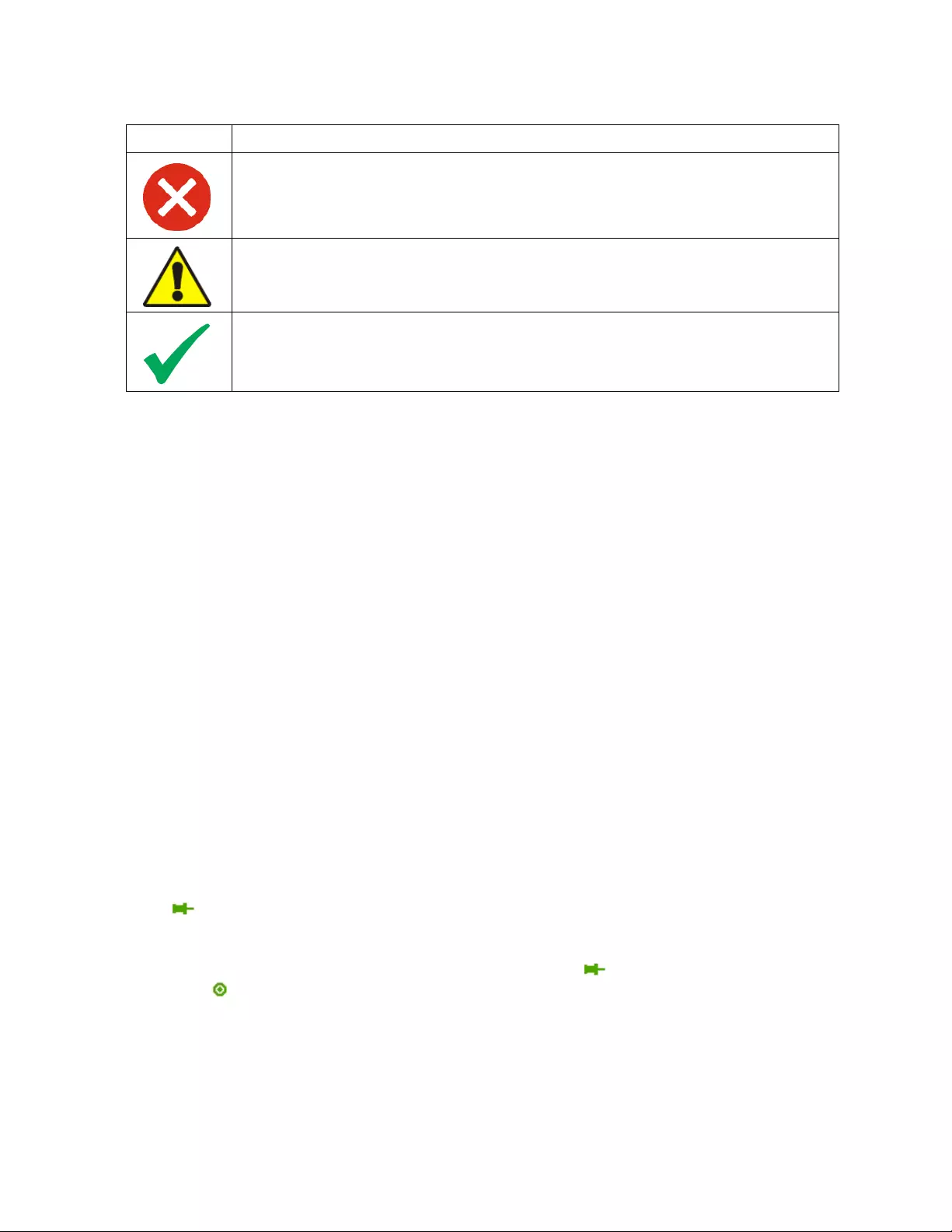
Metered Rack PDU66
Device status icons
One or more icons and accompanying text indicate the current operating status of the Rack PDU:
At the upper right corner of every page, the web interface displays the same icons currently
displayed on the Home page to report Rack PDU status:
• The No Alarms icon if no alarms exist.
• One or both of the other icons ( Critical and Warning) if any alarms exist, and af ter each
icon, the number of active alarms of that severity.
Quick Links
At the lower left on each page of the interface, the re are three configurable links. By default, the links
access the URLs for these Web pages:
• Link 1: The home page of Schneider Electric’s web site
• Link 2: Demonstrations of Schneider Electric Web-enabled products
• Link 3: Information on Schneider Electric Remote Monitoring Service
Located in the upper right hand corner of each page:
• User name (click to change user preferences)
• Language (if available, click to change language preference)
• Log Off (click to log the current user off of the web interface)
• Help (click to view help contents)
• (click to set the current web page to be the log in home page)
Example:
Log In Home: To make any screen the “home” screen (i.e., the screen that d isp lays f irst
when you log on), go to that screen, and click the icon in the top right corner.
Click to revert to displaying the Home screen when you log on.
Symbol Description
Critical: A critical alarm exists, which requires immediate action.
Warning: An alarm condition requires attention and could jeopardize your data or
equipment if its cause is not addressed.
No Alarms: No alarms are present, and the Rack PDU an d NM C are op er at ing
normally.
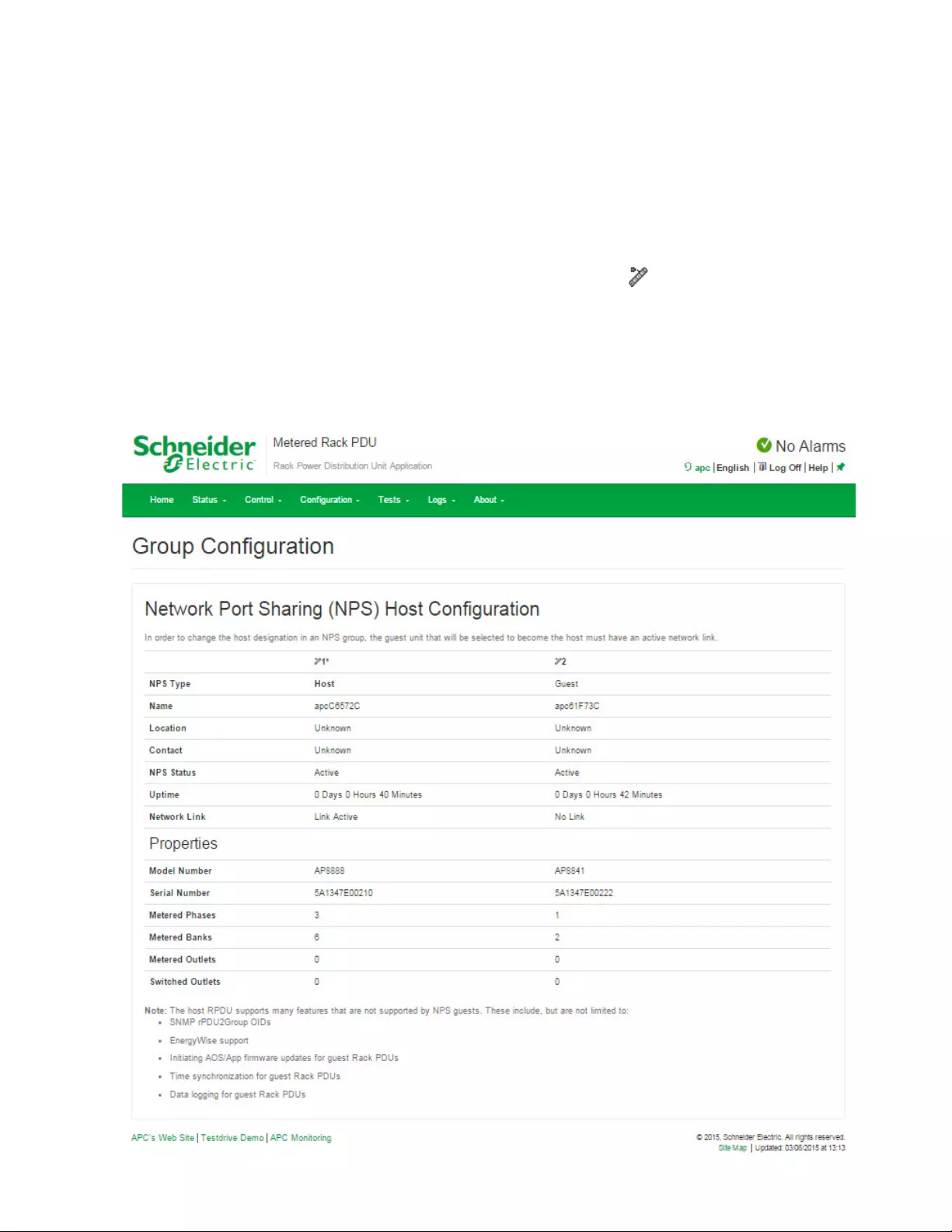
67 Metered Rack PDU
Network Port Sharing (NPS) on the Web User
Interface (UI)
Group Control using Network Port Sharing
The web interface of the Rack PDU will have additional capabilities if the Rack PDU is part of an
NPS group. This includes an NPS Group S t atus web page and an NPS Group Configuration p age. In
addition, for web pages that support NPS Rack PDUs, the user can select a different Rack PDU in
the group to view by selecting the Rack PDU Display ID of the unit he or she would like to view.
Each Rack PDU in the NPS group is denoted with a Rack PDU icon followed by its Display ID (1
to 4). The Rack PDU that the user is logged into is displayed with an additional asterisk (*) following
the Display ID.
Note: The Reset/Reboot web p age has ma ny additional reset/reboo t options for Rack PDU group s.
These include individual Rack PDU reset t o default s, individual Rack PDU rebooting , and clearing of
guest PDU lost communication alarms by removing the guests from the group.
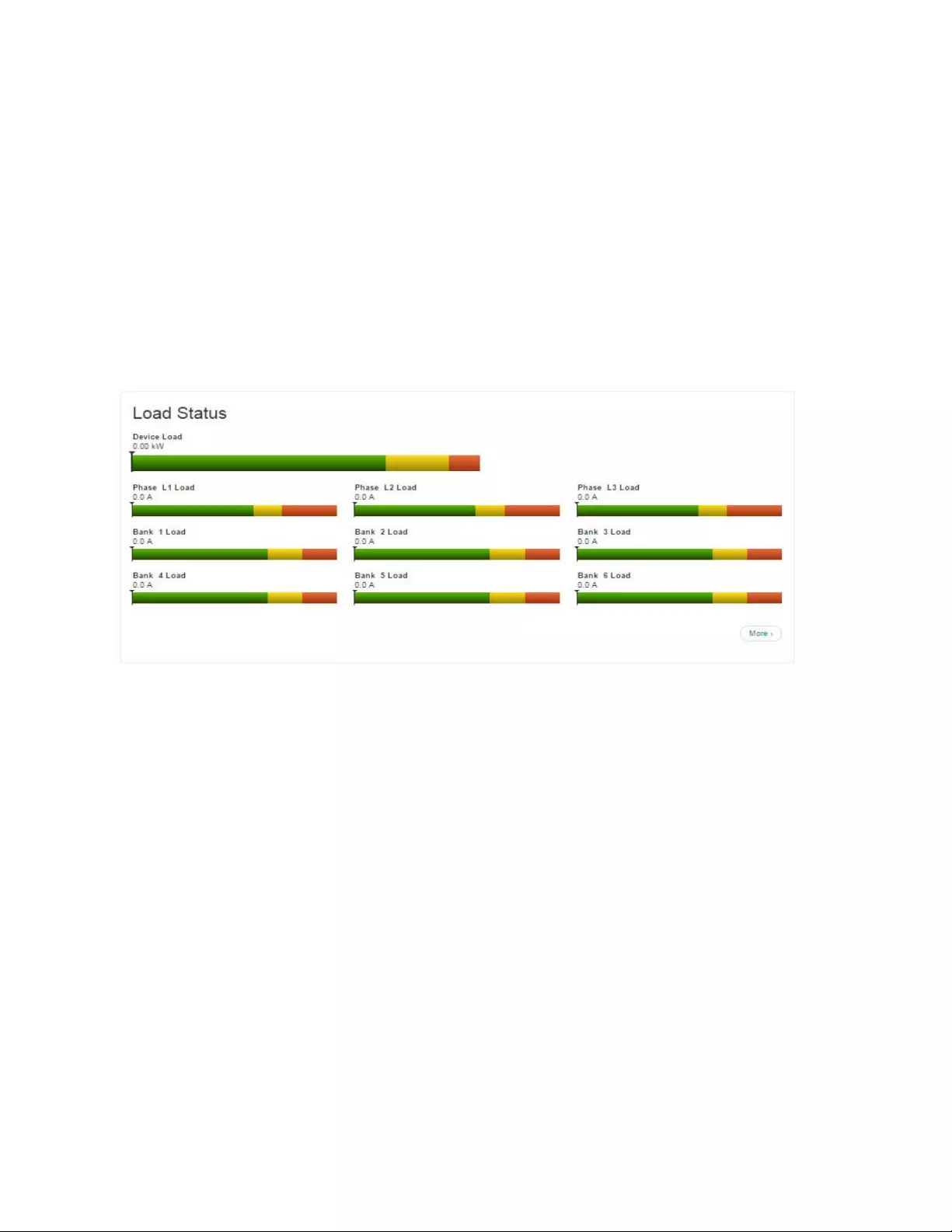
Metered Rack PDU68
About Home
The Home page contains the following information: Active Alarms, Load Status and Recent Device
Events. Active Alarms will show if any alarms exist. If no alarms exist, a green check mark with the
words ”No Alarms Present” will show. The Load Status shows a colored bar demonstrating the level
of the Bank, Phase and Device loads. To see the Device Status select the More link at the bottom of
the list.The Recent Device Events box will list the five most recent device Events by the device by
Date, Time and Event.
The Overview view
In the Load Status area, view the load for the device in kW and for the phases and banks in amps,
as applicable. The green, yellow, and red meter shows the current load status: normal, near
overload, or overload.
Note: If a low load threshold was configured the meter will also include a blue segment to the left of
the green.
In the Rack PDU Parameters box the reader will find the Name, Location, Contact, Model Number,
Rating, User (type of user account accessing the Rack PDU) and Uptime (the amount of time the
Rack PDU has been operating since the last reboot from either a power cycle or a reboot of the
Management Interface).
In the Recent Device Events box are the Events which have occurred most recently and the dates
and times they occurred. A maximum of five Events are shown at one time. Click More Event s to go
to the Logs tab to view the entire event log.
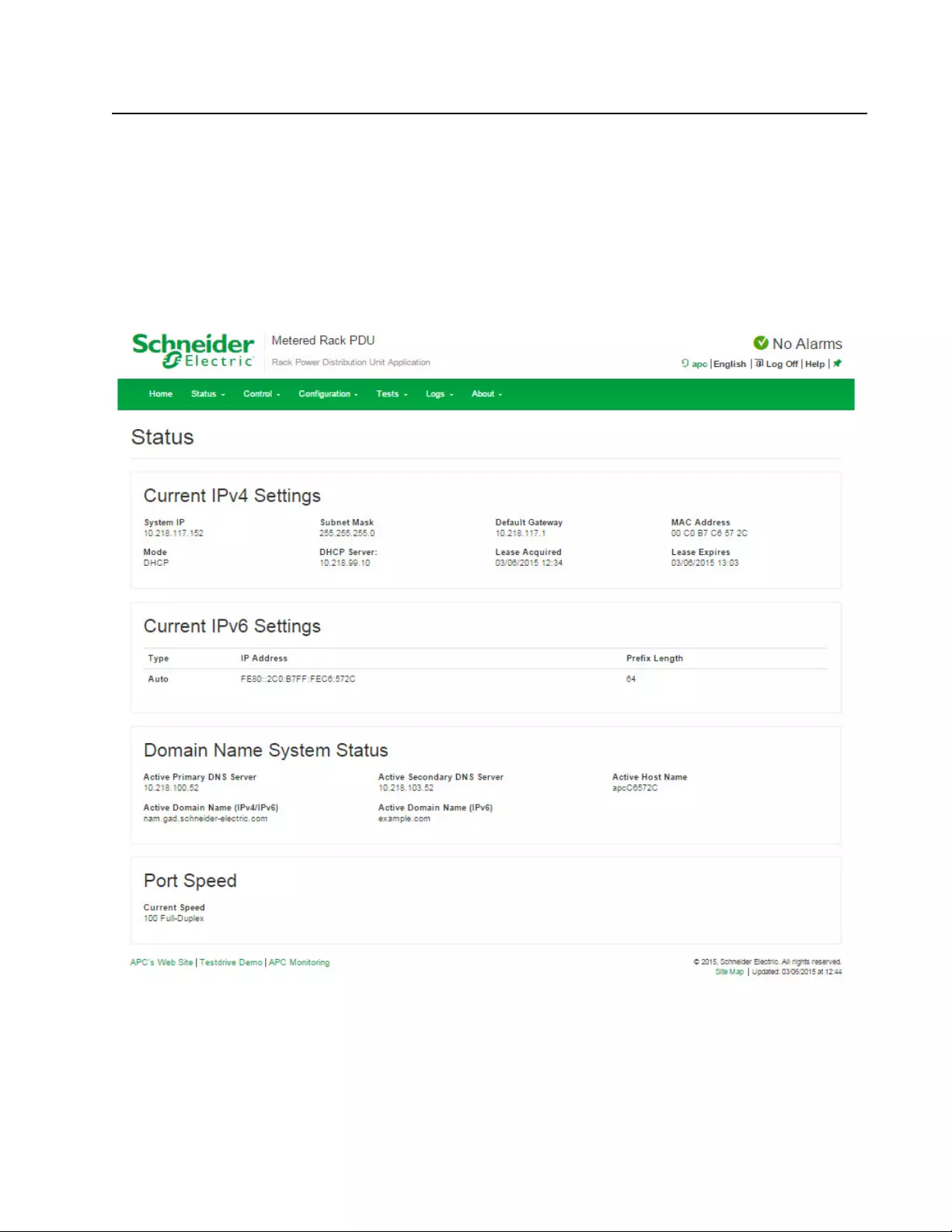
69 Metered Rack PDU
Status Tab
About the Status Tab
Use the Status tab to:
• View the load status for the Rack PDU and Network Status
• Under the Rack PDU tab readers can scroll and access: Alarms, Device, Phase, Bank,
and Environment.
• Under the Network tab the reader can view the current IPv4 and IPv6 settings.

Metered Rack PDU70
View the Load Status and Peak Load
Path: Status > RPDU
Alarms: Lists Device Alarm Status.
Group: Network Port sharing Group Status. List the Properties, Metering and firmware version
information. Change Host RPDU can be accessed from its link at the bottom of the page.
Device: Shows status of device. Lists Status, Properties and Configuration information.
Phase: Shows Phase Status. The phase settings can also be configured via a Configure Phase
Settings link at the bottom of the page. Configuration can be changed as well.
Bank: Shows bank status. List current size and demonstrates range on a colored red, green and
yellow sliding bar. The bank settings can be changed via a Configure Bank status link at the bottom
of the page.
Environment: Shows Alarm Status, Temperature, Humidity and can configure Temperature and
Humidity Configuration after pressing the Configure link.
View the Network Status
Path: Status > Network
The Network screen displays information about your network.
Current IPv4 Settings
System IPThe IP address of the unit.
Subnet MaskThe IP address of the sub-network.
Default GatewayThe IP address of the router used to connect to the network.
MAC AddressThe MAC address of the unit.
ModeHow the IPv4 settings are assigned: Manual, DHCP, or BOOTP.
DHCP ServerThe IP address of the DHCP server. This is only displayed if Mode is DHCP.
Lease AcquiredThe date/time that the IP address was accepted from the DHCP server.
Lease ExpiresThe date/time that the IP address accepted from the DHCP server expires and will
need to be renewed.
Current IPv6 Settings
TypeHow the IPv6 settings are assigned.
IP AddressThe IP address of the unit.
Prefix LengthThe range of addresses for the sub-network.
Domain Name System Status
Active Primary DNS Server The IP address of the primary DNS server.
Active Secondary DNS ServerThe IP address of the secondary DNS server.
Active Host NameThe host name of the active DNS server.
Active Domain Name (IPv4/IPv6)The IPv4/IPv6 domain name that is currently in use.
Active Domain Name (IPv6)The IPv6 domain name that is currently in use.
Ethernet Port Speed
Current Speed. The current speed assigned to the Ethernet port.

71 Metered Rack PDU
Control
The Control menu options enable you to take immediate actions affecting active user management
and the security of your network.
Managing User Sessions
Path: Control > Security > Session Management
The Session Management menu displays all active u sers currently connected to the RPDU. To view
Information about a given user, click their user name. The Session Details screen displays basic
information about the user including what interface they are logged-in to, their IP address, and user
authentication. There is also an option to Terminate Session for the user.
Resetting the Network Interface
Path: Control > Network > Reset/Reboot
This menu gives you the option to reset and reboot various components of the network interface.
Users have the option to Reboot Management Interface,
Note: Rebooting the Management Interface only restarts the Rack PDU’s Network Management
Interface.
Reset All: Clear the Ex clude TCP/IP checkbox to reset all configuration values; mark the Exclude
TCP/IP checkbox to reset all values except TCP/IP.
Reset Only: (Resetting may take up to a minute) Options include:
• TCP/IP settings: Set TCP/IP Configuration to DHCP & BOOTP, its default setting,
request requiring tha t the Rack PDU receive it s TCP/IP settings from a DHCP or BOOTP
server. See “View the result of the test DNS in the Last Query Response field.”
• Event configuration: Reset all changes to event configuration, by event and by group,
to their default settings.
• Guest PDU lost communication alarms by removing corresponding guest Rack PDUs.
• Host Display ID and Remove all Guest Rack PDUs.
• RPDU to Defaults.
• For NPS groups:
Guest PDU lost Communication alarms by removing corresponding guest Rack PDUs.
Host Display ID and remove all guest Rack PDUs
Host to Defaults
Guest to Defaults
Guest Management Interface (Reboot)
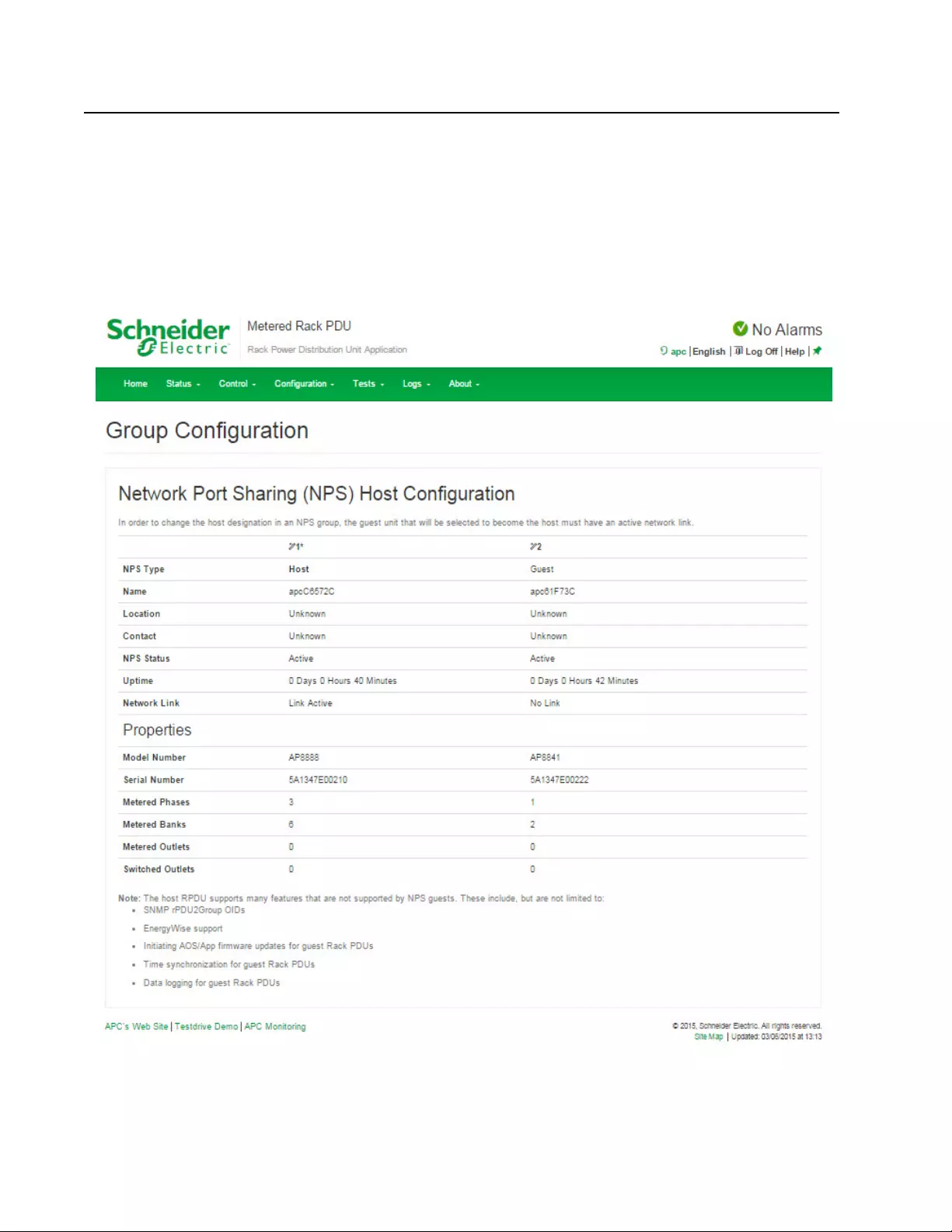
Metered Rack PDU72
Configuration
About the Configuration Tab
Under the Configuration tab, several menu options are available to make changes to the
Rack PDUs.
• Configure a name and location for the Rack PDU
• Click user-configurable links to open web pages for specific devices connected to the
Rack PDU

73 Metered Rack PDU
Configure Load Thresholds
Path: Main > Configuration > RPDU
View the load for the device, phases, and banks. The indicator in the green, yellow, and red meter
shows the current load status: normal, near overload, or overload. If a low load threshold was
configured, the meter will include a blue segment to the left of the green. When viewing the Device
Load, the triangle above the meter indicates peak load.
Note: The Rack PDU generates an alarm when any bank exceeds its rated value. However, if a
circuit breaker trips, there is no definitive indication that the circuit breaker is open, other than that
the current for that bank will drop. Set the Low Load Warning to 1 amp for these reasons:
• The default setting for the Low Load Warning is 0 amps. This effectively disables the
warning. With a setting of 0 amps for the Low Load Warning, the web interface will not
indicate that a circuit breaker may have tripped.
• A 1 amp detection threshold for the Low Load Warning for Bank Load Management will
help to indicate that a circuit breaker may have tripped.
To configure load thresholds
1. To configure load thresholds for the device, phases, or banks, make a selection from the
Configuration > RPDU > Device and Phase and Bank drop-down menu.
2. Set Overload Alarm, Near Overload Warning, and Low Load Warning thresholds.
3. Click Apply to save your settings.
Configure RPDU Name and Location
Path: Configuration > RPDU > Device
The name and location you enter will appear on the Home tab.
1. Enter a name and location and contact.
2. Click Apply to save.
Reset Peak Load and kWh
Path: Configuration > RPDU > Device
1. Click the Configuration tab, then RPDU, then Device.
2. Click the Peak Load and Kilowatt-Hours check boxes as desired.
3. Click Apply.

Metered Rack PDU74
Configure Temperature and Humidity Sensors
Path: Configuration > RPDU > Environment
Note: To use this feature, you must have installed an optional Schneider Electric Temperature
Sensor (AP9335T) or Schneider Electric Temperature/Humidity Sensor (AP9335TH) to your Rack
PDU.
For temperature:
• If the high temperature threshold is reached, the system generates a Warning alarm.
• If the maximum temperature threshold is reach ed, th e system generates a Critical alarm.
Similarly, for humidity:
• If the low humidity threshold is reached, the system generates a Warning alarm.
• If the minimum humidity threshold is reached, the system generates a Critical alarm.
Note: Click the thermometer symbol in the upper right corner to toggle between
Fahrenheit and Celsius.
To configure temperature and humidity sensors:
1. Enter values for minimum, maximum, high, and low thresholds.
2. Enter Hysteresis values.
3. Enable alarm generation as desired.
4. Click Apply.
Hysteresis This value specifies how far pa st a threshold the temperature or humid ity must return to
clear a threshold violation.
• For Maximum and High temperature threshold violations, the clearing point is the
threshold minus the hysteresis.
• For Minimum and Low humidity threshold violations, the clearing point is the threshold
plus the hysteresis.
Increase the value for Temperature Hysteresis or Humidity Hysteresis to avoid multiple alarms if
temperature or humidity that has caused a violation then wavers slightly up and down. If the
hysteresis value is too low, such wavering can cause and clear a threshold violation repeatedly.
Example of rising but wavering temperature: The maximum temperature threshold is 85°F, and
the temperature hysteresis is 3°F. The temperature rises above 85°F, violating the threshold. It then
wavers down to 84°F and then up to 86°F repeatedly, but no clearing event and no new violation
occur. For the existing violation to clear, the temperature would have to drop to 82°F (3°F below the
threshold).
Example of falling but wavering humidity: The minimum humidity threshold is 18%, and the
humidity hysteresis is 8%. The humidity falls below 18%, violating t he threshold. It then wavers up to
24% and down to 13% repe atedly, but no clearing event and no new violation occu r. For the existing
violation to clear, the humidity would have to rise to above 26% (8% past the threshold).

75 Metered Rack PDU
Security
Session Management screen
Path: Configuration > Security > Se ssion Management
Enabling Allow Concurre nt Logins means that two or more users can log on at the same time.
Each user has equal access and each interface (HTTP, FTP, telnet console, serial console (CLI),
etc.) counts as a logged-in user.
Remote Authentication Override: The Rack PDU supports Radius storage of p asswo rds on a se rver.
However, if you enable this override, the Rack PDU will allow a local user to log on using the
password for the Rack PDU that is stored locally on the Rack PDU. See also “Local Users” and
“Remote Users authentication”.
Ping Response
Path: Configuration > Security > Ping Response
Select the Enable check box for IPv4 Ping Response to allow the Rack PDU to respon d to network
pings. Clear the check box to disable an Rack PDU response. This does not apply to IPv6.
Local Users
Use These menu options to view, and to set up access and individual preferences (like displayed
date format), to the Rack PDU user interfaces. This applies to users as defined by their logon name.
Path: Configuration > Security > Local Users > Management
Setting user access With this option an Administrator or Super User can list and configure the
users allowed access to the UI. The Super User user account always has access to the Rack PDU.
Click on Add User to add a user. On the resulting User Configuration screen, you can add a user
and withhold access by clearing the Access check box. User names and passwords are case-
sensitive. The maximum length for both the name and password is 64 bytes, with less for multi-byte
characters. You have to enter a password. Blank p asswords, (passwords wit h no characters) are not
allowed.
Note: Values greater than 64 bytes in Name and Password might get truncated. To change an
Administrator/Super User setting, you must enter all three password fields.
Use Session T imeout to configure the t ime (3 minutes by default) that the UI wait s before logging off
an inactive user. If you change this value, you must log off for the change to take effect.
Note: This timer continues to run if a user closes the browser window without first logging Off by
clicking Log Off at the upper rig ht.Because tha t user is still considered to be logged on, no user can
log on until the time specified as Minutes of Inactivity expires. For example, with the default value
for Minutes of Inactivity, if a user closes the browser window without logging of f, no user can log on
for 3 minutes.
Serial Remote Authentication Override By selecting this option, you can byp ass RADIUS by using
the serial console (CLI) connection. This screen enables it for the selected user, but it must also be
enabled globally to work, (through the “Session Management” screen).

Metered Rack PDU76
Default settings Determine the default values to populate in each of the fields when the Super User
or Administrator-level account creates a ne w user. These values can be changed before the settings
are applied to the system.
• Access: Put a check in the Enable box to allow access.
• User Type: Select the user type from the dropdown menu.
• User Description: Type the user Description in the box.
• Session Timeout: Select from 1 to 60 seconds.
• Bad Login Attempts. Set the number of failed login attempts the user can have. Select
from 0 to 99 attempts. 0= unlimited.
User Preferences This option is enabled by default.
• Event Log Color Coding: Mark the checkbox to enable color-coding of alarm text
recorded in the event log. System event entries and configuration change entries do not
change color.
• Change the default temperature scale: Select the temperature scale, US Customary
(Fahrenheit) or Metric (Celsius), in which to display all temperature measurements in
this user interface.
• Export Log Format: Configure which format the event log should be displayed in when
exported (downloaded). Tab (default) allows fields to be tab-delimited whereas CSV is
comma-separated.
• Date Format: Select the numerical format in which to display all dates in this user
interface. In the selections, each letter m (for month), d (for day), and y (for year)
represents one digit. Single-digit days and months are displayed with a leading zero.
• Language: Select the user interface display languages from the drop-down box.
Password Requirements
• Strong Passwords: Configure whether new passwords created for user accounts will
require additional rules such as at least one lowercase character, one uppercase
character, one number, and one symbol.
• Password Policy: Select the duration (in days) to which the user will be required to
change their password. A value of 0 days disables this feature (by default).
Text Color Alarm Severity
Red Critical: A critical alarm exists, which requires imme diate action.
Orange Warning: An alarm condition requires attention and could jeopardize
your data or equipment if its cause is not addr essed.
Green Alarm Cleared: The conditions that caused the alarm have improved.
Black Normal: No alarms are present. The Rack PDU and all connected
devices are operating normally.

77 Metered Rack PDU
Remote Users
Authentication Specify how you want users to be authenticated at logon.
Path: Configuration > Security > Remote Users > Authentication
For information about local authentication (not using the centralized authentication of a RADIUS
server), see the Security Handbook, available at www.schneider-electric.com.
The authentication and authorization functions of RADIUS (Remote Authentication Dial-In User
Service) is supported.
• When a user accesses the Rack PDU or ot her network-enabled device that has RADIUS
enabled, an authentication request is sent to the RADIUS server to determine the User
permission level.
• RADIUS user names used with the Rack PDU are limited to 32 characters.
Select one of the following:
• Local Authentication Only: RADIUS is disabled. Local authentication is enabled.
• RADIUS, then Local Authentication: RADIUS and local authentication are enabled.
Authentication is requested from the RADIUS server first. If the RADIUS server fails to
respond, local authentication is used.
• RADIUS Only: RADIUS is enabled. Local authentication is disabled.
Note: If RADIUS Only is selected, and the RADIUS server is unavailable, or improperly
configured, remote access is unavailable to all users. You must use a serial connection
to the command line interface and change the access setting to local or radiusLocal to
regain access. For example, the command to change the access setting to local would
be: radius -a local
RADIUS
Path: Configuration > Security > Remote Users > RADIUS
Use this option to do the following:
• List the RADIUS servers (a maximum of two) available to th e Rack PDU and the time-out
period for each.
• Click on a link, and configure the p arameters for authentication by a new RADIUS server.
• Click a listed RADIUS server to display and modify its parameters.
RADIUS Setting Definition
RADIUS Server The server name or IP address (IPv4 or IPv6) of the RADIUS server.
Click on a link to configure the server.
Note: RADIUS servers use port 1812 by default to authenticate users.
The Rack PDU supports ports 1812, 5000 to 32768.
Secret The shared secret between the RADIUS server and the Rack PDU.
Reply Timeout The time in seconds that the Rack PDU waits for a response from the
RADIUS server.
Test Settings Enter the Administrator user name and password to test the RADIUS
server path that you have configured.
Skip Test and Apply Do not test the RADIUS server path. (Not recommended)

Metered Rack PDU78
Configure the RADIUS Server
Summary of the configuration procedure
You must configure your RADIUS server to work with the Rack PDU.
For examples of the RADIUS users file with Vendor Specific Attributes (VSAs) and an example of an
entry in the dictionary file on the RADIUS server, see the Security Handbook.
1. Add the IP address of the Rack PDU to the RADIUS server client list (file).
2. Users must be configured with Service-Type attributes unless Vendor S pecific Attribut es
(VSAs) are defined. If no Service-Type attributes are configured, users will have read-
only access (on the Web interface only).
See your RADIUS server documentation for information about the RADIUS users file,
and see the Security Handbook for an example.
3. VSAs can be used instead of the Service-Type attributes provided by the RADIUS
server. VSAs require a dictionary entry and a RADIUS users file. In the dictionary file,
define the names for the ATTRIBUTE and VALUE keywords, but not for the numeric
values. If you change numeric values, RADIUS authentication a nd authorization will fail.
VSAs take precedence over standard RADIUS attributes.
Configuring a RADIUS server on UNIX® with shadow pass words
If UNIX shadow password files are used (/etc/p asswd) with the RADIUS dictionary files, the following
two methods can be used to authenticate users:
• If all UNIX users have administrative privileges, add the following to the RADIUS “user”
file. To allow only Device Users, change the APC-Service-Type to Device.
DEFAULT Auth-Type = System
APC-Service-Type = Admin
• Add user names and attributes to the RADIUS “user” file, and verify the password
against /etc/passwd. The following example is for users bconners and thawk:
bconners Auth-Type = System
APC-Service-Type = Admin
thawk Auth-Type = System
APC-Service-Type = Device
Supported RADIUS servers
FreeRADIUS and Microsoft IAS 2003 are supported. Other commonly available RADIUS
applications may work but have not been fully tested.
RADIUS and Network Port Sharing
Note: See the Security Handbook for Network Management Cards for more information on using
RADIUS.

79 Metered Rack PDU
Firewall Menus
Path: Configuration > Security > Firewall
Configuration Enable or disable the overall firewall functionality. Any configured policy is also
listed, even if the firewall is disabled.
Active Policy Select an active policy from the available firewall policies. The validity of policy is also
listed here.
Active Rules When a firewall is enabled, this lists the individual rules that are being enforced by a
current active policy. You can edit existing rules and add or delete new rules here.
Create/Edit Policy Create a new policy or edit an existing one.
Load Policy Load a policy (with .fwl suffix) from a source external to this device.
Test Temporarily enforce the rules of a chosen policy for a time that you specify.

Metered Rack PDU80
Network Features
TCP/IP and Communication Settings
TCP/IP
Path: Configuration > Network > TCP/IP
The TCP/IP option on the left navigation menu, selected by default when you choose Network on
the top menu bar, displays the current IPv4 address, subnet mask, default gateway, MAC address,
and boot mode of the Rack PDU. For information on DHCP and DHCP options, see RFC2131 and
RFC2132.
Setting Description
Enable Enable or disable IPv4 with this check box.
Manual Configure IPv4 manually by entering the IP address, subnet mask, and default gateway.
BOOTP A BOOTP server provides the TCP/IP settings. At 32-second intervals, the Rack PDU
requests network assignment from any BOOTP server:
• If the Rack PDU receives a valid response, it starts the network services.
• If the Rack PDU finds a BOOTP server, but a request to that server fails or times out, the
Rack PDU stops requesting network settings until it is restarted.
• By default, if previously config ured network settings exist, and the Rack PDU receives no
valid response to five requests (the original and four retrie s), it uses the previously
configured settings so that it remains accessible.
Click Next>> to access the BOOTP Configuration page to change the number of retries or
the action to take if all retries fail :1
•Maximum retries: Enter the number of retries that will occur when no valid response is
received, or zero (0) for an unlimited number of retries.
•If retries fail: Select Use prior settings (the default) or Stop BOOTP request.
DHCP The default setting. At 32-second intervals, the Rack PDU requests network assignment
from any DHCP server.
• If the Rack PDU receives a valid response, it does not (as previous ly) require the APC
cookie from the DHCP server in order to accept the lease and start the network services.
• If the Rack PDU finds a DHCP server, but the request to that server fails or times out, it
stops requesting network settings until it is restarted.1
•Require vendor specific coo kie to accept DHCP Address: By selecting this check box,
you can require the DHCP server to provide a cookie which supplies information to the
Rack PDU.
1. The default values for these three settings on the configuration pages generally do not need to be
changed:
•Vendor Class: APC
•Client ID: The MAC address of the Rack PDU, which uniquely identifies it on the local area ne twork
(LAN)
•User Class: The name of the application firmware module

81 Metered Rack PDU
DHCP response options
Each valid DHCP response contains options that provide the TCP/IP settings that the Rack PDU
needs to operate on a network, and other information that affects the operation of the Rack PDU.
Vendor Specific Information (option 43) The Rack PDU uses this option in a DHCP response to
determine whether the DHCP response is valid. This option contains an APC-specific option in a
TAG/LEN/DATA format, called the APC Cookie. This is disabled by default.
• APC Cookie. Tag 1, Len 4, Data “1APC”
Option 43 communicates to the Rack PDU that a DHCP server is configured to service devices.
Following, in hexadecimal format, is an e xample of a V endor S pecific Information option that contains
the APC cookie:
Option 43 = 0x01 0x04 0x31 0x41 0x50 0x43
TCP/IP options The Rack PDU uses the following options within a valid DHCP response to define
its TCP/IP settings. All of these options except the first are described in RFC2132.
• IP Address (from the yiaddr field of the DHCP response, described in RFC2131): The
IP address that the DHCP server is leasing to the Rack PDU.
• Subnet Mask (option 1): Th e Subnet Mask value that the Rack PDU needs to operate on
the network.
• Router, i.e., Default Gateway (option 3): The default gateway address that the Rack
PDU needs to operate on the network.
• IP Address Lease Time (op tion 51): The time duratio n for the lease of the IP Address to
the Rack PDU.
• Renewal Time, T1 (option 58): The time that the Rack PDU must wait after an IP
address lease is assigned before it can request a renewal of that lease.
• Rebinding Time, T2 (option 59): The time that the Rack PDU must wait after an IP
address lease is assigned before it can seek to rebind that lease.
Other options The Rack PDU also uses these options within a valid DHCP response. All of these
options except the last are described in RFC2132.
• Network Time Protocol Servers (option 42): Up to two NTP servers (primary and
secondary) that the Rack PDU can use.
• Time Offset (option 2): The offset of the Rack PDU's subnet, in seconds, from
Coordinated Universal Time (UTC).
• Domain Name Server (option 6): Up to two Domain Name System (DNS) servers
(primary and secondary) that the Rack PDU can use.
• Host Name (option 12): The host name that the Rack PDU will use (32-character
maximum length).
• Domain Name (option 15): The domain name that the Rack PDU will use (64-character
maximum length).
• Boot File Name (from the file field of the DHCP response, described in RFC2131): The
fully qualified directory-pa th t o a user configuration file (.ini file) to download. The siaddr
field of the DHCP response specifies the IP address of the server from which the Rack
PDU will download the .ini file. After the download, the .ini file is used as a boot file to
reconfigure the settings.

Metered Rack PDU82
Path: Configuration > Network > TCP/IP > IPv6 settings
Port Speed
Path: Configuration > Network > Port Speed
The Port Speed setting defines the communication speed of the TCP/IP port.
• For Auto-negotiation (the default), Ethernet devices negotiat e to transmit at the highest
possible speed, but if the supported speeds of two devices are unmatched, the slower
speed is used.
• Alternatively, you can choose 10 Mbps or 100 Mbps, each with the option of half-duplex
(communication in only one direction at a time) or full-duplex (communication in both
directions on the same channel simultaneously).
Setting Description
Enable Enable or disable IPv6 with this check box.
Manual Configure IPv6 manually by entering the IP address and the default gateway.
Auto
Configuration When the Auto Configuration check box is selected, the system obtains addressing
prefixes from the router (if available). It uses those prefixes to automatically configure
IPv6 addresses.
DHCPv6
Mode Router Controlled: Selecting this option means that DHCPv6 is controlled by the
Managed(M) and Other(O) flags received in IPv6 router advertisements. When a
router advertisement is received, the NMC checks whether the M or the O flag is set.
The NMC interprets the state of the M (Managed Address Configuration Flag) and O
(Other Stateful Configuration Flag) "bits" for the following cases:
•Neither is set: Indicates the local network has no DHCPv6 infrastructure. The NMC
uses router adv er tise m en ts and man ua l configuration to get addresses that are not
link-local and other settings.
•M, or M and O are set: In this situation, full DHCPv6 address configuration occurs.
DHCPv6 is used to obtain addresses AND other configuration settings. This is known
as DHCPv6 stateful. Once the M flag has been received, the DHCPv6 address
configuration stays in effect until the interface in question has been closed. This is
true even if subsequent router advertisement packets are received in which the M
flag is not set.
If an O flag is rec eived first, then an M flag is receiv ed subsequently, the NMC
performs full address configuration upon receipt of the M flag
•Only O is set: In this situation, the NMC sends a DHCP v6 Info-Request packet.
DHCPv6 will be used to configure “other” settings (such as location of DNS servers),
but NOT to provide addresses. This is known as DHCPv6 stateless.
Address and Other Information: With this radio box selected, DHCPv6 is used to
obtain addresses AND other configuration settings. This is known as DHCPv6
stateful.
Non-Address Informat ion Only: With this radio box selected, DHCPv6 will be used
to configure "other" settings (such as location of DNS servers), but NOT to provide
addresses. This is known as DHCPv6 stateless.
Never: Select this to disable DHCPv6.

83 Metered Rack PDU
DNS
Path: Configuration > Network > DNS > Configuration
Use the options under Configuration to configure and test the Domain Name System (DNS):
• Override Manual DNS Settings: Selection of Override Manual DNS Settings will result
in configuration data from other sources (typically DHCP) taking precedence over the
manual configurations set here.
• Select Primary DNS Server or Secondary DNS Server to specify the IPv4 or IPv6
addresses of the primary and optional secondary DNS server. For the Rack PDU to send
e-mail, you must at least define the IP address of the primary DNS server.
– The Rack PDU wait s up to 15 seconds for a response from the primary DNS server or
secondary DNS server (if specified). If the Rack PDU does not receive a response
within that time, e-mail cannot be sent. Use DNS servers on the same segment as the
Rack PDU or on a nearby segment (but not across a wide-area network [WAN]).
– Define the IP addresses of the DNS servers then enter the DNS name of a computer
on your network to look up the IP address for that computer to verify correct
operation.
• System Name Synchronization: Allow the system name to be synchronized with the
host name so both fields automatically contain the same value.
Note: When enabling this feature, the system name identifier can no longer contain a
space character (since it will be synchronized to the host name field).
• Host Name: Configure a host name here and a domain name in the Domain Name field
then users can enter a host name in any field in the NMC interface (except e-mail
addresses) that accepts a domain name.
• Domain Name (IPv4/IPv6): Configure the domain name here only. In all other fields in
the NMC interface (except e-mail addresses) that accept domain names, the Rack PDU
adds this domain name when only a host name is entered.
– To override all instances of the expansion of a specified host name by the addition of
the domain name, set the domain name field to its default, somedomain.com, or to
0.0.0.0.
– To override the expa nsion of a spe cific ho st na me e ntry, include a trailing period. The
NMC recognizes a host name with a trailing period (such as mySnmpServer.) as if it
were a fully-qualified domain name and does not append the domain name.
• Domain Name (IPv6): Specify the IPv6 domain name here.
Test
Path: Configuration > Network > DNS > Test
Use this option to send a DNS query that tests the setup of your DNS servers by looking up the IP
address. View the result of a test in the Last Query Response field.
• Select test to send a DNS query that tests the setup of your DNS servers:
–As Query Question, identify the value to be used for the selected query type:
Query Type Selected Query Question to Use
by Host The URL
by FQDN The fully qualified domain name, my_server.my_domain
by IP The IP address
by MX The Mail Exchange address

Metered Rack PDU84
Web
Path: Configuration > Network > Web > Configuration
Option Description
access To activate changes to any of these selections, log of f from the Rack PDU:
•Disable: Disables access to the Web interfac e. (To re-enable access, log in to the
command line inte r fac e, the n typ e th e com m a nd http -S enable. For HTTPS
access, type https -S enable.)
•Enable HTTP (the default): Enables Hypertext Transfer Protocol (HTTP), which
provides Web access by user name and password, but does not encrypt user names,
passwords, and data during transmission.
•Enable HTTPS: Enables Hypertext Transfer Protocol (HTTPS) over Secure Sockets
Layer (SSL). SSL encrypts user names, passwords, and data during transmission, and
authenticates the Rack PDU by digital certificate. When HTTPS is enabled, your
browser displays a small lock icon.
See “Creating and Installing Digital Certificates” in the Security Hand bo o k, available at
www.schneider-electric.com.
HTTP Port: The TCP/IP port (80 by default) used to communicate by HTTP with the Rack
PDU.
HTTPS Port: The TCP/IP port (443 by default) used to co mmunicate by HTTPS with the
Rack PDU.
For either of these port s, yo u can change the po rt setting to a ny unused port from 5000 to
32768 for additional security. Users must then use a colon (:) in the address field of the
browser to specify the port number. For example, for a port number of 5000 and an IP
address of 152.214.12.114:
http://152.214.12.114:5000
https://152.214.12.114:5000
ssl
certificate Add, replace, or remove a security certificate.
Status:
•Not installed: A certificate is not installed, or was installed by FTP or SCP to an
incorrect location. Using Add or Replace Certificate File installs the certificate to the
correct location, /ssl on the Rack PDU.
•Generating: The Rack PDU is generating a certificate because no valid certificate was
found.
•Loading: A certificate is being activated on the Rack PDU.
•Valid certi ficate : A valid certificate was installed or was generated by the Rack PDU.
Click on this link to view the contents of the certificate.
If you install an invalid certificate, or if no certificate is loaded when you enable
SSL, the Rack PDU generates a default certificate, a process which delays access
to the interface for up to one minute. You can use the default certificate for basic
encryption-based security, but a security alert message displays whenever you log on.
Add or Replace Certificate File: Enter or browse to the certificate file created with the
Security Wizard.
See “Creating and Installing Digital Certificates” in the Security Handbook, available at
www.schneider-electric.com, to choose a method for using digital certificates created
by the Security Wizard or generated by the Rack PDU.
Remove: Delete the current certificate.

85 Metered Rack PDU
Console
Path: Configuration > Network > Console >
options
Note: To use SSH, you must have an SSH client installed. Most Linux and other UNIX platforms
include an SSH client, but Microsoft Windows operating systems do not. Clients are available from
various vendors.
Option Description
access • Disable: Disables all access to the command line interface.
•Enable Telnet (the default): Telnet transmits user names, passwords, and data without
encryption.
•Enable SSH: SSH transmits user names, passwords, and data in encrypted form,
providing protection from attempts to intercept, forge, or alter data during transmission.
Configure the ports to be used by these protocols:
•Telnet Port: The Telnet port used to com m u nic ate with the Ra ck PDU (2 3 by de fau l t).
You can change the port setting to any unused port fr om 5000 to 32768 for additional
security. Users must then use a colon (:) or a space, as required by your Telnet client
program, to specify the non-default port. For example, for port 5000 and an IP address of
152.214.12.114, your Telnet client requires one of the these commands:
telnet 152.214.12.114:5000
telnet 152.214.12.114 5000
•SSH Port: The SSH port used to communicate with the Rack PDU (22 by default). You
can change the port setting to any unused port from 5000 to 32768 for additional
security. See the documentation fo r your SSH client for the command line format
required to specify a non-d efault port.
ssh host
key Status indicates the status of the host key (private key):
•SSH Disabled: No host key in use: When disabled, SSH cannot use a host key.
•Generating: Th e Rack PDU is creating a host key b ecause no valid host key wa s found.
•Loading: A host key is being activated on the Rack PDU.
•Valid: One of the following valid host keys is in the /ssh directory (the required location
on the Rack PDU):
•A 1024-bit or 2048-bit host key created by the Security Wizard
•A 2048-bit RSA host key gene rate d by the Rack PDU
Add or Replace: Browse to and upload a host key file created by the Security Wizard.
To use the Security Wizard, see the Security Handbook, available at www.schneider-
electric.com.
Note: To reduce the time required to enab le SSH, create and upload a ho st key in
advance. If you enable SSH with no host key loaded, the Rack PDU takes up to one
minute to create a host key, and the SSH server is not accessible during that time.
Remove: Remove the current host key.

Metered Rack PDU86
SNMP
All user names, passwords, and community names for SNMP are transferred over the network as
plain text. If your network requires the high security of encryption, disable SNMP access or set the
access for each community to Rea d. (A community with Read access can receive st atus information
and use SNMP traps.)
When using StruxureWare to manage a Rack PDU on the public network, you must have SNMP
enabled in the Rack PDU interface. Read access will allow the StruxureWare to receive traps from
the Rack PDU, but Write access is required while you use the interface of the Rack PDU to set the
StruxureWare as a trap receiver.
For detailed information on enhancing and managing the security of your system, see the Security
Handbook, available at www.schneider-electric.com.
Network Port Sharing
All Rack PDUs in a group can be accessed through the Host Rack PDU via SNMP "rPDU2" OIDs
available in our PowerNet-MIB.
The full path to these OIDs is:
iso(1).org(3).dod(6).internet(1).private(4).enterprises(1).apc(318).products(1).hardware(1).rPDU2(2
6)
Individual Rack PDUs can be identified in the SNMP MIB tables by viewing the corresponding
"Module" OIDs in each table. These Module OIDs will return the Display ID of the Rack PDU.
Example Module OIDs: rPDU2IdentModule, rPDU2DeviceConfigModule,
rPDU2SensorTempHumidityConfigModule
In order to be backwards compatible with previous versions, the Host Rack PDU will always be the
first index in any ta ble that supports multiple Rack PDUs. In addition, after the Rack PDU group is set
up, the index order of guest Rack PDUs should not change even if the Display ID is changed or a
Rack PDU temporarily loses communication. The index order should only change if you manually
remove a Rack PDU from the group.
A MIB table walk should skip the indexes associated with a Rack PDU that has temporarily lost
communication.

87 Metered Rack PDU
SNMPv1
Path: Configuration > Network > SNMPv1 > options
Option Description
access Enable SNMPv1 Acces s: Enables SNMP version 1 as a method of communication with
this device.
access
control You can configure up to four access control entries to specify which Network
Management Systems (NMSs) have access to this device. The opening page for access
control, by default, assigns one entry to ea ch of the four available SNMPv1 communities,
but you can edit these settings to apply more than one entry to any com m u nity to grant
access by several specific IPv4 and IPv6 addresses, host names, or IP address masks.
To edit the access control settings for a community, click its community name.
• If you leave the default access control entry unchanged for a community, that
community has access to this device from any location on the network.
• If you configure multiple access control entries for one community name, the limit of
four entries requires that one or more of the other communities must have no access
control entry. If no access control entry is listed for a community, that community has no
access to this device.
Community Name: The name that an NMS must use to access the community. The
maximum length is 15 ASCII characters, and the de fault community names for the four
communities are public, private, public2, and private2.
NMS IP/Host Name: The IPv4 or IPv6 address, IP address mask, or host name that
controls access by NMSs. A host name or a specific IP address (such as 149.225.12.1)
allows access only by the NMS at that location. IP addresses that contain 255 restrict
access as follows:
• 149.225.12.255: Access only by an NMS on the 149.225.12 segment.
• 149.225.255.255: Access only by an NMS on the 149.225 segment.
• 149.255.255.255: Access only by an NMS on the 149 segment.
• 0.0.0.0 (the default setting) which can also be expressed as 255.255.255 .255: Access
by any NMS on any segment.
Access Type: The actions an NMS can perform through the community.
•Read: GETS only, at any time
•Write: GETS at any time, and SETS when no user is logged onto the Web inter face or
command line interface.
•Write+: GETS and SETS at any time.
•Disable: No GETS or SETS at any time.

Metered Rack PDU88
SNMPv3
Path: Configuration > Network > SNMPv3 > options
For SNMP GETs, SETs, and trap receivers, SNMPv3 use s a system of user profiles to identify users.
An SNMPv3 user must have a user profile assigned in the MIB software program to perform GETs
and SETs, browse the MIB, and receive traps.
Note: To use SNMPv3, you must have a MIB program that supports SNMPv3.
The Rack PDU supports SHA or MD5 authentication and AES or DES encryption.
Option Description
access SNMPv3 Acce ss : Enables SNMPv3 as a method of communication with this device.
user
profiles By default, lists the settings of four user profiles, configured with the user names apc
snmp profile1 through apc snmp profile4, and no authentication and no privacy (no
encryption). To edit the following settings for a user profile, click a user name in the list.
User Name: The identifier of the user profile. SNMP version 3 maps GETs, SETs, and
traps to a user profile by matching the user name of the profile to th e user name in the
data packet being transmitted. A user nam e ca n ha ve up to 32 AS CII ch aracters.
Authentication Passphrase: A phrase of 15 to 32 ASCII characters (apc auth
passphrase, by default) that verifies that the NMS communicating with this device
through SNMPv3 is the NMS it claims to be, that the message has not been changed
during transmission, and that the message was communicated in a timely manner,
indicating that it was not delaye d an d th at it was not copied and sent again later at an
inappropriate time.
Privacy Passphrase: A phrase of 15 to 32 ASCII charac te rs (apc crypt
passphrase, by default) that ensures the privacy of the dat a (by means of encryption)
that an NMS is sending to this device or receiving fro m this device through SNMPv3.
Authentication Protocol: The Schneider Electric implementation of SNMPv3 supports
SHA and MD5 authentication. Authentication will not occur unless an authentication
protocol is selected .
Privacy Protocol: The implementation of SNMPv3 supports AES and DES as the
protocols for encrypting and decrypting data. Privacy of transmitted data requires that a
privacy protocol is selected and that a privacy p assphrase is provided in the requ est from
the NMS. When a privacy protocol is enabled but the NMS does not provide a privacy
passphrase, the SNMP req uest is not encrypted.
Note: You cannot select the privacy protocol if no authentication protocol is selected.

89 Metered Rack PDU
FTP Server
Path: Configuration > Network > FTP Server
The FTP Server setting s enable (by default) or disable access to the FTP server and specify the TCP/
IP port (21 by default) that the FTP server uses to communicate with the Rack PDU. The FTP server
uses both the specified port and the port one number lower than the specified port.
You can change the Port setting to the number of any unused port from 5001 to 32768 for added
security. Users must then use a colon (:) to specify the non-default port number. For example, for
port 5001 and IP address 152.214.12.114, the command would be ftp 152.214.12.114:5001.
Note: FTP transfers files without encryption. For higher security, disable the FTP server , and transfer
files with SCP. Selecting and configuring Secure SHell (SSH) enables SCP automatically.
At any time that you want a Rack PDU to be accessible for management by StruxureWare, FTP
Server must be enabled in the Rack PDU interface.
For detailed information on enhancing and managing the security of your system, see the Security
Handbook, available at www.schneider-electric.com.
access
control You can configure up to four access control entries to specify which NMSs have access to
this device. The ope ning p age for access co ntrol, by default, assigns one entry to each o f
the four user profiles, but you can edit these settings to apply more tha n one en try to a ny
user profile to grant access by several specific IP addresses, host names, or IP address
masks.
• If you leave the default access control entry unchanged for a user profile, all NMSs that
use that profile have access to this device.
• If you configure multiple access entries for one user profile, the limit of four entries
requires that one or more of the other user profiles must have no access control entry. If
no access control entr y is listed fo r a user p r o file, no NMS th at uses that profile has any
access to this device.
To edit the access control settings for a user profile, click it s user name.
Access: Mark the Enable checkbox to activate the access control specified by the
parameters in this access control entry.
User Name: From the drop-down list, select the user profile to which this access control
entry will apply. The choices available are the four user names that you configure through
the user profiles option on the left navigation menu.
NMS IP/Host Name: The IP address, IP address mask, or host name that controls
access by the NMS. A host name or a specific IP address (such as 149.225.12.1) allows
access only by the NMS at that location. An IP address mask that contains 255 restricts
access as follows:
• 149.225.12.255: Access only by an NMS on the 149.225.12 segment.
• 149.225.255.255: Access only by an NMS on the 149.225 segment.
• 149.255.255.255: Access only by an NMS on the 149 segment.
• 0.0.0.0 (the default setting) which can also be expressed as 255.255.255.255: Access
by any NMS on any segment.
Option Description

Metered Rack PDU90
Notifications
Event Actions
Path: Configuration > Notification
Types of notification
You can configure event actions to occur in response to an event or group of events. These actions
notify users of the event in any of several ways:
• Active, automatic notification. The specified users or monitoring devices are contacted
directly.
– E-mail notification
–SNMP traps
– Remote Monitoring Service
– Syslog notification
• Indirect notification
– Event log. If no direct notification is configured, users must check the log to determine
which events have occurred
You can also log system performance data to use for device monitoring. See “Logs in
the Configuration Menu” on page 98 for information on how to configure and use this
data logging option.
– Queries (SNMP GETs)
For more information, see “SNMP” on page 86. SNMP enables an NMS to perform
informational queries. For SNMPv1, which does not encrypt dat a before transmission,
configuring the most restrictive SNMP acce ss type (READ) enables informational
queries without the risk of allowing remote configuration changes.
Configure event actions
Path: Configuration > Notification > Event Actions > By Event
By default, logging an event is selected for all events. To define event actions for an individual event:
1. To find an event, click on a column heading to see the lists under the Device Ev ents or
System Events categories.
Or you can click on a sub-category under these headings, like Security or
Temperature.
2. Click on the event name to view or change the current configuration, such as recipients
to be notified by e-mail, or Network Management Systems (NMSs) to be notified by
SNMP traps.
If no Syslog server is configured, items related to Syslog config uration are not displayed.
Note: When viewing details of an event configuration, you can enable or disable event logging or
Syslog, or disable notification for specific e-mail recipients or trap receivers, but you cannot add or
remove recipients or receivers. To add or remove recipients or receivers, see the following:
• “Identifying Syslog servers” on page 98
• “Path: Configuration > Notification > E-mail > Recipients” on page 93
• “Path: Configuration > Notification > SNMP Traps > Trap Receivers” on page 94

91 Metered Rack PDU
Path: Configuration > Notification > Event Actions > By Group
To configure a group of events simultaneously:
1. Select how to group events for configuration:
– Select Events by Severity, and then select one or more severity levels. You cannot
change the severity of an event.
– Select Events by Category, and then select all events in one or more pre-defined
categories.
2. Click Next to move to the next screen to do the following:
a. Select event actions for the group of events.
• To select any action excep t Logging (the default), you must first have at least one
relevant recipient or receiver configured.
• If you selected Logging and have configured a Syslog server, select Event Log
or Syslog on the next screen. See “Logs in the Configuration Menu” on page 98
3. Click Next to move to the next screen to do the following:
a. If you selected Logging on the previous screen, select Enable Notifications or
Disable Notification.
b. If you selected Email Recipients on the previous screen, select the e-mail
recipients to configure.
c. If you selected Trap Receivers on the previous screen, select the trap receiver to
configure.
4. Click Next to move to the next screen to do the following:
a. If you are configuring Logging settings, view the pending actions and click Apply
to accept the changes or click Cancel to revert to the previous settings.
b. If you are configuring Email Recipients or Trap Receivers, select Enable
Notifications or Disable Notification and set the notification timing settings (see
“Notification parameters” on page 92 for more information on these settings).
5. Click Next to move to the next screen to do the following:
a. V iew the p ending actions a nd click Apply to accept the changes or click Cancel to
revert to the previous settings.

Metered Rack PDU92
Notification parameters. These configuration fields define e-mail parameters for sending
notifications of events.
They are usually accessed by clicking the receiver or recipient name.
Note: For events that have an associated clearing event, you can also set these parameters.
E-mail notification screens
Use Simple Mail Transfer Protocol (SMTP) to send e-mail to up to four recipients when an event
occurs. To use the e-mail feature, you must define the following settings:
• The IP addresses of the primary and, optionally, the secondary Domain Name System
(DNS) servers.
• The IP address or DNS name for the SMTP Server and From Address.
• The e-mail addresses for a maximum of four recipients.
• You can use the To Address setting of the recipients o ption to send e-mail to a text-based
screen.
Path: Configuration > Notification > E-mail > Server
This screen lists your primary and secondary DNS servers and displays the following fields:
From Address. The contents of the From field in e-mail messages sent by the RPDU:
• In the format user@ [IP_address] (if an IP address is specified as Local SMTP Server)
• In the format user@domain (if DNS is configured and the DNS name is specified as
Local SMTP Server) in the e-mail messages.
Note: The local SMTP server may require that you use a valid user account on the
server for this setting. See the server documentation.
SMTP Server. The IPv4/ IPv6 address or DNS name of the local SMTP server.
Note: This definition is required only when the SMTP server is set to Local.
Authentication. Enable this if the SMTP server requires authentication.
Port. The SMTP port number, with a default of 25. The range is 25, 465, 587, 5000 to 32768.
User Name, Password, and Confirm Password. If your mail server requires authentication, enter
your user name and password here. This performs a simple authentication, not SSL.
Field Description
Delay n time before
sending If the event persists for the specified time, the notification is sent. If the
condition clears before the time expires, no notification is sent.
Repeat at an interval of n The notification is sent repe atedly at the specified interval (the default is
every 2 minutes until the condition clears).
Up to n times During an active event, the notification repeats for this number of times.
or
Until condition clears The notification is sent repeatedly until the condition clears or is
resolved.

93 Metered Rack PDU
Use SSL/TLS. Select when encryption is used.
• Never: The SMTP server does not require nor support encryption.
• If Supported: The SMTP server advertises support for STARTTLS but doesn't require
the connection to be encrypted. The STARTTLS command is sent after the
advertisement is given.
• Always: The SMTP server requires the STARTTLS command to be sent on connection
to it.
• Implicitly: The SMTP server only accepts connections that begin encrypted. No
STARTTLS message is sent to the server.
Require CA Root Certificate. This should only be enabled if the security policy of your organization
does not allow for implicit trust of SSL con nections. If this is enab led, a valid root CA certificate must
be loaded onto the RPDU for encrypted e-mails to be sent.
File Name. This field is dependent on the root CA certificates installed on the RPDU and whether or
not a root CA certificate is required.
Path: Configuration > Notification > E-mail > Recipients
Specify up to four e-mail recipients. Click on a name to configure the settings.
Generation Enables (default) or disables sending e-mail to the recipient.
To Address The user and domain names of the recipient. To use e-mail for paging, use the e-mail
address for the recipient’s pager gateway account (for example, myacct100@skytel.com). The
pager gateway will generate the page.
To bypass the DNS lookup of the IP address of the mail server, use the IP address in brackets
instead of the e-mail domain name, e.g., use jsmith@[xxx.xxx.x.xxx] instead of
jsmith@company.com. This is useful when DNS lookups are not working correctly.
Language The language which the e-mail notification will be sent in. This is dependent on the
installed language pack (if applicable).
Port The SMTP port number, with a default of 25. The range is 25, 465, 587, 5000 to 32768.
Format: The long format cont ains name, location , contact, IP address, serial number of the device,
date and time, event code, and event description. The short format provides only the event
description.
Server Select one of the following methods for routing e-mail:
• Local: This is through the site-local SMTP server. This recommended setting ensures
that the e-mail is sent using the site-local SMTP server. Choosing this setting limits
delays and network outages and retries sending e-mail for many hours. When choosing
the Local setting you must also enable forwarding at the SMTP server of your device and
set up a special external e-mail account to receive the forwarded e-mail. Check with your
SMTP server administrator before making these changes.
• Recipient: This is the SMTP server of the recipient. The RPDU performs an MX record
look-up on the recipients e-mail ad dress and uses that as its SMTP server. The e-mail is
only sent once so it could easily be lost.
• Custom: This setting enables each e-mail recipient to have its own server settings.
These settings are independent of the settings given under “SMTP Server” above.

Metered Rack PDU94
Path: Configuration > Notification > E-mail > SSL Certificates
Load a mail SSL certificate on the RPDU for greater security. The file must have an extension of
.crt or .cer. Up to five files can be loaded at any given time.
When installed, the certificate details also display here. An invalid certificate will display “n/a” for all
fields except File Name.
Certificates can be deleted using this screen. Any e-mail recipients using the certificate should be
manually modified to remove reference to this certificate.
Path: Configuration > Notification > E-mail > Test
Send a test message to a configured recipient.
SNMP trap receiver screen
Path: Configuration > Notification > SNMP Traps > Trap Receivers
With Simple Network Management Protocol (SNMP) trap s, you can automatically get notifications for
significant RPDU events. They are a useful tool for monitoring devices on your network.
The trap receivers are displayed by NMS IP/Host Name, where NMS stands for Network
Management System. You can configure up to six trap receivers.
To configure a new trap receiver, click Add Trap Receiver. To edit (or delete) one, click its IP
address/host name.
Trap Generation. Enable (the default) or disable trap generation for this trap receiver.
NMS IP/Host Name. The IPv4/ IPv6 address or host name of this trap receiver. The default, 0.0.0.0,
leaves the trap receiver undefined.
Language. Select a language from the drop-d own list. This can dif fer from the UI and from other trap
receivers.
Select either the SNMPv1 or SNMPv3 radio button to specify the trap type. For an NMS to receive
both types of trap s, you must sep arately con figure two trap receivers for that NMS, one for each trap
type.
SNMPv1. Settings for SNMPv1.
• Community Name: The name (“public” by default) used as an identifier when SNMPv1
traps are sent to this trap receiver.
• Authenticate T r ap s: When this option is enabled (the default), the NMS identified by the
NMS IP/Host Name setting will receive authentication traps (traps generated by invalid
attempts to log on to this device).
SNMPv3. Settings for SNMPv3.
• User Name: Select the identifier of the user profile for this trap receiver.
If you delete a trap receiver, all notification settings configured under “Configuring event actions” for
the deleted trap receiver are set to their default values.

95 Metered Rack PDU
SNMP traps test screen
Path: Configuration > Notification > SNMP Traps > Test
Last Test Result. The result of the most recent SNMP trap test. A successful SNMP trap test verifies
only that a trap was sent; it does not verify that the trap was received by the selected trap receiver. A
trap test succeeds if all of the following are true:
• The SNMP version (SNMPv1 or SNMPv3) configured for the selected trap receiver is
enabled on this device.
• The trap receiver itself is enabled.
• If a host name is selected for the To address, that host na me can be mapped to a valid IP
address.
To. Select the IP address or host name to which a test SNMP trap will be sent. If no trap receiver is
configured, a link to the Trap Receiver configuration screen is displayed.
Remote Monitoring Service
Path: Configuration > Notification > Remote Monitoring
The remote monitoring service (RMS) is an optional service from Schneider Electric that monitors
your system from a remote operation center 24 hours a day, 7 days a week, and notifies you of
device and system events.
To purchase the RMS service, contact your vendor or click on the link on the top part of this screen:
Schneider Electric RMS Web site.
Registration. To activate Schneider Electric RMS for the Rack PDU, select Enable Remote
Monitoring Service., choose between Register Comp any and Device and Register Devi ce Only,
complete the form, and click Send APC RMS Registration.
Use the Reset Remote Monitoring Service Registration check box to discontinue the service,
whether permanently or temporarily (for example, if you are moving a Rack PDU).

Metered Rack PDU96
General Menu
This menu cont ains misc ellaneous configuration items inclu ding device identificatio n, date and time,
exporting and importing your RPDU configuration options, the three links at the bottom left of the
screen, and consolidating data for troubleshooting purposes.
Identification screen
Path: Configuration > General > Identification
Define the Name, the Location (the physical location), and the Contact (the person responsible for
the device) used by:
• the SNMP agent of the RPDU and
• StruxureWare
S pecifically, the name field is used by the sysName, sysContact, and sysLocation object identifiers
(OIDs) in the SNMP agent of the Rack PDU. For more information about MIB-II OIDs, see the
PowerNet® SNMP Management Information Base (MIB) Reference Guide, available at
www.schneider-electric.com.
The Name and Location fields also identify the de vice when you regist er for the Re mote Monitorin g
Service.
Host Name Synchronization allows the host name to be synchronized with the system name so
both fields automatically contain the same value.
Note: When enabling this feature, the system name identifier can no longer contain a space
character (since it will be synchronized to the host name field).
System Message When defined, a custom message will appear on the log on screen for all users.
Date/T ime screen
Path: Configuration > General > Date/Time > Mode
Set the time and date used by the RPDU. You can chan ge the current settings manually or th rough a
Network Ti me Protocol (NTP) Server:
With both, you select the Time Zone. This is your local time difference with Coordinated Universal
Time (UTC), also known as Greenwich Mean Time (GMT).
Manual Mode. Do one of the following:
• Enter the date and time for the RPDU
• Select the check box Apply Local Computer Ti me to apply the date and time settings of
the computer you are using
Synchronize with NTP Server. Have an NTP (Network Time Protocol) Server define the date and
time for the RPDU. By default, any RPDU on the private side of a StruxureWare obtains its time
settings by using StruxureWare as an NTP server.
• Override Manual NTP Settings: If you select this, data from other sources (typically
DHCP) take precedence over the NTP configurations you set here.
• Primary NTP Server: Enter the IP address or domain name of the primary NTP server.
• Secondary NTP Server: Enter the IP address or domain name of the secondary NTP
server, when a secondary server is available.
• Update Interval: Define, in hours, how often the RPDU accesses the NTP Server for an
update. Minimum: 1; Maximum: 8760 (1 year).
• Update Using NTP Now: Initiate an immediate update of the date and time by the NTP
Server.

97 Metered Rack PDU
Daylight Saving
Path: Configuration > General > Date /Time > Daylight Saving
Daylight Saving Time (DST) is disabled by default. You can enable traditional United States DST, or
enable and configure a customized daylight saving time to match how Daylight Saving Time is
implemented in your local area.
When customizing DST, the system puts the clock forward by an hour when the time and date you
specify under Start is reached and puts the clock back an hour when the time and date you specify
under End is reached.
• If your local DST always start s or ends on th e fourth occurrence of a specific weekday of
a month (e.g., the fourth Sunday), choose Fourth/Last. If a fifth Sunday occurs in that
month, you should still choose Fourth/Last.
• If your local DST always start s or ends on the last occurrence of a specific wee kday of a
month, whether it is the fourth or the fifth occurrence, choose Fifth/Last.
Creatin g a n d importing sett ings with the config file
Path: Configuration > General > User Config File
Use the settings from one Rack PDU to configure another. Retrieve the config.ini file from the
configured Rack PDU, customize that file (e.g., change the IP address), and upload the customized
file to the new Rack PDU. The file name can be up to 64 characters, and must have the.ini suffix.
To retrieve and customize the file of a configured Rack PDU, see “How to Export Configuration
Settings” on page 109.
Instead of uploading the file to one Rack PDU, you can export the file to multiple Rack PDUs by
using an FTP or SCP script.
Configure Links
Path: Configuration > General > Quick Links
Select the Configuration tab, General on the top menu bar, and Quick Links on the left navigation
menu to view and change the URL links displayed at the bottom left of each page of the interface.
By default, these links access the following Web pages:
• Link 1: The home page of the Schneider Electric web site.
• Link 2: A page where you can use samples of Web-enabled products.
• Link 3: The home page of the Schneider Electric Remote Monitoring Service.
Status Reports the progress of the upload. The upload succeeds even if the file contains errors,
but a system event reports the errors in the event log.
Upload Browse to the customized file and upload it so that the current Rack PDU can use it to set
its own configuration.
Download Allows the download of the Configuration File (config.ini) file directly through the web
browser to the user's computer.

Metered Rack PDU98
Logs in the Configuration Menu
Identifying Syslog servers
Path: Configuration > Logs > Syslog > Servers
Click Add Server to configure a new Syslog server.
Syslog Server. Uses IPv4/ IPv6 addresses or host names to identify from one to four servers to
receive Syslog messages sent by the Rack PDU.
Port. The port that the Rack PDU will use to send Syslo g messages. The d efault UDP port assigned
to Syslog is 514.
Language. Select the language for any Syslog messages.
Protocol. Select either UDP or TCP.
Syslog settings
Path: Configuration > Logs > Syslog > Settings
Message Generation. Enable the generation and the logging of Syslog messages for events that
have Syslog configured as a notification method.
Facility Code. Selects the facility code assigned to the Syslog messages of the RPDU (User, by
default).
Note: User best defines the Syslog messages sent by the Rack PDU. Do not change this selection
unless advised to do so by the Syslog network or system administrator.
Severity Mapping. This section maps each severity level of the RPDU or environment events to
available Syslog priorities. The local options are Critical, Warning, and Informational. You should
not need to change the mappings.
• Emergency: The system is unusable
• Alert: Action must be taken immediately
• Critical: Critical conditions
• Error: Error conditions
• Warning: Warning conditions
• Notice: Normal but significant conditions
• Informational: Informational messages
• Debug: Debug-level messages
The following are the default settings for the Local Priority settings:
• Critical is mapped to Critical
• Warning is mapped to Warning
• Informational is mapped to Info

99 Metered Rack PDU
Syslog test and format example
Path: Configuration > Logs > Syslog > Test
Send a test message to the Syslog servers (configured through the “Identifying Syslog servers”
option above). The result will be sent to all configured Syslog servers.
Select a severity to assign to the test message and then define the test message. Format the
message to consist of the event type (for example, APC, System, or Device) followed by a colon, a
space, and the event text. The message can have a maximum of 50 characters.
• The priority (PRI): the Syslog priority assigned to the message event, and the facility
code of messages sent by the RPDU.
• The Header: a time stamp and the IP address of the RPDU.
• The message (MSG) part:
• The TAG field, followed by a colon and space, identifies the event type.
• The CONTENT field is the event text, followed (optionally) by a space and the event
code.
Example: APC: Test Syslog is valid.
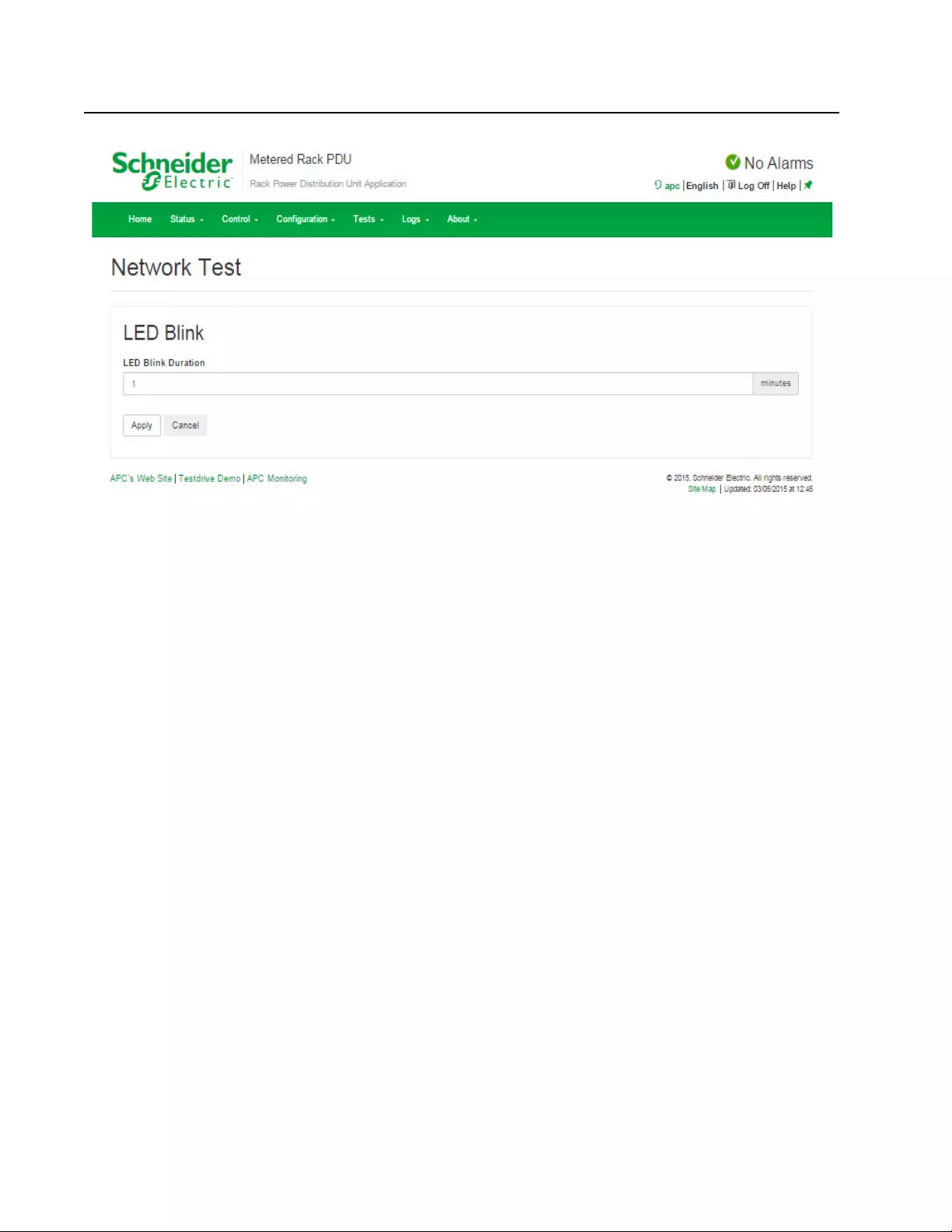
Metered Rack PDU100
Tests Tab
Setting the RPDU LCD or LED Lights to Blink
Path: Tests > Network > LED Blink
If you are having trouble finding your Rack PDU, enter a number of minutes in the LED Blink
Duration field, click Apply, and the Status and Link LED lights on the display will blink.
Path: Tests > RPDU > LCD Blink
Under this menu, you can enter a number of minutes in the LCD Blink Duration field, click Apply
and the LCD backlight will begin blinking.
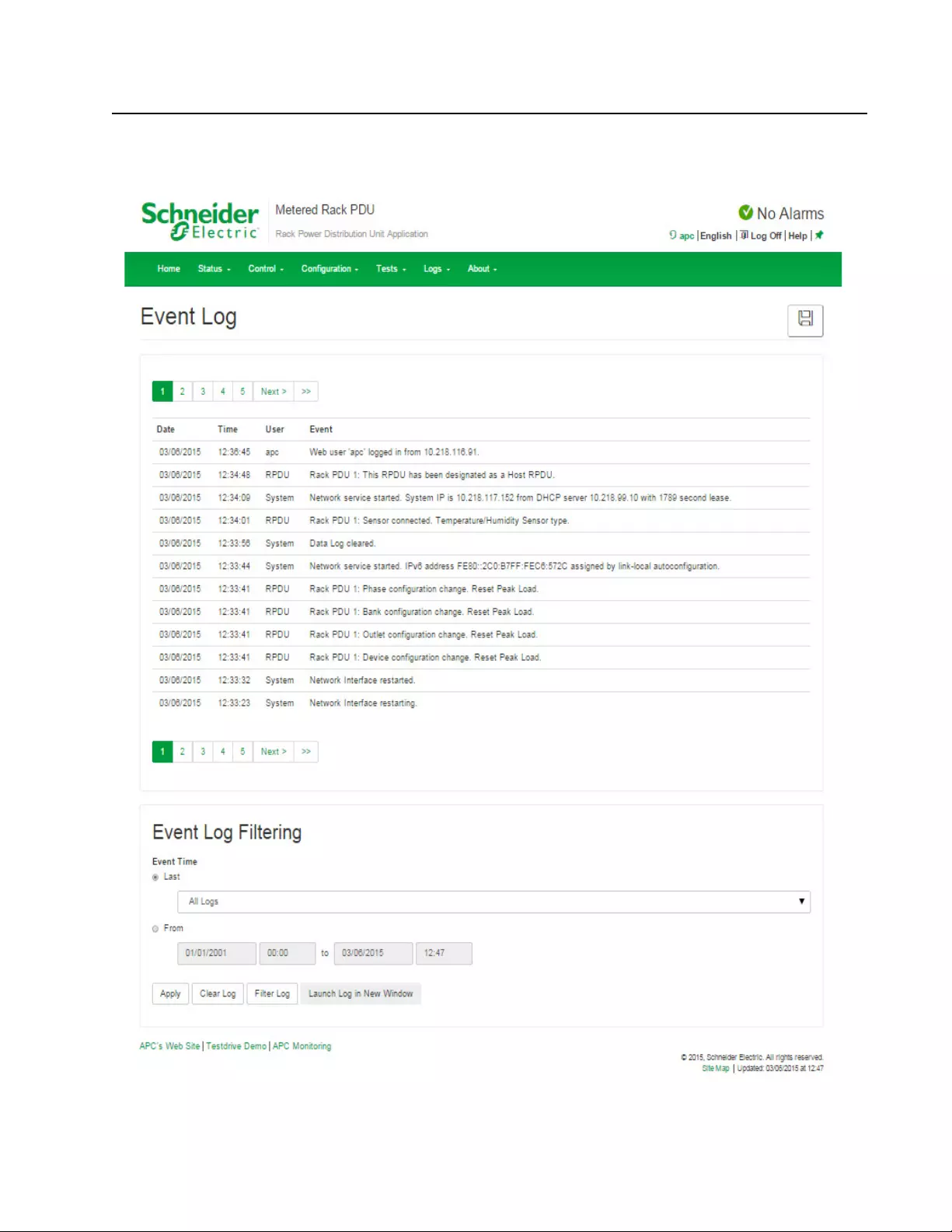
101 Metered Rack PDU
Logs Tab
Event, Data and Firewall Logs

Metered Rack PDU102
Event log
Path: Logs > Events
By default, the log displays all events recorded during the last two days, starting with the latest
events.
Additionally, the log records any event that sends an SNMP trap, except SNMP authentication
failures, and abnormal internal system events.
You can enable color coding for events on the Configuration > Security > Local Users
Management screen.
Path: Logs > Events > Log
By default, the event log displays the most recent event s first. To see the events listed together on a
Web page, click Launch Log in New Window.
To open the log in a text file or to save th e log to disk, click on the flop py disk icon( ) on the same
line as the Event Log heading.
You can also use FTP or Secure CoPy (SCP) to view the event log. See “Use FTP or SCP to retrieve
log files” on page 105.
Filtering event logs. Use filtering to omit information you don’t want to display.
• Filtering the log by date or time: Use the Last or From radio buttons. (The filter
configuration is saved until the RPDU restarts.)
• Filtering the log by event severity or category:
–Click Filter Log.
– Clear a check box to remove it from view.
– After you click Apply, text at the upper right corner of the Event Log page indicates
that a filter is active. The filter is active until you clear it or until the RPDU restarts.
• Removing an active filter:
–Click Filter Log.
–Click Clear Filter (Show All).
– As Administrator, click Save As Default to save this filter as the new default log view
for all users.
Important points on filtering:
• Events are processed through the filter using OR logic. If you apply a filter, it works
regardless of the other filters.
• Events that you cleared in the Filter By Severity list never display in the filtered Event
Log, even if selected in the Filter by Category list.
• Similarly, events that you clear in the Filter by Category list never display in the filtered
Event Log.
Deleting event logs. To delete all events, click Clear Log. Deleted events cannot be retrieved.
To disable the logging of events based on their assigned severity level or their event category, see
“Configure event actions” on page 90
Path: Logs > Events > Reverse Lookup
With reverse lookup enabled, when a network-related event occurs, both the IP address and the
domain name for the networked device with the event a re logged in the event log. If no domain name
entry exists for the device, only its IP address is logged with the event.
Since domain names generally change less frequently than IP addresses, enabling reverse lookup
can improve the ability to identify addresses of networked devices that are causing events.
Reverse lookup is disabled by default. You should not need to enable it if you have no DNS server
configured or have poor network performance because of heavy network traffic.

103 Metered Rack PDU
Path: Logs > Events > Size
Use Event Log Size to specify the maximum number of log entries.
Note: When you resize the event log in order to specify a maximum size, all existing log entries are
deleted. When the log subsequently reaches the maximum size, the older entries are deleted.
Network Port Sharing event logs and traps
Rack PDU events from guest PDUs are sent to the host PDU for inclu sio n into it s log. The log ent ry
will include the Display ID of the unit that the event occurred on.
These events are then handled the same as local events from the host PDU. Therefore alarms,
SNMP traps, e-mails, Syslog, etc will support Rack PDU events and alarms f rom all Rack PDUs in a
group.
Example event log: Rack PDU 4: Device low load.
Note: System event s will only be lo gged for the host PDU. System events from guest PDUs will not
be logged on the host PDU.
Data log
Use the data log to display measurements about the Rack PDU, the power input to the Rack PDU,
and the ambient temperature of the Rack PDU.
The steps to display and resize the data log are the same as for the event log, except that you use
menu options under Data instead of Events.
Path: Logs > Data > Log
Filtering data logsUse filtering to omit information you don’t want to display. Using the Network Port
Sharing Data Log, the host Rack PDU will poll data from guest Rack PDUs so that data from all
Rack PDUs in a group are available. To view data from a different Rack PDU in a group, select the
desired Rack PDU from the "Filter Log" pull-down list.
Similarly for data log graphing, you can select a different Rack PDU by clicking on the Change Data
Filter button.
• Filtering the log by date or time: Use the Last or From radio buttons. (The filter
configuration is saved until the Rack PDU restarts.)
• Filtering the log by event severity or category:
a. Click Filter Log.
b. Clear a check box to remove it from view.
c. After y ou cl ic k Apply, text at the upper right corner of the Data Log pag e indi cates
that a filter is active. The filter is active until you clear it or until the Rack PDU
restarts.
• Removing an active filter:
d. Click Filter Log.
e. Click Clear Filter (Show All).
f. As Administrator, click Save As Default to save this filter as the new default log
view for all users.
Deleting data logs. To delete all data log records, click Clear Data Log. Deleted data log records
cannot be retrieved.

Metered Rack PDU104
Path: Logs > Data > Interval
Define, in the Log Interval setting, how frequently data is searched for and stored in the data log.
When you click Apply, the number of possible storage days is recalculated and display at the top of
the screen. When the log is full, the oldest entries are deleted.
Note: Because the interval specifies how often the data is recorded, the smaller the interval, the
more times the data is recorded and the larger the log file.
Path: Logs > Data > Graphing
Data log graphing provide s a graphical displa y of logged da ta and is an enhancement of the existing
data log feature. How the graphing enhancement displays data and how efficiently it performs will
vary depending on your computer hardware, computer operating system, and the Web browser you
use to access the interface of the unit.
Note: JavaScript® must be enabled in your browser to use the graphing feature. Alternatively, you
can use FTP or SCP to import the data log into a spreadsheet application, and graph data in the
spreadsheet
Graph Data Select the data it ems that correspond to the abbreviated column headings in the dat a log
to graph multiple data items. Hold down CTRL to select multiple items.
Graph TimeSelect Last to graph all records or to change the number of hours, days, or weeks for
which data log information is gra phed. Select a time option from the drop-down menu. Select From to
graph data logged during a specific time period.
Note: Enter time using the 24-hour clock format.
ApplyClick Apply to graph the data.
Launch Graph in New WindowClick Launch Graph in New Wi ndow to launch the data log gra ph in
a new browser window that provides a larger view of the graph.
Path: Logs > Data > Rotation
Rotation causes the contents of the data log to be appended to the file you specify by name and
location. Use this option to set up password-protection and other parameters.
• FTP Server: The IP address or host name of the server where the file will reside.
• User Name/Password: The user name with password required to send data to the
repository file. This user must also be configured to have read and write access to the
data repository file and the directory (folder) in which it is stored.
• File Path: The path to the repository file.
• Filename: The name of the repository file (an ASCII text file), e.g. datalog.txt. Any new
data is appended to this file: it does not overwrite it.
• Unique Filename: Select this check box to save the log as mmddyyyy_<filename>.txt,
where filename is what you specified in the Filename field above. Any new data is
appended to the file but each day has its own file.
• Delay n hours between uploads: The number of hours between u pload s of da ta to the
file (max. 24 hours).
• Upon failure, try uploading every n minutes: The number of minutes between
attempts to upload data to the file after a failed upload.
–Up to n times: The maximum number of times the upload will be attempted after it
fails initially.
–Until upload succeeds: Attempt to upload the file until the transfer is completed.

105 Metered Rack PDU
Path: Logs > Data > Size
Use Data Log Size to specify the maximum number of log entries.
Note: When you resize the data log in order to specify a maximum size, all existing log entries are
deleted. When the log subsequently reaches the maximum size, the older entries are deleted.
Firewall Logs
Path: Logs > Firewall
If you create a firewall policy, firewall events will be logged here.
The information in the log can be useful to help the technical support team solve problems. Log
entries contain information about the traffic and the rules action (allowed, discarded). When logged
here, these events are not logged in the main Event Log (see “Event log” on page 102).
A firewall log contains up to 50 of the most recent events. The firewall log is cleared when the
management interface reboots.
Use FTP or SCP to retrieve log files
An Administrator or Device User can use FTP or SCP to retrieve a tab-delineated event log file
(event.txt) or data log file (data.txt) and import it into a spreadsheet.
• The file reports all events or data recorded since the log was last deleted or (for th e da ta
log) truncated because it reached maximum size.
• The file includes information that the event log or data log does not display.
– The version of the file format (first field)
– The date and time the file was retrieved
– The Name, Contact, and Location values and IP address of the Rack PDU
– The unique Event Code for each recorded event (event.txt file only)
Note: The Rack PDU uses a four-digit year for log entries. You may need to select a
four-digit date format in your spreadsheet application to display all four digits.
If you are using the encryption-b ased security protoc ols for your system, use SCP to re trieve the log
file.
If you are using unencrypted authentication methods for the security of your system, use FTP to
retrieve the log file.
See the Security Handbook, a vailable at www.schneider-electric.com, for information o n available
protocols and methods for setting up the type of security you need.
To use SCP to retrieve the files
To retrieve the event.txt file, use the following command:
scp username@hostname_or_ip_address:event.txt ./event.txt
To use SCP to retrieve the data.txt file, use the following command:
scp username@hostname_or_ip_address:data.txt ./data.txt

Metered Rack PDU106
To use FTP to retrieve the event.txt or data.txt files
1. At a command prompt, type ftp and the IP address of the Rack PDU, and press ENTER.
If the Port setting for the FTP Server option (set through the Network menu of the
Administration tab) has been changed from its default (21), you must use the non-
default value in the FTP command. For Windows FTP clients, use the following
command, including spaces. (For some FTP clients, you must use a colon instead of
a space between the IP address and the port number.)
ftp>open ip_address port_number
To set a non-default port value to enhance security for the FTP Server, see “FTP
Server” on page 89. You can specify any port from 5001 to 32768.
2. Use the case-sensitive User Na me and Password for Administrator or Device User to
log on. For Administrator, apc is the default for User Name and Password. For the
Device User, the defaults are device for User Name and apc for Password.
3. Use the get command to transmit the text of a log to your local drive.
ftp>get event.txt
or
ftp>get data.txt
4. Type quit at the ftp> prompt to exit from FTP.
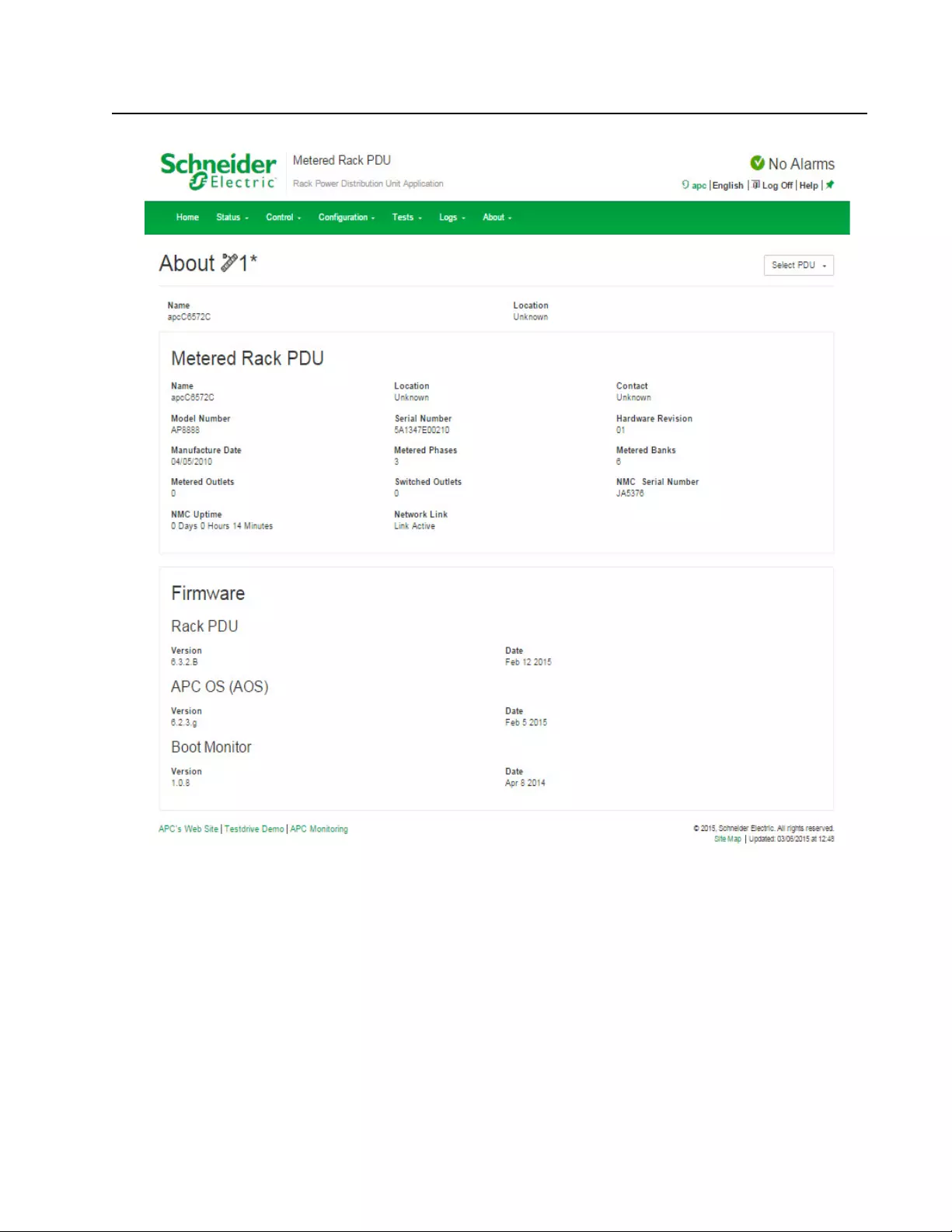
107 Metered Rack PDU
About Tab
About the Rack PDU
Path: About > RPDU/Network
The hardware information is useful to Schneider Electric Customer Support for troubleshooting
problems with the Rack PDU. The serial number and MAC address are also available on the Rack
PDU itself.
Firmware information for the Application Module, APC OS (AOS), and APC Boot Monitor indicates
the name, the firmware version, and the date and time each firmware module was created. This
information is also useful in troubleshooting and enables you to determine if updated firmware is
available at the web site, www.schneider-electric.com.
Management Uptime is the length of time the network management interface has been running
continuously.

Metered Rack PDU108
Device IP Configuration Wizard
Capabilities, Requirements, and Installation
How to use the Wizard to configure TCP/IP settings
The Device IP Configuration Wizard can discover Rack PDUs that do not have an IP address
assigned. Once discovered, you can configure the IP address settings for the cards.
You can also search for devices already on the network by entering an IP range to define t he search.
The Utility scans the IP addresses in the d efine d ran ge an d discovers Rack PDUs that already have
a DHCP-assigned IP address.
Note: For detailed information on the Utility, see the Knowledge Base on the support page of the
www.schneider-electric.com website and search for FA156064 (the ID of the relevant article).
Note: To use the DHCP Option 12 (AOS 5.1.5 or higher), see Knowledge Base ID FA156110.
System requirement s
The Device IP Configuration Wizard runs on Microsoft® Windows® 2000, Windows Server® 2003,
Windows Server® 2012, and on 32- and 64-bit versions of Windows XP, Windows Vista, Windows
2008, Windows 7, and Windows 8 operating systems.
The Device IP Configuration Wizard supports cards that have firmware versio n 3.0.x or higher and is
for IPv4 only.
Installation
To install the Device IP Configuration Wizard from a downloaded executable file
1. Go to www.schneider-electric.com.
2. Download the Device IP Configuration Wizard.
3. Run the downloaded executable file.
When installed, the Device IP Configuration Wizard is available through the Windows Start menu
options.

109 Metered Rack PDU
How to Export Configuration Settings
Retrieving and Exporting the .ini File
Summary of the procedure
A Super User/Administrator can retrieve the .ini file of a RPDU and export it to another RPDU or to
multiple Rack PDUs. The steps are below; see details in the sections following.
1. Configure a RPDU with the desired settings and export them.
2. Retrieve the .ini file from that RPDU.
3. Customize the file to change the TCP/IP settings at least.
4. Use a file transfer protocol supported by the RPDU to transfer a copy to one or more
other Rack PDUs. For a transfer to multiple Rack PDUs, use an FTP or SCP script or
the .ini file utility.
Each receiving RPDU uses the file to reconfigure its own settings and then deletes it.
Note: Managing Users via the config.ini - Users are no longer managed via the config.ini in any form.
Users are now managed via a separate file with the .csf extension. For further information on this
topic, refer to article ID FA176542 in the Knowledge Base at www.schneider-electric.com.
Contents of the .ini file
The config.ini file you retrieve from a RPDU contains the following:
• Section headings and keywords (only those supported for the particular device from
which you retrieve the file): Section headings are category names e nclosed in bracket s
([ ]). Keywords, under each section heading, are labels describing specific RPDU
settings. Each keyword is followed by an equals sign and a value (either the default or a
configured value).
• The Override keyword: With its default value, this keyword prevents the exporting of
one or more keywords and their device-specific values. For example, in the
[NetworkTCP/IP] section, the default value for Override (the MAC address of the
RPDU) blocks the exporting of values for the SystemIP, SubnetMask, DefaultGateway,
and BootMode.
.ini and Network Port Sharing
The .ini configuration utility is able to get and set values for all Rack PDUs in a group. In order to be
backwards compatible, the host Rack PDU will always be designated as first, "PDU_A". Any guest
Rack PDUs are then designated "PDU_B", "PDU_C", and "PDU_D" based on their Display ID in
ascending order. Therefore, "PDU_A" will not necessarily correlate to Display ID 1, and so on.
Note: Because of the large number of configuration values possible in a Rack PDU group, it may
take a very long time to process an INI file set. For example, a Rack PDU group of 4 units with all
values changing may take 30 minutes to complete processing.

Metered Rack PDU110
Detailed procedures
Retrieving. To set up and retrieve an .ini file to export:
1. If possible, use the interface of a RPDU to configure it with the settings to export.
(Directly editing the .ini file risks introducing errors).
2. To use FTP to retrieve config.ini from the configured RPDU:
a. Open a connection to the RPDU using its IP address:
ftp> open ip_address
b. Log on using the Super User/Administrator user name and password.
c. Retrieve the config.ini file containing the settings of the RPDU:
ftp> get config.ini
The file is written to the folder from which you launched the FTP.
To retrieve configuration settings from multiple Rack PDUs and export them to other
Rack PDUs, see Release Notes: ini File Utility, version 2.0, available at
www.schneider-electric.com
Customizing You must customize the file before you export it.
1. Use a text editor to customize the file.
– Section headings, keywords, and pre-defined values are not case-sensitive, but string
values that you define are case-sensitive.
– Use adjacent quotation marks to indicate no value. For example, LinkURL1=""
indicates that the URL is intentionally undefined.
– Enclose in quotation marks any values that contain leading or trailing spaces or are
already enclosed in quotation marks.
– To export scheduled events, configure the values directly in the .ini file.
– To export a system time with the greatest accuracy, if the receiving Rack PDUs can
access a Network Time Protocol server, configure enabled for NTPEnable:
NTPEnable=enabled
Alternatively, reduce transmission time by exporting the [SystemDate/Time] section
as a separate .ini file.
– To add comments, start each comment line with a semicolon (;).
2. Copy the customized file to another file name in the same folder:
– The file name can have up to 64 characters and must have the .ini suffix.
– Retain the original customized file fo r futu re u se. The file that you retain is the only
record of your comments.

111 Metered Rack PDU
Transferring the file to a single Rack PDU To transfer the .ini file to another Rack PDU, do either of
the following:
• From the Web UI of the receiving Rack PDU, select Configuration > General > User
Config File. Enter the full path of the file, or use Browse on your local PC.
• Use any file transfer protocol supported by Rack PDUs, i.e., FTP, FTP Client, SCP, or
TFTP. The following example uses FTP:
a. From the folder containing the copy of the customized .ini file, use FTP to log in to
the Rack PDU to which you are exporting the .ini file:
ftp> open ip_address
b. Export the copy of the customized .ini file to the root directory of the receiving
Rack PDU:
ftp> put filename.ini
Exporting the file to multiple Rack PDUs. To export the .ini file to multiple Rack PDUs:
• Use FTP or SCP, but write a script that incorporates and repeats the steps used for
exporting the file to a single Rack PDU.
• Use a batch processing file and the .ini file utility.
To create the batch file and use the utility, see Release Notes: ini File Utility, version 2.0,
available at www.schneider-electric.com.

Metered Rack PDU112
The Upload Event and Error Messages
The event and its error messages
The following event occurs when the receiving Rack PDU completes using the .ini file to update its
settings.
Configuration file upload complete, with number valid values
If a keyword, section name, or value is invalid, the upload by the receiving Rack PDU succeeds, and
additional event text states the error.
Messages in config.ini
A Rack PDU from which you downlo ad the config.ini file must be discove red successfully in order for
its configuration to be include d. If the Rack PDU is not pre sent or is not discovered, the config.ini file
contains a message under the appropriate section name, instead of keywords and values. For
example:
Rack PDU not discovered
If you did not intend to export the Rack PDU configuration as part of the .ini file import, ignore these
messages.
Errors generated by overridden values
The Override keyword and its value will generate error messages in the event log when it blocks the
exporting of values. See “Content s of the .ini file” on page 109 for information about which values are
overridden.
Because the overridden values are device-specific and not appropriate to export to other Rack
PDUs, ignore these error messages. To prevent these error messages, delete the lines that contain
the Override keyword and the lines that contain the values that they override. Do not delete or
change the line containing the section heading.
Related Topics
On Windows operating systems, instead of transferring .ini files, you can use the Device IP
Configuration Wizard to update the basic TCP/IP settings of the Rack PDU and configure other
settings through its user interface. See “Device IP Configuration Wizard” on page 108.
Event text Descriptio n
Configuration file warning:
Invalid keyword on line
number.
Configuration file warning:
Invalid value on line number.
A line with an invalid keyword or value is ignored.
Configuration file warning:
Invalid section on line
number.
If a section name is invalid, all keyword/value pairs in that
section are ignored.
Configuration file warning:
Keyword found outside of a
section on line number.
A keyword entered at the beginning of the file (i.e., befor e
any section headings) is ignored.
Configuration file warning:
Configuration file exceeds
maximum size.
If the file is too large, an incomplete upload occurs. Reduce
the size of the file, or divide it into two files, and try uploading
again.

113 Metered Rack PDU
File Transfers
Upgrading Firmware
Benefits of upgrading firmware
When you upgrade the firmware on the Rack PDU:
• You obtain the latest bug fixes and performance improvements.
• New features become available for immediate use.
Keeping the firmware versions consistent across your network ensures that all Rack PDUs support
the same features in the same manner.
Upgrading here means simply placing the module files on the RPDU; there is no installation required.
Check regularly on www.schneider-electric.com for any new upgrades
Firmware module files (Rack PDU)
A firmware release has three modules, and they must be upgraded (that is, placed on the Rack PDU)
in the same order as sho wn in the t able below. Note: It is possible to skip upgrading the bootmon file
if it is already the same version as the file located on the card
(Each module contains one or more Cyclical Redundancy Checks (CRCs) to protect its data from
corruption).
The boot monitor module, the AOS, and the application file names share the same basic format:
apc_hardware-version_type_firmware-version.bin
• apc: Indicates the context.
•
hardware-version: hw0n where n identifies the hardware version on which you can
use this file.
•
type: Identifies which module.
•
version: The version number of the file.
•
bin: Indicates that this is a binary file.
Order Module Description
1 Boot Monitor (bootmon) Roughly equivalent to the BIOS of a PC
2 American Power Conversion Operating System
(AOS) Can be considered the operating system of
the Rack PDU
3 Application Specific to the Rack PDU device type

Metered Rack PDU114
Firmware File Transfer Methods
Note: Upgrade the bootmon module first, then the AOS module, and finally, the application module
by placing them on the RPDU in that order.
Obtain the free, latest firmware version from www .schneider-electric.com. To upgrade the firmware
of one or more RPDUs, use 1 of these 5 methods:
• On a Windows operating system, use the Firmware Upgrade Utility downloaded from the
web site www.schneider-electric.com.
• On any supported operating system, use FTP or SCP to transfer the individual AOS and
application firmware modules.
• For a Rack PDU that is NOT on your network, use XMODEM through a serial connection to
transfer the individual firmware modules from your computer to the Rack PDU.
• Use a USB drive to transfer the individual firmware modules from your computer. See “How
to upgrade multiple RPDUs” on page 117.
• For upgrades to multiple RPDUs, see “Upgrading the firmware on multiple Rack PDUs” and
“Using the Firmware Upgrade Utility for multiple upgrades on Windows”.
Using the Firmware Upgrade Utility
This Firmware Upgrade Utility is part of the firmware upgrade package available on the
www.schneider-electric.com website. (Never u se an Upgrad e Utility designate d for one prod uct to
upgrade the firmware of another product).
Using the Utility for upgrades on Windows-based systems On any supported Windows operating
system, the Firmware Upgrade Utility automates the transferring of the firmware modules, in the
correct module order.
Unzip the downloaded firmware upgrade file and double-click the .exe file. Then enter the IP
address, the user name, and the password in the dialog fields and click Upgrade Now. You can use
the Ping button to test your entered details. See “How to upgrade multiple RPDUs” on page 117.
Using the Utility for manual upgrades, primarily on Linux. On non-Windows operating systems,
the Firmware Upgrade Utility extracts the individual firmware modules, but does not upgrade the
Rack PDU. See “Firmware File Transfer Methods” on page 114 for the different upgrade methods
after extraction.
To extract the firmware files:
1. After extracting files from the downloaded firmware upgrade file, run the Firmware
Upgrade Utility (the .exe file).
2. At the prompts, click Next>, and then sp ecify the directory location to which the file s will
be extracted.
3. When the Extraction Complete message displays, close the dialog box.

115 Metered Rack PDU
Use FTP or SCP to upgrade one Rack PDU
FTP To use FTP to upgrade a Rack PDU over the network:
• The Rack PDU must be on the network, with its system IP, subnet mask, and default
gateway configured.
• The FTP server must be enabled at the Rack PDU, see “FTP Server” on page 89.
To transfer the files (this procedure assumes bootmon does not need upgrading, it is always
necessary to upgrade the other two, though):
1. The firmware module files must be extracted, see “To extract the firmware files:” .
2. At a computer on the network, open a command prompt window. Go to the directory that
contains the firmware files, and list the files:
C:\>cd apc
C:\apc>dir
3. Open an FTP client session:
C:\apc>ftp
4. Type open with the IP address of the Rack PDU, and press ENTER. If the port setting for
the FTP Server has changed from its default of 21, you must use the non-default value
in the FTP command.
• For Windows FTP clients, sep arate a non-default port number from the IP address
by a space. For example (showing a space before 21000):
ftp> open 150.250.6.10 21000
• Some FTP clients require a colon instead before the port number.
5. Log on as Super User (apc is the default user name and password).
6. Upgrade the AOS. (Always upgrade the AOS before the application module).
ftp> bin
ftp> put apc_hw05_aos_nnn.bin (where nnn is the firmware version number)
7. When FTP confirms the transfer, type quit to close the session.
8. After 20 seconds, repeat step 3 through step 7, using the application module file name
at step 6,
SCP To use Secure CoPy (SCP) to upgrade firmware for the Rack PDU, follow these steps (this
procedure assumes bootmon does not need upgrading, it is always necessary to upgrade the other
two though):
1. Locate the firmware modules, see “Using the Utility for manual upgrades, primarily on
Linux.” on page 114.
2. Use an SCP command line to transfer the AOS firmware module to the Rack PDU. The
following example uses nnn to represent the version number of the AOS module:
scp apc_hw05_aos_nnn.bin apc@158.205.6.185:apc_hw05_aos_nnn.bin
3. Use a similar SCP command line, with the name of the application module, to transfer
the application firmware module to the Rack PDU. (Always upgrade the AOS before the
application module).

Metered Rack PDU116
Use XMODEM to upgrade one Rack PDU
To use XMODEM to upgrade one Rack PDU that is not on t he network, you must extract the firmware
files from the Firmware Upgrade Utility (see “To extract the firmware files:” ).
To transfer the files (this procedure assumes bootmon does not need upgrading, it is always
necessary to upgrade the other two though):
1. Select a serial port at the local computer and disable any service that uses the port.
2. Connect the provided serial configuration cable (part number 940-0144A) to the
selected port and to the RJ-12 style serial port at the Rack PDU.
3. Run a terminal program such as HyperTerminal, and configure the selected port for
57600 bps, 8 data bits, no parity, 1 stop bit, and no flow control.
4. Press the Reset button on the Rack PDU, then immediately press the Enter key twice, or
until the Boot Monitor prompt displays: BM>
5. Type XMODEM, then press ENTER.
6. From the terminal program’s menu, select XMODEM, then select the binary AOS
firmware file to transfer using XMODEM. After the XMODEM transfer is complete, the
Boot Monitor prompt returns.
(Always upgrade the AOS before the application module).
7. To inst all the application module, repea t step 5 and step 6. In step 6, use the ap plication
module file name.
8. Type reset or press the Reset button to restart the Rack PDU’s management interface.
Use a USB drive to transfer and upgrade the files
Use a USB drive to transfer and upgrade the files. Before starting the transfer, make sure the USB
drive is formatted in FAT32.
1. Download the firmware upgrade files and unzip them.
2. Create a folder named apcfirm on the USB flash drive.
3. Place the extracted module files in the apcfirm directory.
4. Use a text editor to create a file named upload.rcf. (The file extension must be .rcf, not .txt
for example.)
5. In upload.rcf, add a line for each firmware module that you want to upgrade. For example ,
to upgrade to bootmon version 1.0.5, AOS v6.0.9, and RPDU2g application version
v6.0.9, type:
BM=apc_hw05_bootmon_105.bin
AOS=apc_hw05_aos_609.bin
APP=apc_hw05_rpdu2g_609.bin
6. Place upload.rcf in the apcfirm folder on the flash drive.
7. Insert the flash drive into a USB port on your RPDU.
8. Press the display Reset button and wait for the card to reboot fully.
9. Check that the upgrade was completed successfully using the procedures in “Verifying
Upgrades”.

117 Metered Rack PDU
How to upgrade multiple RPDUs
Use one of these three methods:
• Firmware Upgrade Utility: Use this for multiple firmware updates in IPv4 if you have
Windows. The utility records all upgrade steps in a log as a good reference to validate
the upgrade.
• Export configuration settings: You can create batch files and use a utility to retrieve
configuration settings from multiple Rack PDUs and export them to other Rack PDUs.
See Release Notes: ini File Utility, version 2.0, available in the Knowledge Base at
www.schneider-electric.com.
• Use FTP or SCP to upgrade multiple Rack PDUs: To upgrade multiple Rack PDUs
using an FTP client or using SCP, write a script which automatically performs the
procedure.
Note: Utility is available from the Knowledge Base: www.schneider-electric.com.
Using the Firmware Upgrade Utility for multiple upgrades
After downloading the Upgrade Utility, double click on the .exe file to run the utility (which ONLY
works with IPv4) and follow these steps to upgrade your Rack PDU firmware:
1. Type in an IP address, a user name, and a password, and choose the Ping button if you
need to verify an IP address.
2. Choose the Device List button to open the iplist.txt file. This should list any device
IP, user name, and password.
For example,
SystemIP=192.168.0.1
SystemUserName=apc
SystemPassword=apc
You can use an existing iplist.txt file if it already exists.
3. Select the Upgrade From Device List check box to use the iplist.txt file.
4. Choose the Upgrade Now button to start the firmware version update(s).
5. Choose View Log to verify any upgrade.
Updating firmware for Network Port Sharing (NPS) Groups
For an NPS Group, all Rack PDUs in the group should have the same firmware version. If all Rack
PDUs in the group have AOS v6.0.9 or late r , simply update the host RPDU and it will update all guest
Rack PDUs automatically. This may take up to 10 minutes. For any Rack PDUs in the group that do
not have AOS v6.0.9 or later, they will need to be updated manually by any of the methods detailed
previously.

Metered Rack PDU118
Verifying Upgrades and Updates
Verify the success or failure of the transfer
To verify whether a firmware upgrade succeeded, use the xferStatus command in the command
line interface to view the last transfer result, or use an SNMP GET to the
mfiletransferStatusLastTransferResult OID.
Last Transfer Result codes
Possible transfer errors include the TFTP or FTP server not being found, or the server refusing
access, the server not finding or not recognizing the transfer file, or a corrupt transfer file.
Verify the version numbers of installed firmware.
Path: About > Network
Use the Web UI to verify the versions of the upgraded firmware modules. You could also use an
SNMP GET to the MIB II sysDescr OID. In the command line interface, use the about command.
Code Description
Successful The file transfer was successful.
Result not
available There are no recorded file transfers.
Failure unknown The last file transfer failed for an unknown reason.
Server
inaccessible The TFTP or FTP server could not be found on the network.
Server access
denied The TFTP or FTP server denied access.
File not found The TFTP or FTP server could not locate the requested file.
File type unknown The file was downloaded but the contents were not recognized.
File corrupt The file was downloaded but at least one Cyclical Redundancy Check (CRC)
failed.

119 Metered Rack PDU
Troubleshooting
Rack PDU Access Problems
For problems that persist or are not described here, contact Schneider Electric Customer Care at
www.schneider-electric.com.
Problem Solution
After a Network Port Sharing
host is updated to new
firmware, the guest Rack
PDUs show a "firmw ar e
version does not match" alarm.
This can be solved by manually updating the affected guest Rack PDUs by
one of the firmware update methods. For example, see the Using a USB
flash drive to upgrad e on e Rack PDU sectio n.
Cannot enable En er gyWise on
a guest Rack PDU in a NPS
group.
User is allowed to have a redund ant network in a NPS chain. However, only
one stick, the host, will communicate to EnergyWise.
RF Code Issues (A)
Unable to clear RF Tag
Communications Lost
alarm(B):
(A) It is possible to receive an incorrect tag:
1. Verify you have the correct tag from the RF code. Go to:
www.rfcode.com
2. Verify you are in correct mode (RF Code active screen on LCD).
a. Select the Scroll button on the RPDU device.
b. On the second screen press Select to active the RF Code Control
screen.
c. The screen will say: Rf-Code Console Disabled/Enabled Press
“Select” Will Reboot.
3. Check serial communication is OK:
Connect serial cord provide d with the unit to the unit Serial port and a
serial port located on the computer. Access the Command Line
Interface to verify signals are being received and sent from the
computer to the unit. Only valid if RF is disabled.
(B) Ensure tag is installed in the serial port, then disable the RF feature
through the LCD display. The RF Tag can then be safely removed.
Unable to ping the Rack PDU If the Rack PDU’s Status LED is green, try to ping another node on the
same network segment as the Rack PDU. If that fails, it is not a problem
with the Rack PDU. If the Status LED is not green, or if the ping test
succeeds, perform the following checks:
• Verify all network connections.
• Verify the IP addresses of the Rack PDU and the NMS.
• If the NMS is on a differ ent physical network ( or subnetwork) from the Rack
PDU, verify the IP address of the default gateway (or router).
• Verify the number of subnet bits for the Rack PDU’s subnet mask.
Cannot allocate the
communications port throug h a
terminal program
Before you can use a terminal program to configure the Rack PDU, you
must shut down any application, service, or program using the
communications port.
Cannot access the command
line interface through a serial
connection
Make sure that you did not change th e baud rate. T ry 2400, 9600 , 19200, or
38400.
Cannot access the command
line interface remotely • Make sure you are using the correct access method, Telnet or Secure
SHell (SSH). These can be enabled or disable independently. The Super
User or an Administrator can enable these access methods. By default,
Telnet is enabled.
• For SSH, the Rack PDU may be creating a host key. The Rack PDU can
take up to one minute to create the host key, and SSH is inaccessible for
that time.

Cannot access the web
interface • Verify that HTTP or HTTPS access is enabled.
• Make sure you ar e sp ecif yin g the correct URL — one that is consistent
with the security system used by the Rack PDU. SSL requires https, not
http, at the beginning of the URL.
• Verify th at you can pin g th e Ra ck PDU.
• Verify that you are using a W eb b rowser suppor ted fo r th e Rack PDU. Se e
“Supported Web Browsers” on page 63.
• If the Rack PDU has just restarted and SSL security is being set up, the
Rack PDU may be generating a serve r certificate. The Rack PDU can t ake
up to one minute to create this certificate, and the SSL server is not
available during that time.
Cannot communicate using
Network Port Sharing (NPS) • If you are having commu nic at ion s pro b lem s with Netw or k Por t Sharin g,
check that the total length of network cable between up to four units is not
more than 10 meters.
• If you are having co mm u nic at ion s prob lem s with Netw or k Por t Sharin g,
check that a terminator is installed at both ends of up to four units that can
be grouped together.
• If you are using Network Port Sharing and do not see one or more of the
units in the group, check that all units in the group are using the same
firmware revision. You can download appropriate firmware revisions from
the Schneider Electric website.
RPDU reports “Component
communications lost with
Phase Meter” and/or
“Communication lost” alarms
Refer to Knowledge Base FA168022 at www.schneider-electric.com.
RPDU reports “CAN bus off”
alarm Refer to Knowledge Base FA173637 at www.schneider-electric.com.
Problem Solution

121 Metered Rack PDU
SNMP Issues
Problem Solution
Unable to perform a GET • Verify the read (GET) community name (SNMPv1) or the user profile
configuration (SN MPv 3) .
• Use the command line interface or UI to ensure that the NMS has access.
See “SNMP” on pa ge 86
Unable to perf or m a SET • Verify th e re ad /wri te (SET ) community name (SNMPv1) or the user profile
configuration (SN MPv 3) .
• Use the command line interface or UI to ensure that the NMS has write (SET)
access (SNMPv1) or is granted access to the target IP address through the
access control list (SNMPv3). See “SNMP” on page 86.
Unable to receive traps at
the NMS • Make sure the trap type (SNMPv1 or SNMPv3) is correctly configured for the
NMS as a trap receiver.
• For SNMP v1, query the mconfigTrapReceiverTable MIB OID to verify that the
NMS IP address is listed correctly and that the community name defined for the
NMS matches the community name in the table. If either is not correct, use SETs
to the mconfigTrapReceiverTable OIDs, or use the command line interface or
UI to correct the trap receiver definition.
• For SNMPv3, check the user profile configuration for the NMS, and run a trap
test.
See “SNMP” on page 86, “SNMP trap receiver screen” on page 94, and “SNMP
traps test screen” on page 95.
Traps received at an
NMS are not identified See your NMS document ation to verify that the trap s are properly integrat ed in the
alarm/trap database.



Worldwide Customer Support
Customer support is available at www.schneider-electric.com.
12/2015990-5568B-001
© 2015 Schneider Electric. APC, StruxureWare, and Powe rNet are trademarks owned by Schneider
Electric Industries, S.A.S., or its affiliated companies. All other trademarks are property of their
respective owners.